Biodiversity-Threats and Conservation
VerifiedAdded on 2023/05/31
|36
|17044
|252
AI Summary
This chapter discusses the threats to biodiversity, including habitat degradation, invasive species, and climate change. It also covers conservation methods such as in-situ and ex-situ conservation, genetic manipulation, and the identification of biological hotspots. The article includes tables and examples to illustrate the concepts.
Contribute Materials
Your contribution can guide someone’s learning journey. Share your
documents today.
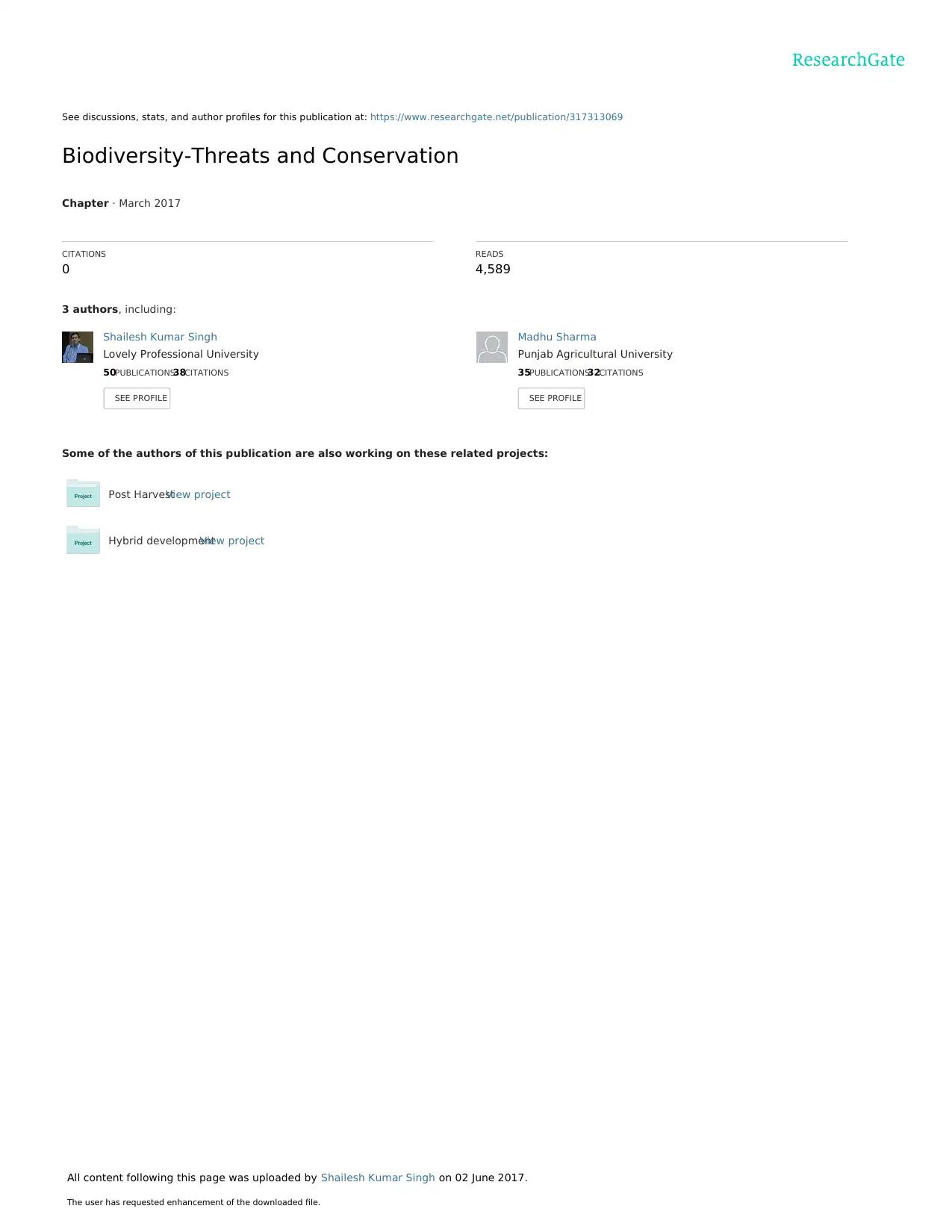
See discussions, stats, and author profiles for this publication at: https://www.researchgate.net/publication/317313069
Biodiversity-Threats and Conservation
Chapter · March 2017
CITATIONS
0
READS
4,589
3 authors, including:
Some of the authors of this publication are also working on these related projects:
Post HarvestView project
Hybrid developmentView project
Shailesh Kumar Singh
Lovely Professional University
50PUBLICATIONS38CITATIONS
SEE PROFILE
Madhu Sharma
Punjab Agricultural University
35PUBLICATIONS32CITATIONS
SEE PROFILE
All content following this page was uploaded by Shailesh Kumar Singh on 02 June 2017.
The user has requested enhancement of the downloaded file.
Biodiversity-Threats and Conservation
Chapter · March 2017
CITATIONS
0
READS
4,589
3 authors, including:
Some of the authors of this publication are also working on these related projects:
Post HarvestView project
Hybrid developmentView project
Shailesh Kumar Singh
Lovely Professional University
50PUBLICATIONS38CITATIONS
SEE PROFILE
Madhu Sharma
Punjab Agricultural University
35PUBLICATIONS32CITATIONS
SEE PROFILE
All content following this page was uploaded by Shailesh Kumar Singh on 02 June 2017.
The user has requested enhancement of the downloaded file.
Secure Best Marks with AI Grader
Need help grading? Try our AI Grader for instant feedback on your assignments.
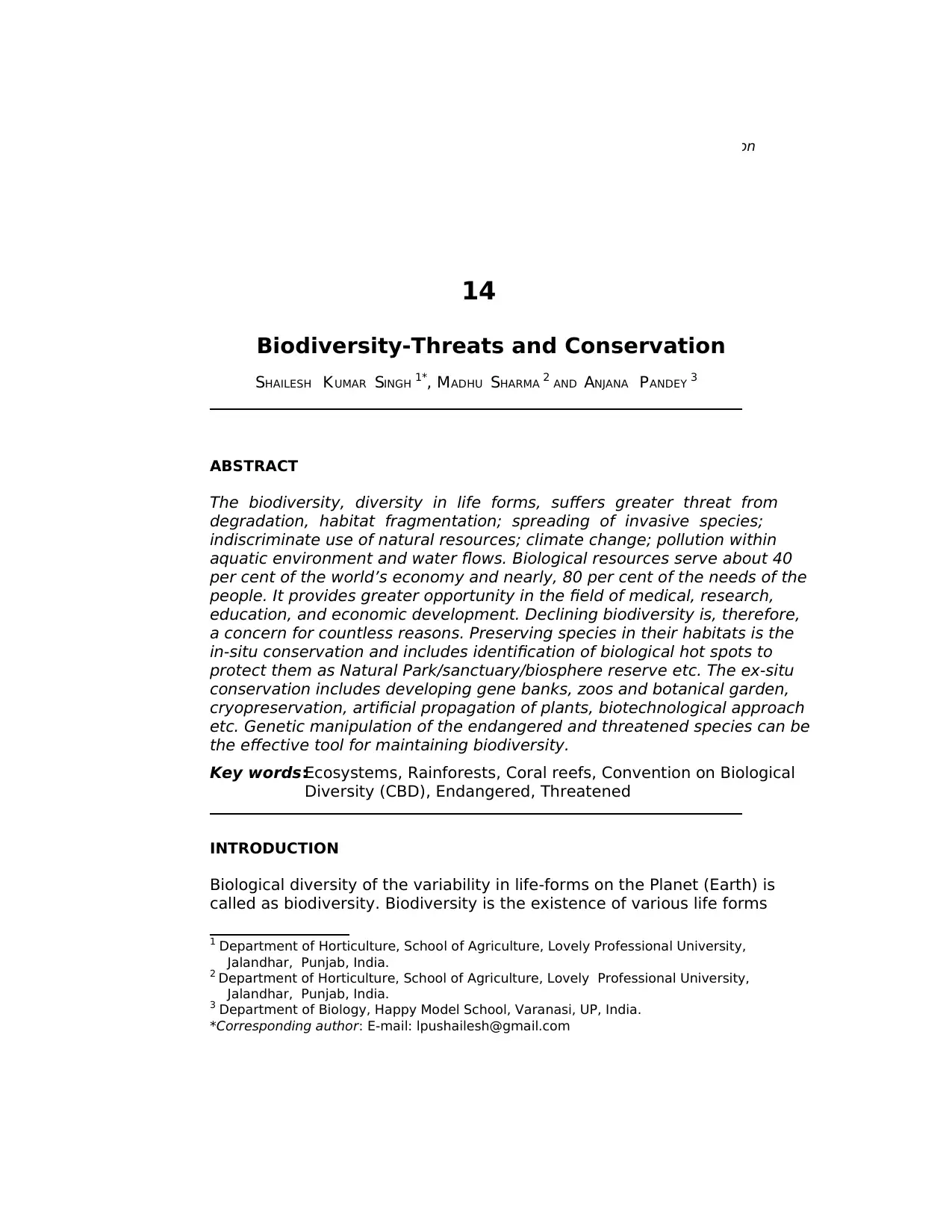
282 Environ. Sci. & Engg. Vol. 2:Biodiversity and Conservation
1 Department of Horticulture, School of Agriculture, Lovely Professional University,
Jalandhar, Punjab, India.
2 Department of Horticulture, School of Agriculture, Lovely Professional University,
Jalandhar, Punjab, India.
3 Department of Biology, Happy Model School, Varanasi, UP, India.
*Corresponding author: E-mail: lpushailesh@gmail.com
14
Biodiversity-Threats and Conservation
SHAILESH KUMAR SINGH 1*, MADHU SHARMA 2 AND ANJANA PANDEY 3
ABSTRACT
The biodiversity, diversity in life forms, suffers greater threat from
degradation, habitat fragmentation; spreading of invasive species;
indiscriminate use of natural resources; climate change; pollution within
aquatic environment and water flows. Biological resources serve about 40
per cent of the world’s economy and nearly, 80 per cent of the needs of the
people. It provides greater opportunity in the field of medical, research,
education, and economic development. Declining biodiversity is, therefore,
a concern for countless reasons. Preserving species in their habitats is the
in-situ conservation and includes identification of biological hot spots to
protect them as Natural Park/sanctuary/biosphere reserve etc. The ex-situ
conservation includes developing gene banks, zoos and botanical garden,
cryopreservation, artificial propagation of plants, biotechnological approach
etc. Genetic manipulation of the endangered and threatened species can be
the effective tool for maintaining biodiversity.
Key words:Ecosystems, Rainforests, Coral reefs, Convention on Biological
Diversity (CBD), Endangered, Threatened
INTRODUCTION
Biological diversity of the variability in life-forms on the Planet (Earth) is
called as biodiversity. Biodiversity is the existence of various life forms
1 Department of Horticulture, School of Agriculture, Lovely Professional University,
Jalandhar, Punjab, India.
2 Department of Horticulture, School of Agriculture, Lovely Professional University,
Jalandhar, Punjab, India.
3 Department of Biology, Happy Model School, Varanasi, UP, India.
*Corresponding author: E-mail: lpushailesh@gmail.com
14
Biodiversity-Threats and Conservation
SHAILESH KUMAR SINGH 1*, MADHU SHARMA 2 AND ANJANA PANDEY 3
ABSTRACT
The biodiversity, diversity in life forms, suffers greater threat from
degradation, habitat fragmentation; spreading of invasive species;
indiscriminate use of natural resources; climate change; pollution within
aquatic environment and water flows. Biological resources serve about 40
per cent of the world’s economy and nearly, 80 per cent of the needs of the
people. It provides greater opportunity in the field of medical, research,
education, and economic development. Declining biodiversity is, therefore,
a concern for countless reasons. Preserving species in their habitats is the
in-situ conservation and includes identification of biological hot spots to
protect them as Natural Park/sanctuary/biosphere reserve etc. The ex-situ
conservation includes developing gene banks, zoos and botanical garden,
cryopreservation, artificial propagation of plants, biotechnological approach
etc. Genetic manipulation of the endangered and threatened species can be
the effective tool for maintaining biodiversity.
Key words:Ecosystems, Rainforests, Coral reefs, Convention on Biological
Diversity (CBD), Endangered, Threatened
INTRODUCTION
Biological diversity of the variability in life-forms on the Planet (Earth) is
called as biodiversity. Biodiversity is the existence of various life forms
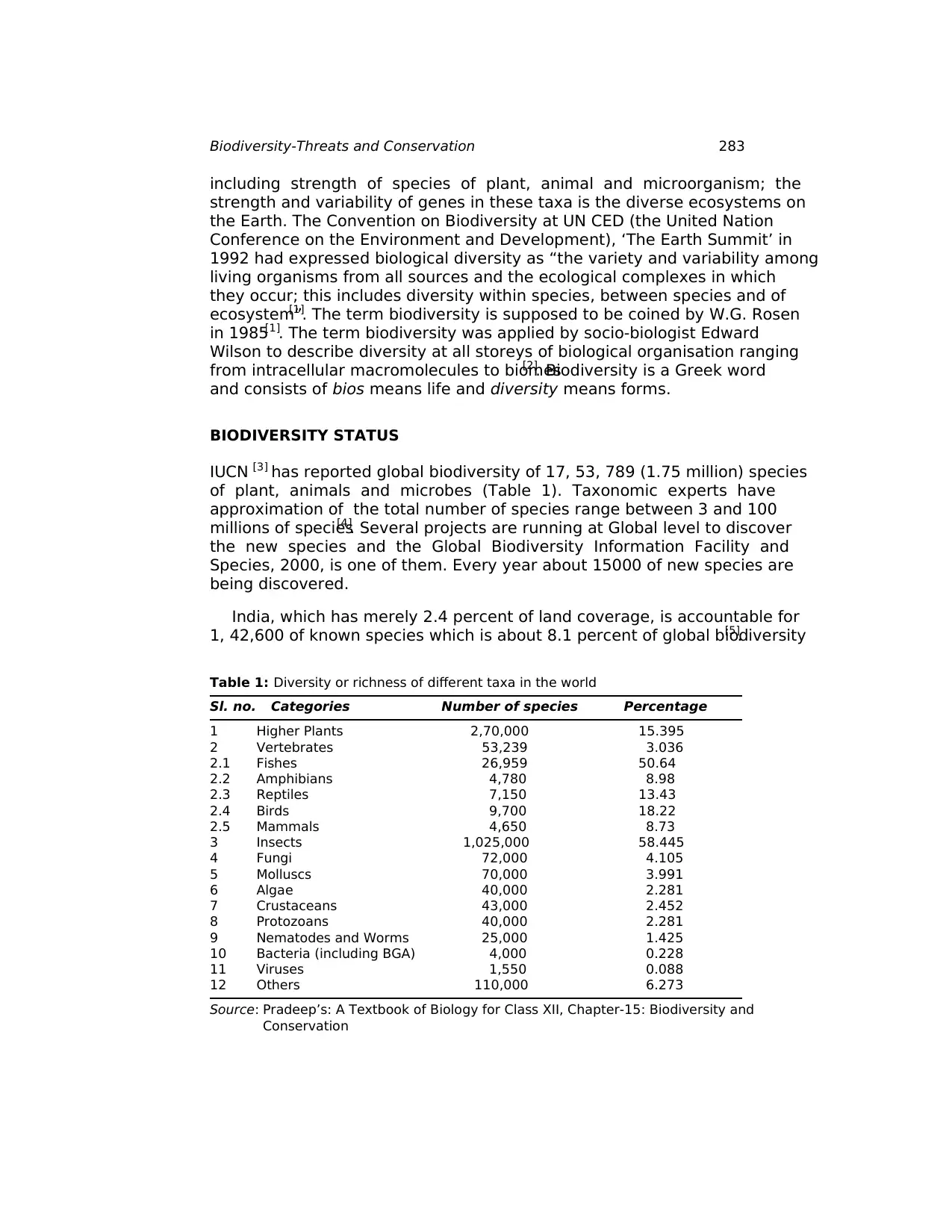
283Biodiversity-Threats and Conservation
including strength of species of plant, animal and microorganism; the
strength and variability of genes in these taxa is the diverse ecosystems on
the Earth. The Convention on Biodiversity at UN CED (the United Nation
Conference on the Environment and Development), ‘The Earth Summit’ in
1992 had expressed biological diversity as “the variety and variability among
living organisms from all sources and the ecological complexes in which
they occur; this includes diversity within species, between species and of
ecosystem”[1]
. The term biodiversity is supposed to be coined by W.G. Rosen
in 1985[1]. The term biodiversity was applied by socio-biologist Edward
Wilson to describe diversity at all storeys of biological organisation ranging
from intracellular macromolecules to biomes[2]
. Biodiversity is a Greek word
and consists of bios means life and diversity means forms.
BIODIVERSITY STATUS
IUCN [3] has reported global biodiversity of 17, 53, 789 (1.75 million) species
of plant, animals and microbes (Table 1). Taxonomic experts have
approximation of the total number of species range between 3 and 100
millions of species[4]
. Several projects are running at Global level to discover
the new species and the Global Biodiversity Information Facility and
Species, 2000, is one of them. Every year about 15000 of new species are
being discovered.
India, which has merely 2.4 percent of land coverage, is accountable for
1, 42,600 of known species which is about 8.1 percent of global biodiversity[5]
.
Table 1: Diversity or richness of different taxa in the world
Sl. no. Categories Number of species Percentage
1 Higher Plants 2,70,000 15.395
2 Vertebrates 53,239 3.036
2.1 Fishes 26,959 50.64
2.2 Amphibians 4,780 8.98
2.3 Reptiles 7,150 13.43
2.4 Birds 9,700 18.22
2.5 Mammals 4,650 8.73
3 Insects 1,025,000 58.445
4 Fungi 72,000 4.105
5 Molluscs 70,000 3.991
6 Algae 40,000 2.281
7 Crustaceans 43,000 2.452
8 Protozoans 40,000 2.281
9 Nematodes and Worms 25,000 1.425
10 Bacteria (including BGA) 4,000 0.228
11 Viruses 1,550 0.088
12 Others 110,000 6.273
Source: Pradeep’s: A Textbook of Biology for Class XII, Chapter-15: Biodiversity and
Conservation
including strength of species of plant, animal and microorganism; the
strength and variability of genes in these taxa is the diverse ecosystems on
the Earth. The Convention on Biodiversity at UN CED (the United Nation
Conference on the Environment and Development), ‘The Earth Summit’ in
1992 had expressed biological diversity as “the variety and variability among
living organisms from all sources and the ecological complexes in which
they occur; this includes diversity within species, between species and of
ecosystem”[1]
. The term biodiversity is supposed to be coined by W.G. Rosen
in 1985[1]. The term biodiversity was applied by socio-biologist Edward
Wilson to describe diversity at all storeys of biological organisation ranging
from intracellular macromolecules to biomes[2]
. Biodiversity is a Greek word
and consists of bios means life and diversity means forms.
BIODIVERSITY STATUS
IUCN [3] has reported global biodiversity of 17, 53, 789 (1.75 million) species
of plant, animals and microbes (Table 1). Taxonomic experts have
approximation of the total number of species range between 3 and 100
millions of species[4]
. Several projects are running at Global level to discover
the new species and the Global Biodiversity Information Facility and
Species, 2000, is one of them. Every year about 15000 of new species are
being discovered.
India, which has merely 2.4 percent of land coverage, is accountable for
1, 42,600 of known species which is about 8.1 percent of global biodiversity[5]
.
Table 1: Diversity or richness of different taxa in the world
Sl. no. Categories Number of species Percentage
1 Higher Plants 2,70,000 15.395
2 Vertebrates 53,239 3.036
2.1 Fishes 26,959 50.64
2.2 Amphibians 4,780 8.98
2.3 Reptiles 7,150 13.43
2.4 Birds 9,700 18.22
2.5 Mammals 4,650 8.73
3 Insects 1,025,000 58.445
4 Fungi 72,000 4.105
5 Molluscs 70,000 3.991
6 Algae 40,000 2.281
7 Crustaceans 43,000 2.452
8 Protozoans 40,000 2.281
9 Nematodes and Worms 25,000 1.425
10 Bacteria (including BGA) 4,000 0.228
11 Viruses 1,550 0.088
12 Others 110,000 6.273
Source: Pradeep’s: A Textbook of Biology for Class XII, Chapter-15: Biodiversity and
Conservation
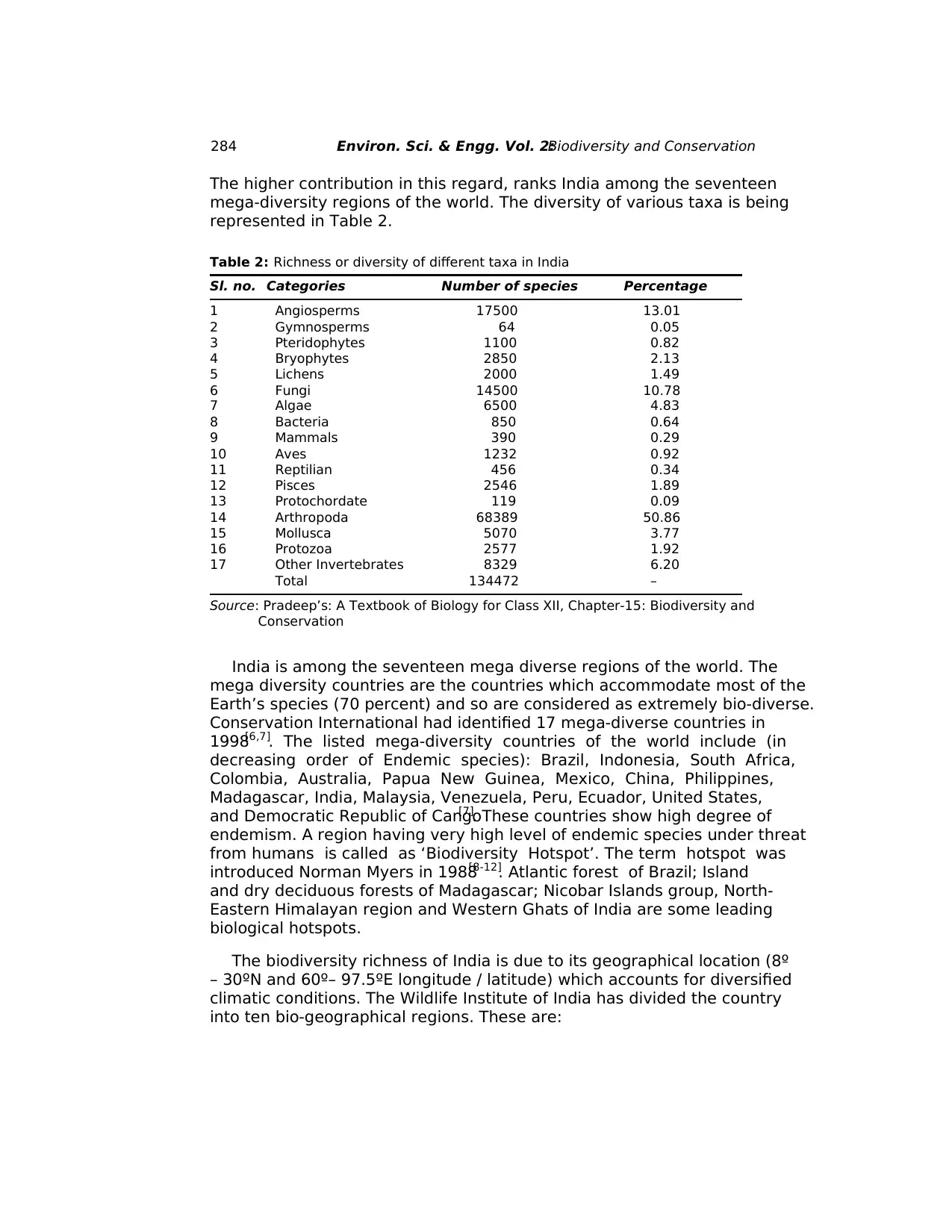
284 Environ. Sci. & Engg. Vol. 2:Biodiversity and Conservation
The higher contribution in this regard, ranks India among the seventeen
mega-diversity regions of the world. The diversity of various taxa is being
represented in Table 2.
Table 2: Richness or diversity of different taxa in India
Sl. no. Categories Number of species Percentage
1 Angiosperms 17500 13.01
2 Gymnosperms 64 0.05
3 Pteridophytes 1100 0.82
4 Bryophytes 2850 2.13
5 Lichens 2000 1.49
6 Fungi 14500 10.78
7 Algae 6500 4.83
8 Bacteria 850 0.64
9 Mammals 390 0.29
10 Aves 1232 0.92
11 Reptilian 456 0.34
12 Pisces 2546 1.89
13 Protochordate 119 0.09
14 Arthropoda 68389 50.86
15 Mollusca 5070 3.77
16 Protozoa 2577 1.92
17 Other Invertebrates 8329 6.20
Total 134472 –
Source: Pradeep’s: A Textbook of Biology for Class XII, Chapter-15: Biodiversity and
Conservation
India is among the seventeen mega diverse regions of the world. The
mega diversity countries are the countries which accommodate most of the
Earth’s species (70 percent) and so are considered as extremely bio-diverse.
Conservation International had identified 17 mega-diverse countries in
1998[6,7]. The listed mega-diversity countries of the world include (in
decreasing order of Endemic species): Brazil, Indonesia, South Africa,
Colombia, Australia, Papua New Guinea, Mexico, China, Philippines,
Madagascar, India, Malaysia, Venezuela, Peru, Ecuador, United States,
and Democratic Republic of Cango[7]. These countries show high degree of
endemism. A region having very high level of endemic species under threat
from humans is called as ‘Biodiversity Hotspot’. The term hotspot was
introduced Norman Myers in 1988[8-12]
. Atlantic forest of Brazil; Island
and dry deciduous forests of Madagascar; Nicobar Islands group, North-
Eastern Himalayan region and Western Ghats of India are some leading
biological hotspots.
The biodiversity richness of India is due to its geographical location (8º
– 30ºN and 60º– 97.5ºE longitude / latitude) which accounts for diversified
climatic conditions. The Wildlife Institute of India has divided the country
into ten bio-geographical regions. These are:
The higher contribution in this regard, ranks India among the seventeen
mega-diversity regions of the world. The diversity of various taxa is being
represented in Table 2.
Table 2: Richness or diversity of different taxa in India
Sl. no. Categories Number of species Percentage
1 Angiosperms 17500 13.01
2 Gymnosperms 64 0.05
3 Pteridophytes 1100 0.82
4 Bryophytes 2850 2.13
5 Lichens 2000 1.49
6 Fungi 14500 10.78
7 Algae 6500 4.83
8 Bacteria 850 0.64
9 Mammals 390 0.29
10 Aves 1232 0.92
11 Reptilian 456 0.34
12 Pisces 2546 1.89
13 Protochordate 119 0.09
14 Arthropoda 68389 50.86
15 Mollusca 5070 3.77
16 Protozoa 2577 1.92
17 Other Invertebrates 8329 6.20
Total 134472 –
Source: Pradeep’s: A Textbook of Biology for Class XII, Chapter-15: Biodiversity and
Conservation
India is among the seventeen mega diverse regions of the world. The
mega diversity countries are the countries which accommodate most of the
Earth’s species (70 percent) and so are considered as extremely bio-diverse.
Conservation International had identified 17 mega-diverse countries in
1998[6,7]. The listed mega-diversity countries of the world include (in
decreasing order of Endemic species): Brazil, Indonesia, South Africa,
Colombia, Australia, Papua New Guinea, Mexico, China, Philippines,
Madagascar, India, Malaysia, Venezuela, Peru, Ecuador, United States,
and Democratic Republic of Cango[7]. These countries show high degree of
endemism. A region having very high level of endemic species under threat
from humans is called as ‘Biodiversity Hotspot’. The term hotspot was
introduced Norman Myers in 1988[8-12]
. Atlantic forest of Brazil; Island
and dry deciduous forests of Madagascar; Nicobar Islands group, North-
Eastern Himalayan region and Western Ghats of India are some leading
biological hotspots.
The biodiversity richness of India is due to its geographical location (8º
– 30ºN and 60º– 97.5ºE longitude / latitude) which accounts for diversified
climatic conditions. The Wildlife Institute of India has divided the country
into ten bio-geographical regions. These are:
Secure Best Marks with AI Grader
Need help grading? Try our AI Grader for instant feedback on your assignments.
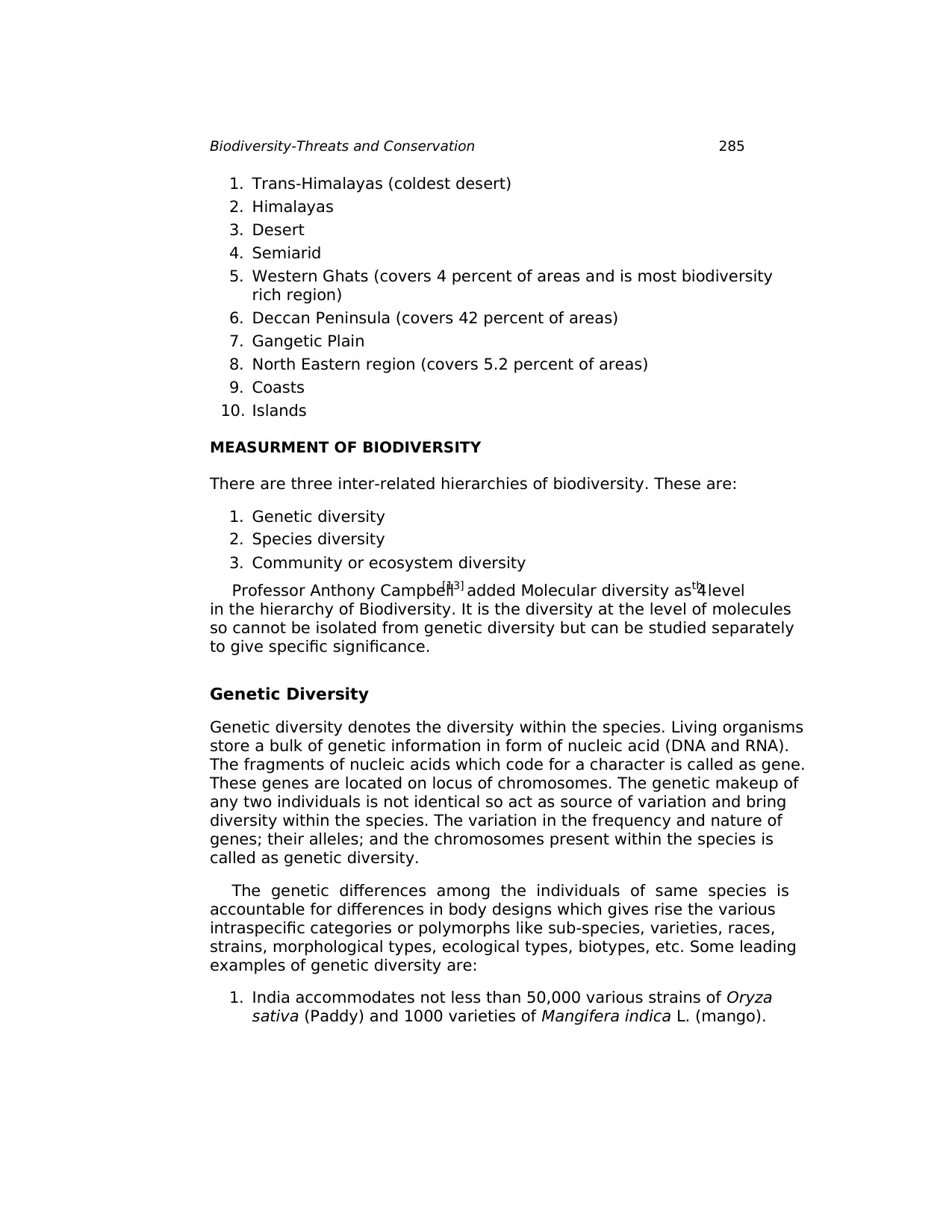
285Biodiversity-Threats and Conservation
1. Trans-Himalayas (coldest desert)
2. Himalayas
3. Desert
4. Semiarid
5. Western Ghats (covers 4 percent of areas and is most biodiversity
rich region)
6. Deccan Peninsula (covers 42 percent of areas)
7. Gangetic Plain
8. North Eastern region (covers 5.2 percent of areas)
9. Coasts
10. Islands
MEASURMENT OF BIODIVERSITY
There are three inter-related hierarchies of biodiversity. These are:
1. Genetic diversity
2. Species diversity
3. Community or ecosystem diversity
Professor Anthony Campbell[13] added Molecular diversity as 4th level
in the hierarchy of Biodiversity. It is the diversity at the level of molecules
so cannot be isolated from genetic diversity but can be studied separately
to give specific significance.
Genetic Diversity
Genetic diversity denotes the diversity within the species. Living organisms
store a bulk of genetic information in form of nucleic acid (DNA and RNA).
The fragments of nucleic acids which code for a character is called as gene.
These genes are located on locus of chromosomes. The genetic makeup of
any two individuals is not identical so act as source of variation and bring
diversity within the species. The variation in the frequency and nature of
genes; their alleles; and the chromosomes present within the species is
called as genetic diversity.
The genetic differences among the individuals of same species is
accountable for differences in body designs which gives rise the various
intraspecific categories or polymorphs like sub-species, varieties, races,
strains, morphological types, ecological types, biotypes, etc. Some leading
examples of genetic diversity are:
1. India accommodates not less than 50,000 various strains of Oryza
sativa (Paddy) and 1000 varieties of Mangifera indica L. (mango).
1. Trans-Himalayas (coldest desert)
2. Himalayas
3. Desert
4. Semiarid
5. Western Ghats (covers 4 percent of areas and is most biodiversity
rich region)
6. Deccan Peninsula (covers 42 percent of areas)
7. Gangetic Plain
8. North Eastern region (covers 5.2 percent of areas)
9. Coasts
10. Islands
MEASURMENT OF BIODIVERSITY
There are three inter-related hierarchies of biodiversity. These are:
1. Genetic diversity
2. Species diversity
3. Community or ecosystem diversity
Professor Anthony Campbell[13] added Molecular diversity as 4th level
in the hierarchy of Biodiversity. It is the diversity at the level of molecules
so cannot be isolated from genetic diversity but can be studied separately
to give specific significance.
Genetic Diversity
Genetic diversity denotes the diversity within the species. Living organisms
store a bulk of genetic information in form of nucleic acid (DNA and RNA).
The fragments of nucleic acids which code for a character is called as gene.
These genes are located on locus of chromosomes. The genetic makeup of
any two individuals is not identical so act as source of variation and bring
diversity within the species. The variation in the frequency and nature of
genes; their alleles; and the chromosomes present within the species is
called as genetic diversity.
The genetic differences among the individuals of same species is
accountable for differences in body designs which gives rise the various
intraspecific categories or polymorphs like sub-species, varieties, races,
strains, morphological types, ecological types, biotypes, etc. Some leading
examples of genetic diversity are:
1. India accommodates not less than 50,000 various strains of Oryza
sativa (Paddy) and 1000 varieties of Mangifera indica L. (mango).
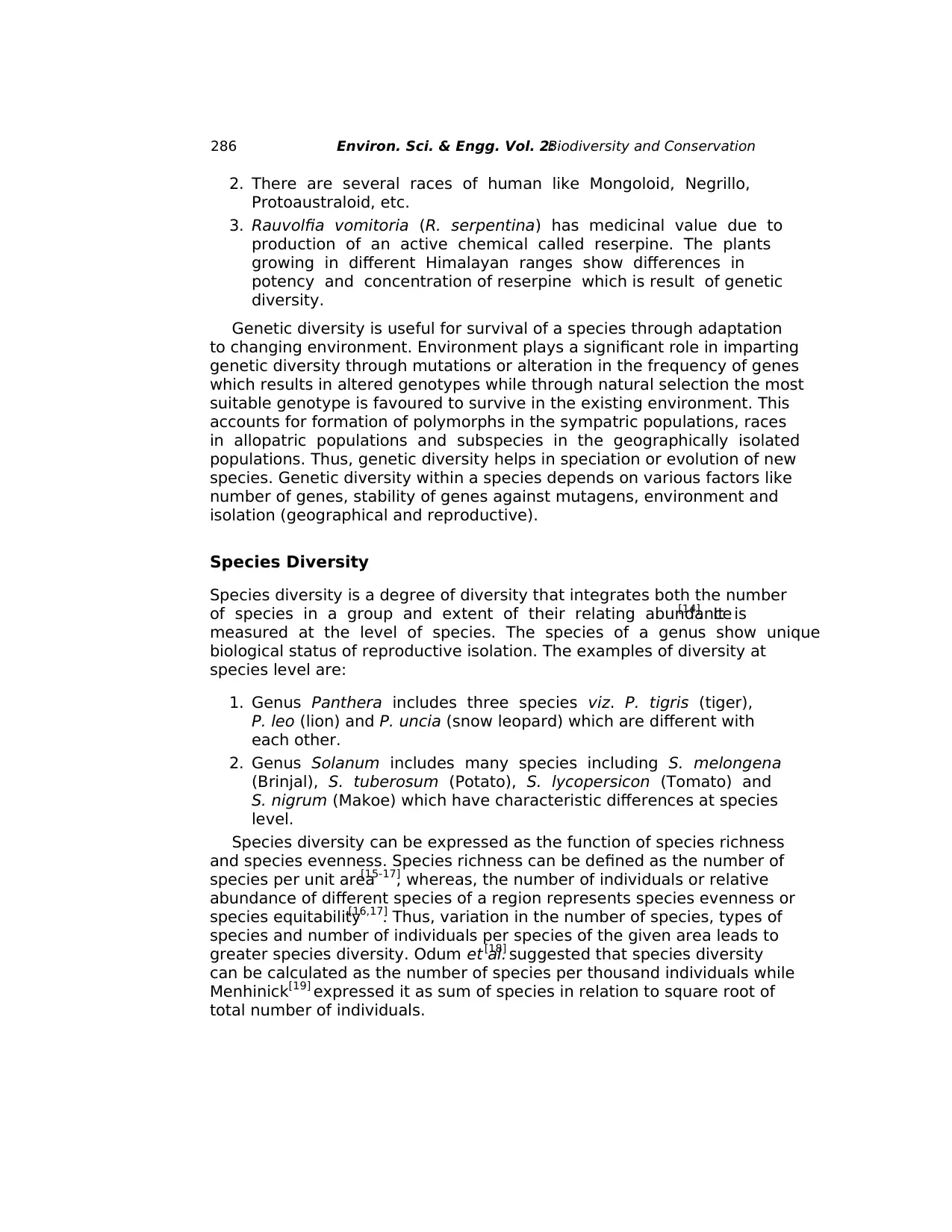
286 Environ. Sci. & Engg. Vol. 2:Biodiversity and Conservation
2. There are several races of human like Mongoloid, Negrillo,
Protoaustraloid, etc.
3. Rauvolfia vomitoria (R. serpentina) has medicinal value due to
production of an active chemical called reserpine. The plants
growing in different Himalayan ranges show differences in
potency and concentration of reserpine which is result of genetic
diversity.
Genetic diversity is useful for survival of a species through adaptation
to changing environment. Environment plays a significant role in imparting
genetic diversity through mutations or alteration in the frequency of genes
which results in altered genotypes while through natural selection the most
suitable genotype is favoured to survive in the existing environment. This
accounts for formation of polymorphs in the sympatric populations, races
in allopatric populations and subspecies in the geographically isolated
populations. Thus, genetic diversity helps in speciation or evolution of new
species. Genetic diversity within a species depends on various factors like
number of genes, stability of genes against mutagens, environment and
isolation (geographical and reproductive).
Species Diversity
Species diversity is a degree of diversity that integrates both the number
of species in a group and extent of their relating abundance[14]. It is
measured at the level of species. The species of a genus show unique
biological status of reproductive isolation. The examples of diversity at
species level are:
1. Genus Panthera includes three species viz. P. tigris (tiger),
P. leo (lion) and P. uncia (snow leopard) which are different with
each other.
2. Genus Solanum includes many species including S. melongena
(Brinjal), S. tuberosum (Potato), S. lycopersicon (Tomato) and
S. nigrum (Makoe) which have characteristic differences at species
level.
Species diversity can be expressed as the function of species richness
and species evenness. Species richness can be defined as the number of
species per unit area[15-17]
, whereas, the number of individuals or relative
abundance of different species of a region represents species evenness or
species equitability[16,17]
. Thus, variation in the number of species, types of
species and number of individuals per species of the given area leads to
greater species diversity. Odum et al.[18] suggested that species diversity
can be calculated as the number of species per thousand individuals while
Menhinick[19] expressed it as sum of species in relation to square root of
total number of individuals.
2. There are several races of human like Mongoloid, Negrillo,
Protoaustraloid, etc.
3. Rauvolfia vomitoria (R. serpentina) has medicinal value due to
production of an active chemical called reserpine. The plants
growing in different Himalayan ranges show differences in
potency and concentration of reserpine which is result of genetic
diversity.
Genetic diversity is useful for survival of a species through adaptation
to changing environment. Environment plays a significant role in imparting
genetic diversity through mutations or alteration in the frequency of genes
which results in altered genotypes while through natural selection the most
suitable genotype is favoured to survive in the existing environment. This
accounts for formation of polymorphs in the sympatric populations, races
in allopatric populations and subspecies in the geographically isolated
populations. Thus, genetic diversity helps in speciation or evolution of new
species. Genetic diversity within a species depends on various factors like
number of genes, stability of genes against mutagens, environment and
isolation (geographical and reproductive).
Species Diversity
Species diversity is a degree of diversity that integrates both the number
of species in a group and extent of their relating abundance[14]. It is
measured at the level of species. The species of a genus show unique
biological status of reproductive isolation. The examples of diversity at
species level are:
1. Genus Panthera includes three species viz. P. tigris (tiger),
P. leo (lion) and P. uncia (snow leopard) which are different with
each other.
2. Genus Solanum includes many species including S. melongena
(Brinjal), S. tuberosum (Potato), S. lycopersicon (Tomato) and
S. nigrum (Makoe) which have characteristic differences at species
level.
Species diversity can be expressed as the function of species richness
and species evenness. Species richness can be defined as the number of
species per unit area[15-17]
, whereas, the number of individuals or relative
abundance of different species of a region represents species evenness or
species equitability[16,17]
. Thus, variation in the number of species, types of
species and number of individuals per species of the given area leads to
greater species diversity. Odum et al.[18] suggested that species diversity
can be calculated as the number of species per thousand individuals while
Menhinick[19] expressed it as sum of species in relation to square root of
total number of individuals.
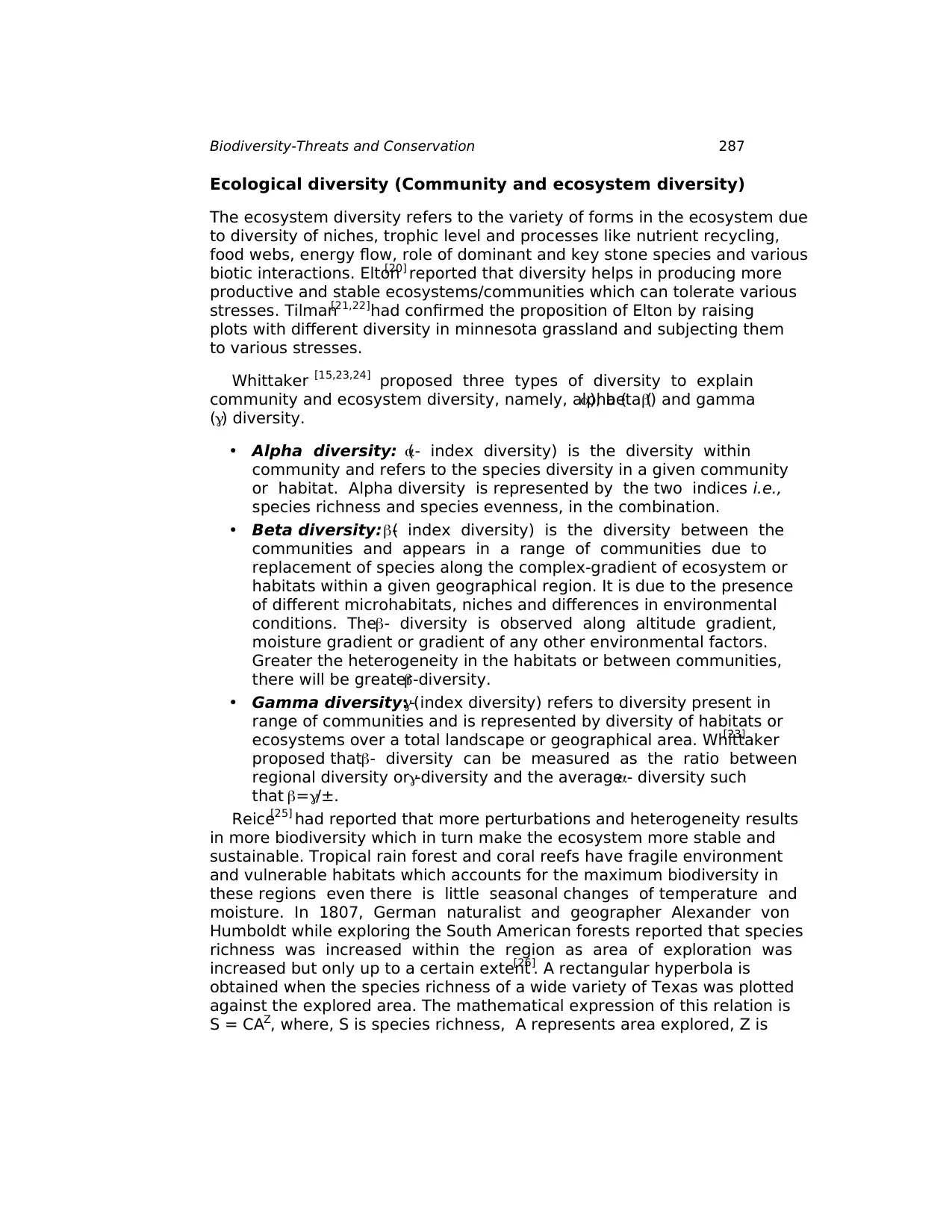
287Biodiversity-Threats and Conservation
Ecological diversity (Community and ecosystem diversity)
The ecosystem diversity refers to the variety of forms in the ecosystem due
to diversity of niches, trophic level and processes like nutrient recycling,
food webs, energy flow, role of dominant and key stone species and various
biotic interactions. Elton[20] reported that diversity helps in producing more
productive and stable ecosystems/communities which can tolerate various
stresses. Tilman[21,22] had confirmed the proposition of Elton by raising
plots with different diversity in minnesota grassland and subjecting them
to various stresses.
Whittaker [15,23,24] proposed three types of diversity to explain
community and ecosystem diversity, namely, alpha (), beta () and gamma
() diversity.
• Alpha diversity: (- index diversity) is the diversity within
community and refers to the species diversity in a given community
or habitat. Alpha diversity is represented by the two indices i.e.,
species richness and species evenness, in the combination.
• Beta diversity: (- index diversity) is the diversity between the
communities and appears in a range of communities due to
replacement of species along the complex-gradient of ecosystem or
habitats within a given geographical region. It is due to the presence
of different microhabitats, niches and differences in environmental
conditions. The- diversity is observed along altitude gradient,
moisture gradient or gradient of any other environmental factors.
Greater the heterogeneity in the habitats or between communities,
there will be greater-diversity.
• Gamma diversity: (- index diversity) refers to diversity present in
range of communities and is represented by diversity of habitats or
ecosystems over a total landscape or geographical area. Whittaker[23]
proposed that- diversity can be measured as the ratio between
regional diversity or-diversity and the average- diversity such
that =/±.
Reice[25] had reported that more perturbations and heterogeneity results
in more biodiversity which in turn make the ecosystem more stable and
sustainable. Tropical rain forest and coral reefs have fragile environment
and vulnerable habitats which accounts for the maximum biodiversity in
these regions even there is little seasonal changes of temperature and
moisture. In 1807, German naturalist and geographer Alexander von
Humboldt while exploring the South American forests reported that species
richness was increased within the region as area of exploration was
increased but only up to a certain extent[26]
. A rectangular hyperbola is
obtained when the species richness of a wide variety of Texas was plotted
against the explored area. The mathematical expression of this relation is
S = CAZ, where, S is species richness, A represents area explored, Z is
Ecological diversity (Community and ecosystem diversity)
The ecosystem diversity refers to the variety of forms in the ecosystem due
to diversity of niches, trophic level and processes like nutrient recycling,
food webs, energy flow, role of dominant and key stone species and various
biotic interactions. Elton[20] reported that diversity helps in producing more
productive and stable ecosystems/communities which can tolerate various
stresses. Tilman[21,22] had confirmed the proposition of Elton by raising
plots with different diversity in minnesota grassland and subjecting them
to various stresses.
Whittaker [15,23,24] proposed three types of diversity to explain
community and ecosystem diversity, namely, alpha (), beta () and gamma
() diversity.
• Alpha diversity: (- index diversity) is the diversity within
community and refers to the species diversity in a given community
or habitat. Alpha diversity is represented by the two indices i.e.,
species richness and species evenness, in the combination.
• Beta diversity: (- index diversity) is the diversity between the
communities and appears in a range of communities due to
replacement of species along the complex-gradient of ecosystem or
habitats within a given geographical region. It is due to the presence
of different microhabitats, niches and differences in environmental
conditions. The- diversity is observed along altitude gradient,
moisture gradient or gradient of any other environmental factors.
Greater the heterogeneity in the habitats or between communities,
there will be greater-diversity.
• Gamma diversity: (- index diversity) refers to diversity present in
range of communities and is represented by diversity of habitats or
ecosystems over a total landscape or geographical area. Whittaker[23]
proposed that- diversity can be measured as the ratio between
regional diversity or-diversity and the average- diversity such
that =/±.
Reice[25] had reported that more perturbations and heterogeneity results
in more biodiversity which in turn make the ecosystem more stable and
sustainable. Tropical rain forest and coral reefs have fragile environment
and vulnerable habitats which accounts for the maximum biodiversity in
these regions even there is little seasonal changes of temperature and
moisture. In 1807, German naturalist and geographer Alexander von
Humboldt while exploring the South American forests reported that species
richness was increased within the region as area of exploration was
increased but only up to a certain extent[26]
. A rectangular hyperbola is
obtained when the species richness of a wide variety of Texas was plotted
against the explored area. The mathematical expression of this relation is
S = CAZ, where, S is species richness, A represents area explored, Z is
Paraphrase This Document
Need a fresh take? Get an instant paraphrase of this document with our AI Paraphraser
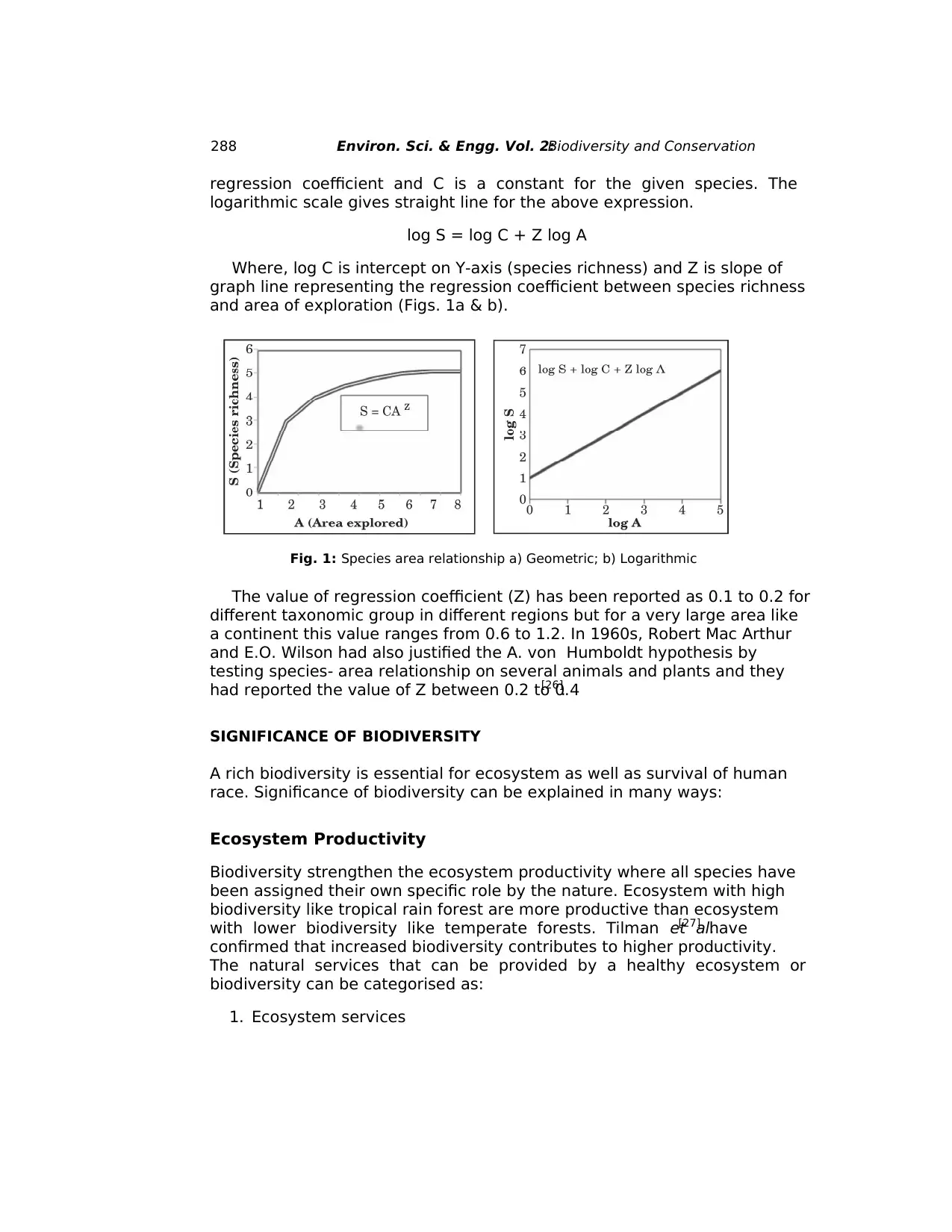
288 Environ. Sci. & Engg. Vol. 2:Biodiversity and Conservation
regression coefficient and C is a constant for the given species. The
logarithmic scale gives straight line for the above expression.
log S = log C + Z log A
Where, log C is intercept on Y-axis (species richness) and Z is slope of
graph line representing the regression coefficient between species richness
and area of exploration (Figs. 1a & b).
The value of regression coefficient (Z) has been reported as 0.1 to 0.2 for
different taxonomic group in different regions but for a very large area like
a continent this value ranges from 0.6 to 1.2. In 1960s, Robert Mac Arthur
and E.O. Wilson had also justified the A. von Humboldt hypothesis by
testing species- area relationship on several animals and plants and they
had reported the value of Z between 0.2 to 0.4[26]
.
SIGNIFICANCE OF BIODIVERSITY
A rich biodiversity is essential for ecosystem as well as survival of human
race. Significance of biodiversity can be explained in many ways:
Ecosystem Productivity
Biodiversity strengthen the ecosystem productivity where all species have
been assigned their own specific role by the nature. Ecosystem with high
biodiversity like tropical rain forest are more productive than ecosystem
with lower biodiversity like temperate forests. Tilman et al.[27] have
confirmed that increased biodiversity contributes to higher productivity.
The natural services that can be provided by a healthy ecosystem or
biodiversity can be categorised as:
1. Ecosystem services
Fig. 1: Species area relationship a) Geometric; b) Logarithmic
regression coefficient and C is a constant for the given species. The
logarithmic scale gives straight line for the above expression.
log S = log C + Z log A
Where, log C is intercept on Y-axis (species richness) and Z is slope of
graph line representing the regression coefficient between species richness
and area of exploration (Figs. 1a & b).
The value of regression coefficient (Z) has been reported as 0.1 to 0.2 for
different taxonomic group in different regions but for a very large area like
a continent this value ranges from 0.6 to 1.2. In 1960s, Robert Mac Arthur
and E.O. Wilson had also justified the A. von Humboldt hypothesis by
testing species- area relationship on several animals and plants and they
had reported the value of Z between 0.2 to 0.4[26]
.
SIGNIFICANCE OF BIODIVERSITY
A rich biodiversity is essential for ecosystem as well as survival of human
race. Significance of biodiversity can be explained in many ways:
Ecosystem Productivity
Biodiversity strengthen the ecosystem productivity where all species have
been assigned their own specific role by the nature. Ecosystem with high
biodiversity like tropical rain forest are more productive than ecosystem
with lower biodiversity like temperate forests. Tilman et al.[27] have
confirmed that increased biodiversity contributes to higher productivity.
The natural services that can be provided by a healthy ecosystem or
biodiversity can be categorised as:
1. Ecosystem services
Fig. 1: Species area relationship a) Geometric; b) Logarithmic
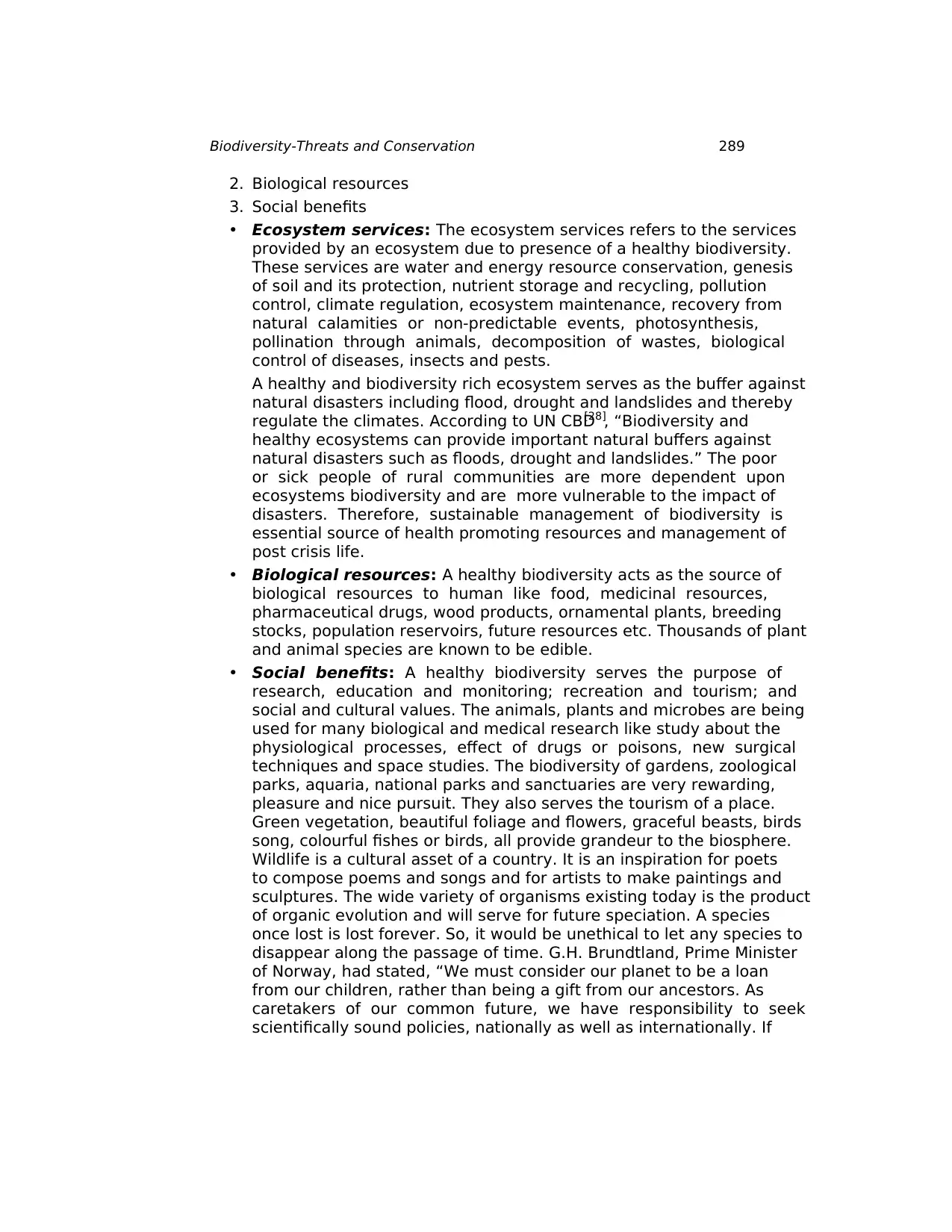
289Biodiversity-Threats and Conservation
2. Biological resources
3. Social benefits
• Ecosystem services: The ecosystem services refers to the services
provided by an ecosystem due to presence of a healthy biodiversity.
These services are water and energy resource conservation, genesis
of soil and its protection, nutrient storage and recycling, pollution
control, climate regulation, ecosystem maintenance, recovery from
natural calamities or non-predictable events, photosynthesis,
pollination through animals, decomposition of wastes, biological
control of diseases, insects and pests.
A healthy and biodiversity rich ecosystem serves as the buffer against
natural disasters including flood, drought and landslides and thereby
regulate the climates. According to UN CBD[28]
, “Biodiversity and
healthy ecosystems can provide important natural buffers against
natural disasters such as floods, drought and landslides.” The poor
or sick people of rural communities are more dependent upon
ecosystems biodiversity and are more vulnerable to the impact of
disasters. Therefore, sustainable management of biodiversity is
essential source of health promoting resources and management of
post crisis life.
• Biological resources: A healthy biodiversity acts as the source of
biological resources to human like food, medicinal resources,
pharmaceutical drugs, wood products, ornamental plants, breeding
stocks, population reservoirs, future resources etc. Thousands of plant
and animal species are known to be edible.
• Social benefits: A healthy biodiversity serves the purpose of
research, education and monitoring; recreation and tourism; and
social and cultural values. The animals, plants and microbes are being
used for many biological and medical research like study about the
physiological processes, effect of drugs or poisons, new surgical
techniques and space studies. The biodiversity of gardens, zoological
parks, aquaria, national parks and sanctuaries are very rewarding,
pleasure and nice pursuit. They also serves the tourism of a place.
Green vegetation, beautiful foliage and flowers, graceful beasts, birds
song, colourful fishes or birds, all provide grandeur to the biosphere.
Wildlife is a cultural asset of a country. It is an inspiration for poets
to compose poems and songs and for artists to make paintings and
sculptures. The wide variety of organisms existing today is the product
of organic evolution and will serve for future speciation. A species
once lost is lost forever. So, it would be unethical to let any species to
disappear along the passage of time. G.H. Brundtland, Prime Minister
of Norway, had stated, “We must consider our planet to be a loan
from our children, rather than being a gift from our ancestors. As
caretakers of our common future, we have responsibility to seek
scientifically sound policies, nationally as well as internationally. If
2. Biological resources
3. Social benefits
• Ecosystem services: The ecosystem services refers to the services
provided by an ecosystem due to presence of a healthy biodiversity.
These services are water and energy resource conservation, genesis
of soil and its protection, nutrient storage and recycling, pollution
control, climate regulation, ecosystem maintenance, recovery from
natural calamities or non-predictable events, photosynthesis,
pollination through animals, decomposition of wastes, biological
control of diseases, insects and pests.
A healthy and biodiversity rich ecosystem serves as the buffer against
natural disasters including flood, drought and landslides and thereby
regulate the climates. According to UN CBD[28]
, “Biodiversity and
healthy ecosystems can provide important natural buffers against
natural disasters such as floods, drought and landslides.” The poor
or sick people of rural communities are more dependent upon
ecosystems biodiversity and are more vulnerable to the impact of
disasters. Therefore, sustainable management of biodiversity is
essential source of health promoting resources and management of
post crisis life.
• Biological resources: A healthy biodiversity acts as the source of
biological resources to human like food, medicinal resources,
pharmaceutical drugs, wood products, ornamental plants, breeding
stocks, population reservoirs, future resources etc. Thousands of plant
and animal species are known to be edible.
• Social benefits: A healthy biodiversity serves the purpose of
research, education and monitoring; recreation and tourism; and
social and cultural values. The animals, plants and microbes are being
used for many biological and medical research like study about the
physiological processes, effect of drugs or poisons, new surgical
techniques and space studies. The biodiversity of gardens, zoological
parks, aquaria, national parks and sanctuaries are very rewarding,
pleasure and nice pursuit. They also serves the tourism of a place.
Green vegetation, beautiful foliage and flowers, graceful beasts, birds
song, colourful fishes or birds, all provide grandeur to the biosphere.
Wildlife is a cultural asset of a country. It is an inspiration for poets
to compose poems and songs and for artists to make paintings and
sculptures. The wide variety of organisms existing today is the product
of organic evolution and will serve for future speciation. A species
once lost is lost forever. So, it would be unethical to let any species to
disappear along the passage of time. G.H. Brundtland, Prime Minister
of Norway, had stated, “We must consider our planet to be a loan
from our children, rather than being a gift from our ancestors. As
caretakers of our common future, we have responsibility to seek
scientifically sound policies, nationally as well as internationally. If
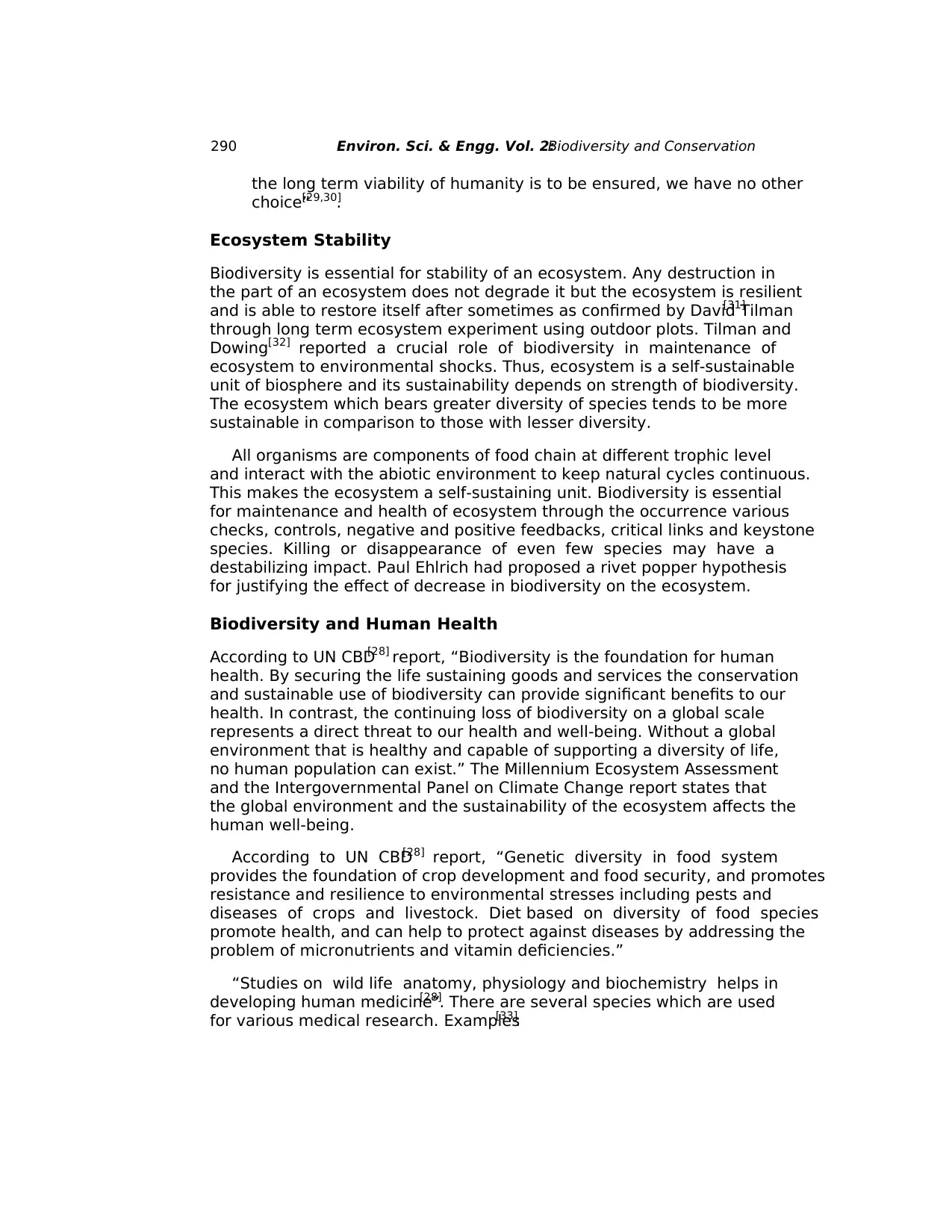
290 Environ. Sci. & Engg. Vol. 2:Biodiversity and Conservation
the long term viability of humanity is to be ensured, we have no other
choice”[29,30]
.
Ecosystem Stability
Biodiversity is essential for stability of an ecosystem. Any destruction in
the part of an ecosystem does not degrade it but the ecosystem is resilient
and is able to restore itself after sometimes as confirmed by David Tilman[31]
through long term ecosystem experiment using outdoor plots. Tilman and
Dowing[32] reported a crucial role of biodiversity in maintenance of
ecosystem to environmental shocks. Thus, ecosystem is a self-sustainable
unit of biosphere and its sustainability depends on strength of biodiversity.
The ecosystem which bears greater diversity of species tends to be more
sustainable in comparison to those with lesser diversity.
All organisms are components of food chain at different trophic level
and interact with the abiotic environment to keep natural cycles continuous.
This makes the ecosystem a self-sustaining unit. Biodiversity is essential
for maintenance and health of ecosystem through the occurrence various
checks, controls, negative and positive feedbacks, critical links and keystone
species. Killing or disappearance of even few species may have a
destabilizing impact. Paul Ehlrich had proposed a rivet popper hypothesis
for justifying the effect of decrease in biodiversity on the ecosystem.
Biodiversity and Human Health
According to UN CBD[28] report, “Biodiversity is the foundation for human
health. By securing the life sustaining goods and services the conservation
and sustainable use of biodiversity can provide significant benefits to our
health. In contrast, the continuing loss of biodiversity on a global scale
represents a direct threat to our health and well-being. Without a global
environment that is healthy and capable of supporting a diversity of life,
no human population can exist.” The Millennium Ecosystem Assessment
and the Intergovernmental Panel on Climate Change report states that
the global environment and the sustainability of the ecosystem affects the
human well-being.
According to UN CBD[28] report, “Genetic diversity in food system
provides the foundation of crop development and food security, and promotes
resistance and resilience to environmental stresses including pests and
diseases of crops and livestock. Diet based on diversity of food species
promote health, and can help to protect against diseases by addressing the
problem of micronutrients and vitamin deficiencies.”
“Studies on wild life anatomy, physiology and biochemistry helps in
developing human medicine”[28]
. There are several species which are used
for various medical research. Examples[33]
:
the long term viability of humanity is to be ensured, we have no other
choice”[29,30]
.
Ecosystem Stability
Biodiversity is essential for stability of an ecosystem. Any destruction in
the part of an ecosystem does not degrade it but the ecosystem is resilient
and is able to restore itself after sometimes as confirmed by David Tilman[31]
through long term ecosystem experiment using outdoor plots. Tilman and
Dowing[32] reported a crucial role of biodiversity in maintenance of
ecosystem to environmental shocks. Thus, ecosystem is a self-sustainable
unit of biosphere and its sustainability depends on strength of biodiversity.
The ecosystem which bears greater diversity of species tends to be more
sustainable in comparison to those with lesser diversity.
All organisms are components of food chain at different trophic level
and interact with the abiotic environment to keep natural cycles continuous.
This makes the ecosystem a self-sustaining unit. Biodiversity is essential
for maintenance and health of ecosystem through the occurrence various
checks, controls, negative and positive feedbacks, critical links and keystone
species. Killing or disappearance of even few species may have a
destabilizing impact. Paul Ehlrich had proposed a rivet popper hypothesis
for justifying the effect of decrease in biodiversity on the ecosystem.
Biodiversity and Human Health
According to UN CBD[28] report, “Biodiversity is the foundation for human
health. By securing the life sustaining goods and services the conservation
and sustainable use of biodiversity can provide significant benefits to our
health. In contrast, the continuing loss of biodiversity on a global scale
represents a direct threat to our health and well-being. Without a global
environment that is healthy and capable of supporting a diversity of life,
no human population can exist.” The Millennium Ecosystem Assessment
and the Intergovernmental Panel on Climate Change report states that
the global environment and the sustainability of the ecosystem affects the
human well-being.
According to UN CBD[28] report, “Genetic diversity in food system
provides the foundation of crop development and food security, and promotes
resistance and resilience to environmental stresses including pests and
diseases of crops and livestock. Diet based on diversity of food species
promote health, and can help to protect against diseases by addressing the
problem of micronutrients and vitamin deficiencies.”
“Studies on wild life anatomy, physiology and biochemistry helps in
developing human medicine”[28]
. There are several species which are used
for various medical research. Examples[33]
:
Secure Best Marks with AI Grader
Need help grading? Try our AI Grader for instant feedback on your assignments.
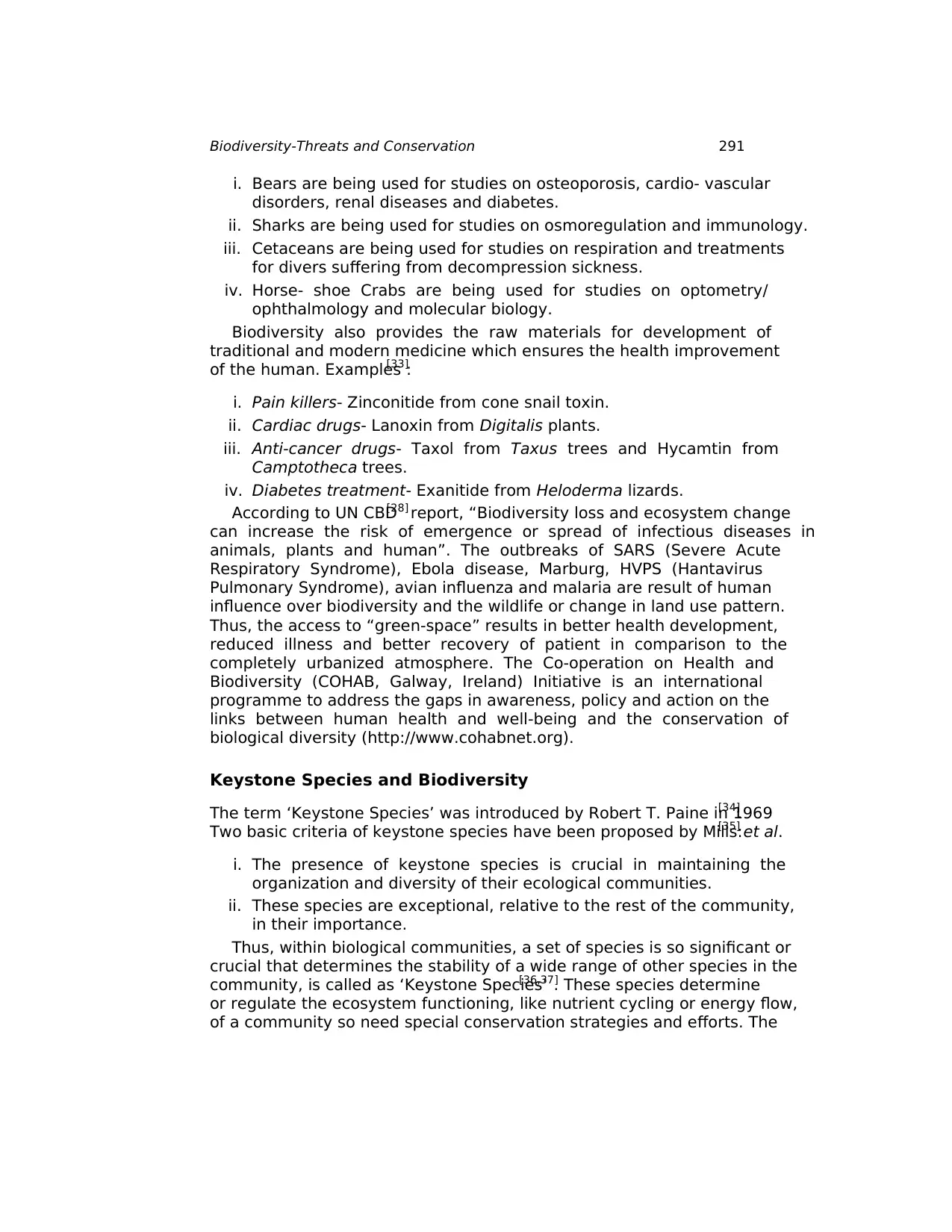
291Biodiversity-Threats and Conservation
i. Bears are being used for studies on osteoporosis, cardio- vascular
disorders, renal diseases and diabetes.
ii. Sharks are being used for studies on osmoregulation and immunology.
iii. Cetaceans are being used for studies on respiration and treatments
for divers suffering from decompression sickness.
iv. Horse- shoe Crabs are being used for studies on optometry/
ophthalmology and molecular biology.
Biodiversity also provides the raw materials for development of
traditional and modern medicine which ensures the health improvement
of the human. Examples[33]
:
i. Pain killers- Zinconitide from cone snail toxin.
ii. Cardiac drugs- Lanoxin from Digitalis plants.
iii. Anti-cancer drugs- Taxol from Taxus trees and Hycamtin from
Camptotheca trees.
iv. Diabetes treatment- Exanitide from Heloderma lizards.
According to UN CBD[28] report, “Biodiversity loss and ecosystem change
can increase the risk of emergence or spread of infectious diseases in
animals, plants and human”. The outbreaks of SARS (Severe Acute
Respiratory Syndrome), Ebola disease, Marburg, HVPS (Hantavirus
Pulmonary Syndrome), avian influenza and malaria are result of human
influence over biodiversity and the wildlife or change in land use pattern.
Thus, the access to “green-space” results in better health development,
reduced illness and better recovery of patient in comparison to the
completely urbanized atmosphere. The Co-operation on Health and
Biodiversity (COHAB, Galway, Ireland) Initiative is an international
programme to address the gaps in awareness, policy and action on the
links between human health and well-being and the conservation of
biological diversity (http://www.cohabnet.org).
Keystone Species and Biodiversity
The term ‘Keystone Species’ was introduced by Robert T. Paine in 1969[34]
.
Two basic criteria of keystone species have been proposed by Mills et al.[35]
:
i. The presence of keystone species is crucial in maintaining the
organization and diversity of their ecological communities.
ii. These species are exceptional, relative to the rest of the community,
in their importance.
Thus, within biological communities, a set of species is so significant or
crucial that determines the stability of a wide range of other species in the
community, is called as ‘Keystone Species’[36,37]
. These species determine
or regulate the ecosystem functioning, like nutrient cycling or energy flow,
of a community so need special conservation strategies and efforts. The
i. Bears are being used for studies on osteoporosis, cardio- vascular
disorders, renal diseases and diabetes.
ii. Sharks are being used for studies on osmoregulation and immunology.
iii. Cetaceans are being used for studies on respiration and treatments
for divers suffering from decompression sickness.
iv. Horse- shoe Crabs are being used for studies on optometry/
ophthalmology and molecular biology.
Biodiversity also provides the raw materials for development of
traditional and modern medicine which ensures the health improvement
of the human. Examples[33]
:
i. Pain killers- Zinconitide from cone snail toxin.
ii. Cardiac drugs- Lanoxin from Digitalis plants.
iii. Anti-cancer drugs- Taxol from Taxus trees and Hycamtin from
Camptotheca trees.
iv. Diabetes treatment- Exanitide from Heloderma lizards.
According to UN CBD[28] report, “Biodiversity loss and ecosystem change
can increase the risk of emergence or spread of infectious diseases in
animals, plants and human”. The outbreaks of SARS (Severe Acute
Respiratory Syndrome), Ebola disease, Marburg, HVPS (Hantavirus
Pulmonary Syndrome), avian influenza and malaria are result of human
influence over biodiversity and the wildlife or change in land use pattern.
Thus, the access to “green-space” results in better health development,
reduced illness and better recovery of patient in comparison to the
completely urbanized atmosphere. The Co-operation on Health and
Biodiversity (COHAB, Galway, Ireland) Initiative is an international
programme to address the gaps in awareness, policy and action on the
links between human health and well-being and the conservation of
biological diversity (http://www.cohabnet.org).
Keystone Species and Biodiversity
The term ‘Keystone Species’ was introduced by Robert T. Paine in 1969[34]
.
Two basic criteria of keystone species have been proposed by Mills et al.[35]
:
i. The presence of keystone species is crucial in maintaining the
organization and diversity of their ecological communities.
ii. These species are exceptional, relative to the rest of the community,
in their importance.
Thus, within biological communities, a set of species is so significant or
crucial that determines the stability of a wide range of other species in the
community, is called as ‘Keystone Species’[36,37]
. These species determine
or regulate the ecosystem functioning, like nutrient cycling or energy flow,
of a community so need special conservation strategies and efforts. The
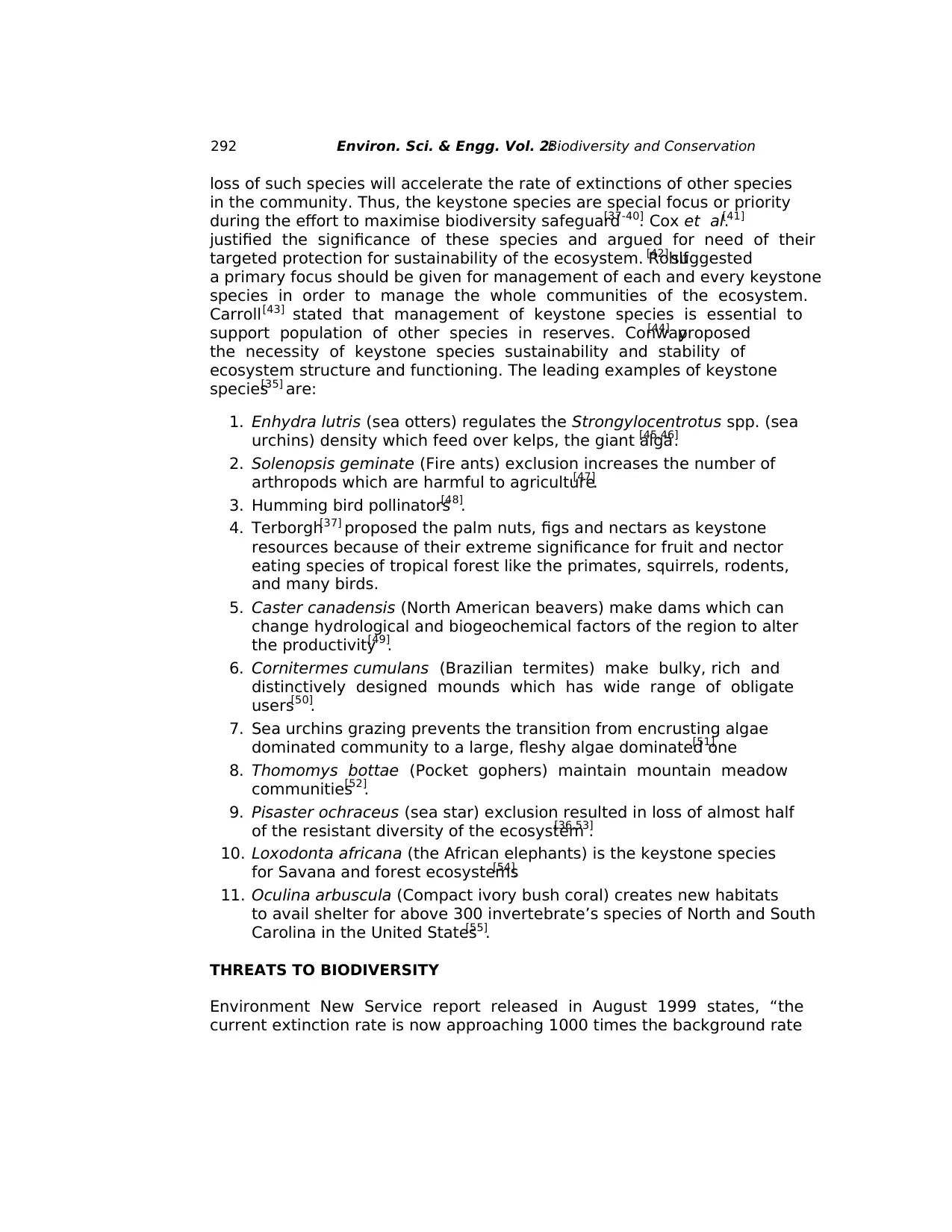
292 Environ. Sci. & Engg. Vol. 2:Biodiversity and Conservation
loss of such species will accelerate the rate of extinctions of other species
in the community. Thus, the keystone species are special focus or priority
during the effort to maximise biodiversity safeguard[37-40]
. Cox et al.[41]
justified the significance of these species and argued for need of their
targeted protection for sustainability of the ecosystem. Rohlf[42] suggested
a primary focus should be given for management of each and every keystone
species in order to manage the whole communities of the ecosystem.
Carroll[43] stated that management of keystone species is essential to
support population of other species in reserves. Conway[44] proposed
the necessity of keystone species sustainability and stability of
ecosystem structure and functioning. The leading examples of keystone
species[35] are:
1. Enhydra lutris (sea otters) regulates the Strongylocentrotus spp. (sea
urchins) density which feed over kelps, the giant alga[45,46]
.
2. Solenopsis geminate (Fire ants) exclusion increases the number of
arthropods which are harmful to agriculture[47]
.
3. Humming bird pollinators[48]
.
4. Terborgh[37] proposed the palm nuts, figs and nectars as keystone
resources because of their extreme significance for fruit and nector
eating species of tropical forest like the primates, squirrels, rodents,
and many birds.
5. Caster canadensis (North American beavers) make dams which can
change hydrological and biogeochemical factors of the region to alter
the productivity[49]
.
6. Cornitermes cumulans (Brazilian termites) make bulky, rich and
distinctively designed mounds which has wide range of obligate
users[50]
.
7. Sea urchins grazing prevents the transition from encrusting algae
dominated community to a large, fleshy algae dominated one[51]
.
8. Thomomys bottae (Pocket gophers) maintain mountain meadow
communities[52]
.
9. Pisaster ochraceus (sea star) exclusion resulted in loss of almost half
of the resistant diversity of the ecosystem[36,53]
.
10. Loxodonta africana (the African elephants) is the keystone species
for Savana and forest ecosystems[54]
.
11. Oculina arbuscula (Compact ivory bush coral) creates new habitats
to avail shelter for above 300 invertebrate’s species of North and South
Carolina in the United States[55]
.
THREATS TO BIODIVERSITY
Environment New Service report released in August 1999 states, “the
current extinction rate is now approaching 1000 times the background rate
loss of such species will accelerate the rate of extinctions of other species
in the community. Thus, the keystone species are special focus or priority
during the effort to maximise biodiversity safeguard[37-40]
. Cox et al.[41]
justified the significance of these species and argued for need of their
targeted protection for sustainability of the ecosystem. Rohlf[42] suggested
a primary focus should be given for management of each and every keystone
species in order to manage the whole communities of the ecosystem.
Carroll[43] stated that management of keystone species is essential to
support population of other species in reserves. Conway[44] proposed
the necessity of keystone species sustainability and stability of
ecosystem structure and functioning. The leading examples of keystone
species[35] are:
1. Enhydra lutris (sea otters) regulates the Strongylocentrotus spp. (sea
urchins) density which feed over kelps, the giant alga[45,46]
.
2. Solenopsis geminate (Fire ants) exclusion increases the number of
arthropods which are harmful to agriculture[47]
.
3. Humming bird pollinators[48]
.
4. Terborgh[37] proposed the palm nuts, figs and nectars as keystone
resources because of their extreme significance for fruit and nector
eating species of tropical forest like the primates, squirrels, rodents,
and many birds.
5. Caster canadensis (North American beavers) make dams which can
change hydrological and biogeochemical factors of the region to alter
the productivity[49]
.
6. Cornitermes cumulans (Brazilian termites) make bulky, rich and
distinctively designed mounds which has wide range of obligate
users[50]
.
7. Sea urchins grazing prevents the transition from encrusting algae
dominated community to a large, fleshy algae dominated one[51]
.
8. Thomomys bottae (Pocket gophers) maintain mountain meadow
communities[52]
.
9. Pisaster ochraceus (sea star) exclusion resulted in loss of almost half
of the resistant diversity of the ecosystem[36,53]
.
10. Loxodonta africana (the African elephants) is the keystone species
for Savana and forest ecosystems[54]
.
11. Oculina arbuscula (Compact ivory bush coral) creates new habitats
to avail shelter for above 300 invertebrate’s species of North and South
Carolina in the United States[55]
.
THREATS TO BIODIVERSITY
Environment New Service report released in August 1999 states, “the
current extinction rate is now approaching 1000 times the background rate
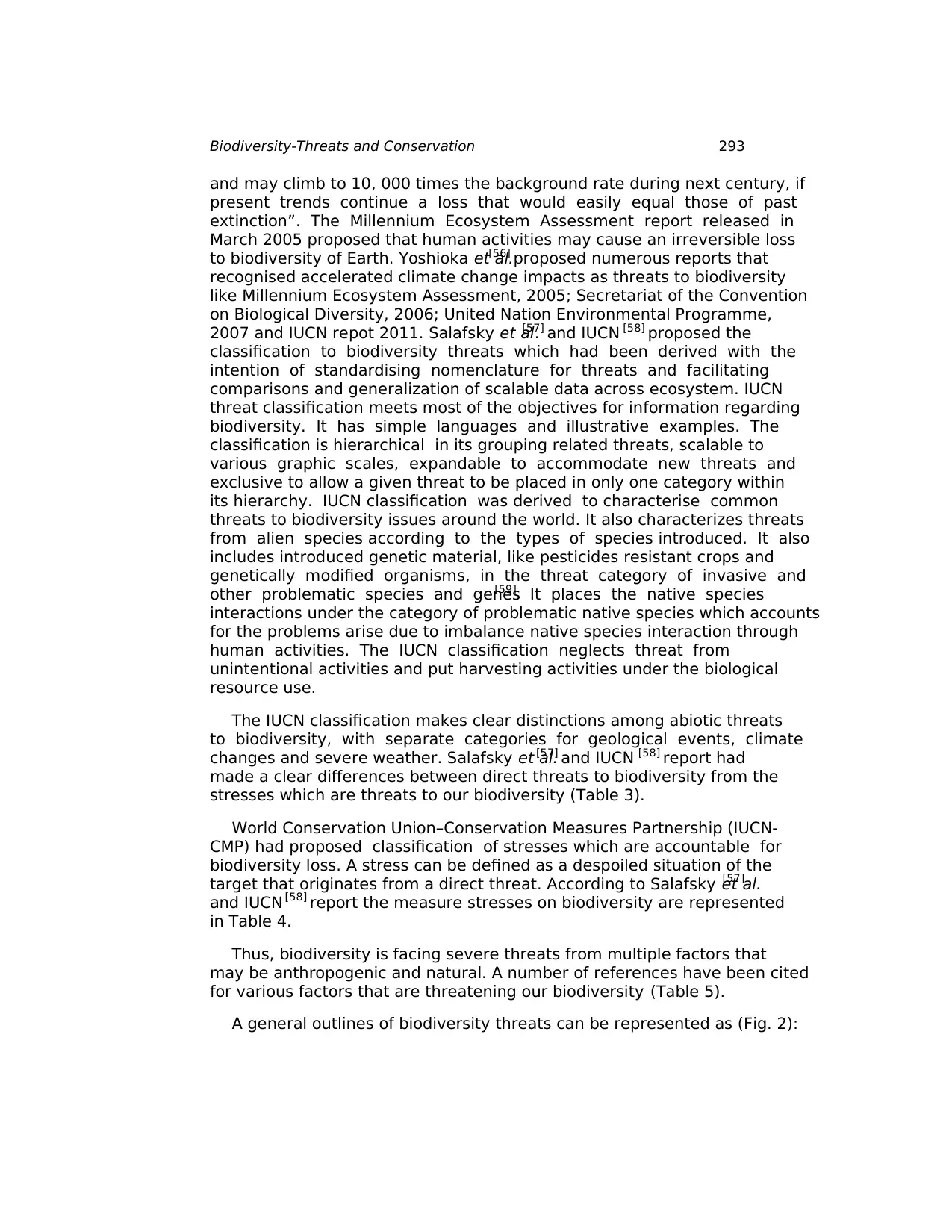
293Biodiversity-Threats and Conservation
and may climb to 10, 000 times the background rate during next century, if
present trends continue a loss that would easily equal those of past
extinction”. The Millennium Ecosystem Assessment report released in
March 2005 proposed that human activities may cause an irreversible loss
to biodiversity of Earth. Yoshioka et al.[56] proposed numerous reports that
recognised accelerated climate change impacts as threats to biodiversity
like Millennium Ecosystem Assessment, 2005; Secretariat of the Convention
on Biological Diversity, 2006; United Nation Environmental Programme,
2007 and IUCN repot 2011. Salafsky et al.[57] and IUCN [58] proposed the
classification to biodiversity threats which had been derived with the
intention of standardising nomenclature for threats and facilitating
comparisons and generalization of scalable data across ecosystem. IUCN
threat classification meets most of the objectives for information regarding
biodiversity. It has simple languages and illustrative examples. The
classification is hierarchical in its grouping related threats, scalable to
various graphic scales, expandable to accommodate new threats and
exclusive to allow a given threat to be placed in only one category within
its hierarchy. IUCN classification was derived to characterise common
threats to biodiversity issues around the world. It also characterizes threats
from alien species according to the types of species introduced. It also
includes introduced genetic material, like pesticides resistant crops and
genetically modified organisms, in the threat category of invasive and
other problematic species and genes[59]. It places the native species
interactions under the category of problematic native species which accounts
for the problems arise due to imbalance native species interaction through
human activities. The IUCN classification neglects threat from
unintentional activities and put harvesting activities under the biological
resource use.
The IUCN classification makes clear distinctions among abiotic threats
to biodiversity, with separate categories for geological events, climate
changes and severe weather. Salafsky et al.[57] and IUCN [58] report had
made a clear differences between direct threats to biodiversity from the
stresses which are threats to our biodiversity (Table 3).
World Conservation Union–Conservation Measures Partnership (IUCN-
CMP) had proposed classification of stresses which are accountable for
biodiversity loss. A stress can be defined as a despoiled situation of the
target that originates from a direct threat. According to Salafsky et al.[57]
and IUCN [58] report the measure stresses on biodiversity are represented
in Table 4.
Thus, biodiversity is facing severe threats from multiple factors that
may be anthropogenic and natural. A number of references have been cited
for various factors that are threatening our biodiversity (Table 5).
A general outlines of biodiversity threats can be represented as (Fig. 2):
and may climb to 10, 000 times the background rate during next century, if
present trends continue a loss that would easily equal those of past
extinction”. The Millennium Ecosystem Assessment report released in
March 2005 proposed that human activities may cause an irreversible loss
to biodiversity of Earth. Yoshioka et al.[56] proposed numerous reports that
recognised accelerated climate change impacts as threats to biodiversity
like Millennium Ecosystem Assessment, 2005; Secretariat of the Convention
on Biological Diversity, 2006; United Nation Environmental Programme,
2007 and IUCN repot 2011. Salafsky et al.[57] and IUCN [58] proposed the
classification to biodiversity threats which had been derived with the
intention of standardising nomenclature for threats and facilitating
comparisons and generalization of scalable data across ecosystem. IUCN
threat classification meets most of the objectives for information regarding
biodiversity. It has simple languages and illustrative examples. The
classification is hierarchical in its grouping related threats, scalable to
various graphic scales, expandable to accommodate new threats and
exclusive to allow a given threat to be placed in only one category within
its hierarchy. IUCN classification was derived to characterise common
threats to biodiversity issues around the world. It also characterizes threats
from alien species according to the types of species introduced. It also
includes introduced genetic material, like pesticides resistant crops and
genetically modified organisms, in the threat category of invasive and
other problematic species and genes[59]. It places the native species
interactions under the category of problematic native species which accounts
for the problems arise due to imbalance native species interaction through
human activities. The IUCN classification neglects threat from
unintentional activities and put harvesting activities under the biological
resource use.
The IUCN classification makes clear distinctions among abiotic threats
to biodiversity, with separate categories for geological events, climate
changes and severe weather. Salafsky et al.[57] and IUCN [58] report had
made a clear differences between direct threats to biodiversity from the
stresses which are threats to our biodiversity (Table 3).
World Conservation Union–Conservation Measures Partnership (IUCN-
CMP) had proposed classification of stresses which are accountable for
biodiversity loss. A stress can be defined as a despoiled situation of the
target that originates from a direct threat. According to Salafsky et al.[57]
and IUCN [58] report the measure stresses on biodiversity are represented
in Table 4.
Thus, biodiversity is facing severe threats from multiple factors that
may be anthropogenic and natural. A number of references have been cited
for various factors that are threatening our biodiversity (Table 5).
A general outlines of biodiversity threats can be represented as (Fig. 2):
Paraphrase This Document
Need a fresh take? Get an instant paraphrase of this document with our AI Paraphraser
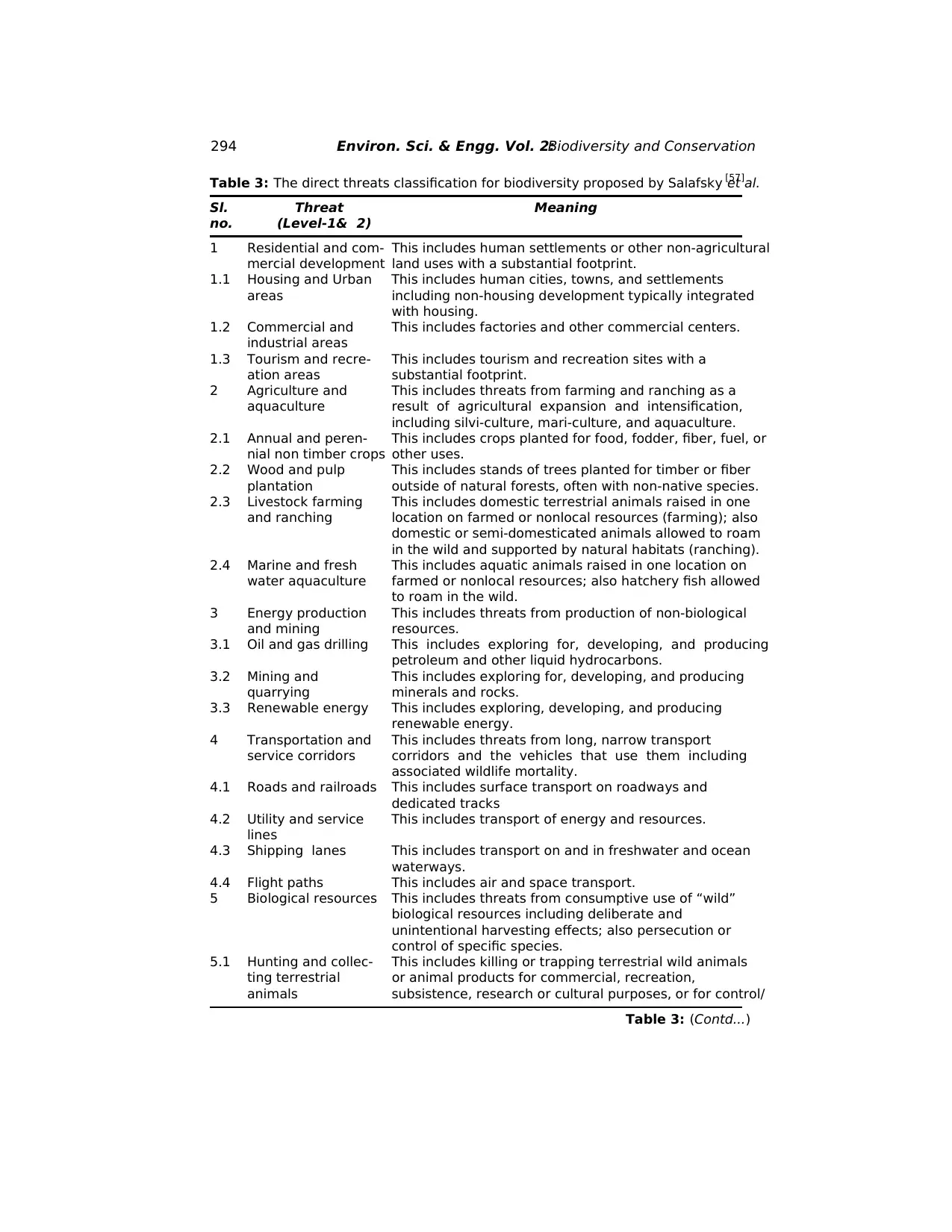
294 Environ. Sci. & Engg. Vol. 2:Biodiversity and Conservation
Table 3: The direct threats classification for biodiversity proposed by Salafsky et al.[57]
Sl. Threat Meaning
no. (Level-1& 2)
1 Residential and com- This includes human settlements or other non-agricultural
mercial development land uses with a substantial footprint.
1.1 Housing and Urban This includes human cities, towns, and settlements
areas including non-housing development typically integrated
with housing.
1.2 Commercial and This includes factories and other commercial centers.
industrial areas
1.3 Tourism and recre- This includes tourism and recreation sites with a
ation areas substantial footprint.
2 Agriculture and This includes threats from farming and ranching as a
aquaculture result of agricultural expansion and intensification,
including silvi-culture, mari-culture, and aquaculture.
2.1 Annual and peren- This includes crops planted for food, fodder, fiber, fuel, or
nial non timber crops other uses.
2.2 Wood and pulp This includes stands of trees planted for timber or fiber
plantation outside of natural forests, often with non-native species.
2.3 Livestock farming This includes domestic terrestrial animals raised in one
and ranching location on farmed or nonlocal resources (farming); also
domestic or semi-domesticated animals allowed to roam
in the wild and supported by natural habitats (ranching).
2.4 Marine and fresh This includes aquatic animals raised in one location on
water aquaculture farmed or nonlocal resources; also hatchery fish allowed
to roam in the wild.
3 Energy production This includes threats from production of non-biological
and mining resources.
3.1 Oil and gas drilling This includes exploring for, developing, and producing
petroleum and other liquid hydrocarbons.
3.2 Mining and This includes exploring for, developing, and producing
quarrying minerals and rocks.
3.3 Renewable energy This includes exploring, developing, and producing
renewable energy.
4 Transportation and This includes threats from long, narrow transport
service corridors corridors and the vehicles that use them including
associated wildlife mortality.
4.1 Roads and railroads This includes surface transport on roadways and
dedicated tracks
4.2 Utility and service This includes transport of energy and resources.
lines
4.3 Shipping lanes This includes transport on and in freshwater and ocean
waterways.
4.4 Flight paths This includes air and space transport.
5 Biological resources This includes threats from consumptive use of “wild”
biological resources including deliberate and
unintentional harvesting effects; also persecution or
control of specific species.
5.1 Hunting and collec- This includes killing or trapping terrestrial wild animals
ting terrestrial or animal products for commercial, recreation,
animals subsistence, research or cultural purposes, or for control/
Table 3: (Contd...)
Table 3: The direct threats classification for biodiversity proposed by Salafsky et al.[57]
Sl. Threat Meaning
no. (Level-1& 2)
1 Residential and com- This includes human settlements or other non-agricultural
mercial development land uses with a substantial footprint.
1.1 Housing and Urban This includes human cities, towns, and settlements
areas including non-housing development typically integrated
with housing.
1.2 Commercial and This includes factories and other commercial centers.
industrial areas
1.3 Tourism and recre- This includes tourism and recreation sites with a
ation areas substantial footprint.
2 Agriculture and This includes threats from farming and ranching as a
aquaculture result of agricultural expansion and intensification,
including silvi-culture, mari-culture, and aquaculture.
2.1 Annual and peren- This includes crops planted for food, fodder, fiber, fuel, or
nial non timber crops other uses.
2.2 Wood and pulp This includes stands of trees planted for timber or fiber
plantation outside of natural forests, often with non-native species.
2.3 Livestock farming This includes domestic terrestrial animals raised in one
and ranching location on farmed or nonlocal resources (farming); also
domestic or semi-domesticated animals allowed to roam
in the wild and supported by natural habitats (ranching).
2.4 Marine and fresh This includes aquatic animals raised in one location on
water aquaculture farmed or nonlocal resources; also hatchery fish allowed
to roam in the wild.
3 Energy production This includes threats from production of non-biological
and mining resources.
3.1 Oil and gas drilling This includes exploring for, developing, and producing
petroleum and other liquid hydrocarbons.
3.2 Mining and This includes exploring for, developing, and producing
quarrying minerals and rocks.
3.3 Renewable energy This includes exploring, developing, and producing
renewable energy.
4 Transportation and This includes threats from long, narrow transport
service corridors corridors and the vehicles that use them including
associated wildlife mortality.
4.1 Roads and railroads This includes surface transport on roadways and
dedicated tracks
4.2 Utility and service This includes transport of energy and resources.
lines
4.3 Shipping lanes This includes transport on and in freshwater and ocean
waterways.
4.4 Flight paths This includes air and space transport.
5 Biological resources This includes threats from consumptive use of “wild”
biological resources including deliberate and
unintentional harvesting effects; also persecution or
control of specific species.
5.1 Hunting and collec- This includes killing or trapping terrestrial wild animals
ting terrestrial or animal products for commercial, recreation,
animals subsistence, research or cultural purposes, or for control/
Table 3: (Contd...)
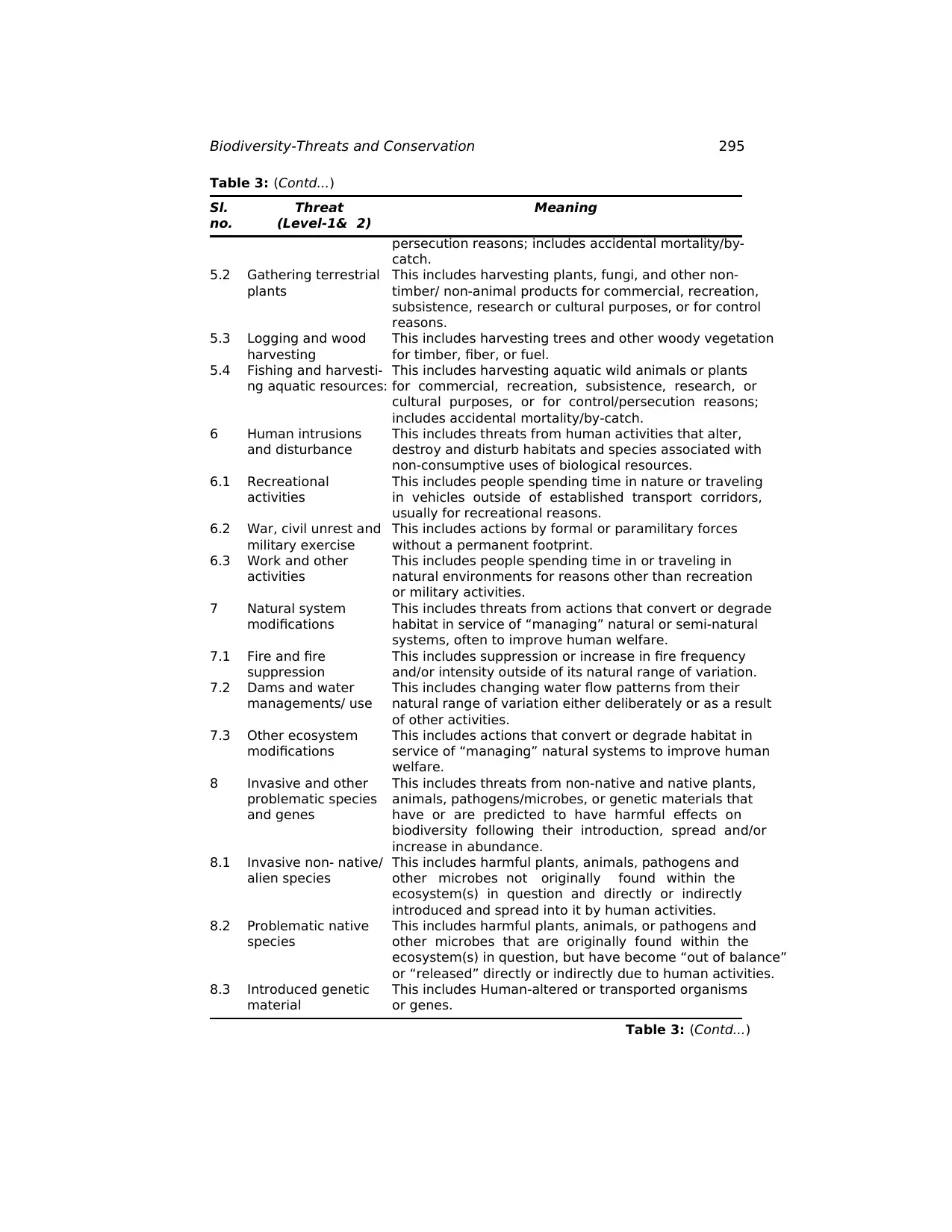
295Biodiversity-Threats and Conservation
persecution reasons; includes accidental mortality/by-
catch.
5.2 Gathering terrestrial This includes harvesting plants, fungi, and other non-
plants timber/ non-animal products for commercial, recreation,
subsistence, research or cultural purposes, or for control
reasons.
5.3 Logging and wood This includes harvesting trees and other woody vegetation
harvesting for timber, fiber, or fuel.
5.4 Fishing and harvesti- This includes harvesting aquatic wild animals or plants
ng aquatic resources: for commercial, recreation, subsistence, research, or
cultural purposes, or for control/persecution reasons;
includes accidental mortality/by-catch.
6 Human intrusions This includes threats from human activities that alter,
and disturbance destroy and disturb habitats and species associated with
non-consumptive uses of biological resources.
6.1 Recreational This includes people spending time in nature or traveling
activities in vehicles outside of established transport corridors,
usually for recreational reasons.
6.2 War, civil unrest and This includes actions by formal or paramilitary forces
military exercise without a permanent footprint.
6.3 Work and other This includes people spending time in or traveling in
activities natural environments for reasons other than recreation
or military activities.
7 Natural system This includes threats from actions that convert or degrade
modifications habitat in service of “managing” natural or semi-natural
systems, often to improve human welfare.
7.1 Fire and fire This includes suppression or increase in fire frequency
suppression and/or intensity outside of its natural range of variation.
7.2 Dams and water This includes changing water flow patterns from their
managements/ use natural range of variation either deliberately or as a result
of other activities.
7.3 Other ecosystem This includes actions that convert or degrade habitat in
modifications service of “managing” natural systems to improve human
welfare.
8 Invasive and other This includes threats from non-native and native plants,
problematic species animals, pathogens/microbes, or genetic materials that
and genes have or are predicted to have harmful effects on
biodiversity following their introduction, spread and/or
increase in abundance.
8.1 Invasive non- native/ This includes harmful plants, animals, pathogens and
alien species other microbes not originally found within the
ecosystem(s) in question and directly or indirectly
introduced and spread into it by human activities.
8.2 Problematic native This includes harmful plants, animals, or pathogens and
species other microbes that are originally found within the
ecosystem(s) in question, but have become “out of balance”
or “released” directly or indirectly due to human activities.
8.3 Introduced genetic This includes Human-altered or transported organisms
material or genes.
Table 3: (Contd...)
Sl. Threat Meaning
no. (Level-1& 2)
Table 3: (Contd...)
persecution reasons; includes accidental mortality/by-
catch.
5.2 Gathering terrestrial This includes harvesting plants, fungi, and other non-
plants timber/ non-animal products for commercial, recreation,
subsistence, research or cultural purposes, or for control
reasons.
5.3 Logging and wood This includes harvesting trees and other woody vegetation
harvesting for timber, fiber, or fuel.
5.4 Fishing and harvesti- This includes harvesting aquatic wild animals or plants
ng aquatic resources: for commercial, recreation, subsistence, research, or
cultural purposes, or for control/persecution reasons;
includes accidental mortality/by-catch.
6 Human intrusions This includes threats from human activities that alter,
and disturbance destroy and disturb habitats and species associated with
non-consumptive uses of biological resources.
6.1 Recreational This includes people spending time in nature or traveling
activities in vehicles outside of established transport corridors,
usually for recreational reasons.
6.2 War, civil unrest and This includes actions by formal or paramilitary forces
military exercise without a permanent footprint.
6.3 Work and other This includes people spending time in or traveling in
activities natural environments for reasons other than recreation
or military activities.
7 Natural system This includes threats from actions that convert or degrade
modifications habitat in service of “managing” natural or semi-natural
systems, often to improve human welfare.
7.1 Fire and fire This includes suppression or increase in fire frequency
suppression and/or intensity outside of its natural range of variation.
7.2 Dams and water This includes changing water flow patterns from their
managements/ use natural range of variation either deliberately or as a result
of other activities.
7.3 Other ecosystem This includes actions that convert or degrade habitat in
modifications service of “managing” natural systems to improve human
welfare.
8 Invasive and other This includes threats from non-native and native plants,
problematic species animals, pathogens/microbes, or genetic materials that
and genes have or are predicted to have harmful effects on
biodiversity following their introduction, spread and/or
increase in abundance.
8.1 Invasive non- native/ This includes harmful plants, animals, pathogens and
alien species other microbes not originally found within the
ecosystem(s) in question and directly or indirectly
introduced and spread into it by human activities.
8.2 Problematic native This includes harmful plants, animals, or pathogens and
species other microbes that are originally found within the
ecosystem(s) in question, but have become “out of balance”
or “released” directly or indirectly due to human activities.
8.3 Introduced genetic This includes Human-altered or transported organisms
material or genes.
Table 3: (Contd...)
Sl. Threat Meaning
no. (Level-1& 2)
Table 3: (Contd...)
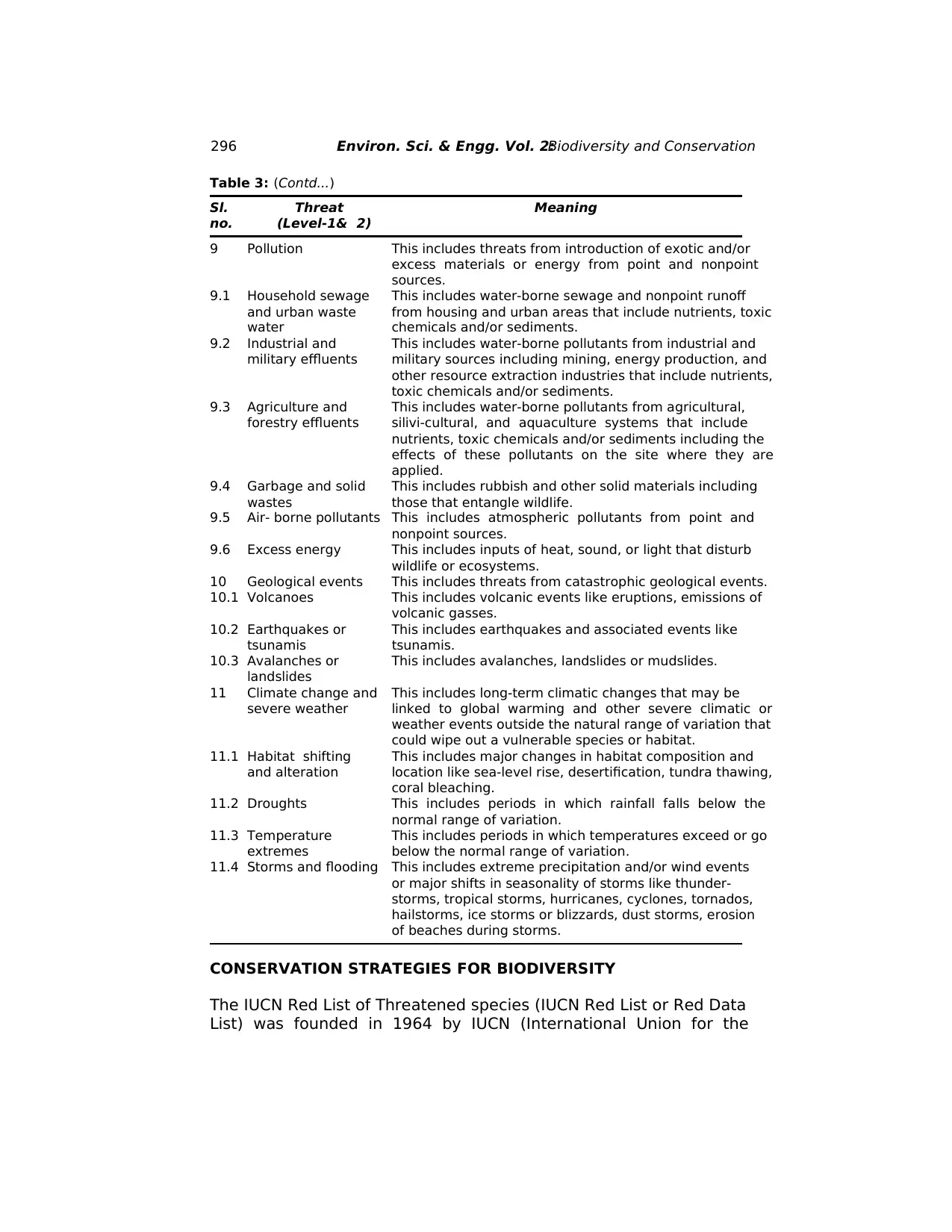
296 Environ. Sci. & Engg. Vol. 2:Biodiversity and Conservation
9 Pollution This includes threats from introduction of exotic and/or
excess materials or energy from point and nonpoint
sources.
9.1 Household sewage This includes water-borne sewage and nonpoint runoff
and urban waste from housing and urban areas that include nutrients, toxic
water chemicals and/or sediments.
9.2 Industrial and This includes water-borne pollutants from industrial and
military effluents military sources including mining, energy production, and
other resource extraction industries that include nutrients,
toxic chemicals and/or sediments.
9.3 Agriculture and This includes water-borne pollutants from agricultural,
forestry effluents silivi-cultural, and aquaculture systems that include
nutrients, toxic chemicals and/or sediments including the
effects of these pollutants on the site where they are
applied.
9.4 Garbage and solid This includes rubbish and other solid materials including
wastes those that entangle wildlife.
9.5 Air- borne pollutants This includes atmospheric pollutants from point and
nonpoint sources.
9.6 Excess energy This includes inputs of heat, sound, or light that disturb
wildlife or ecosystems.
10 Geological events This includes threats from catastrophic geological events.
10.1 Volcanoes This includes volcanic events like eruptions, emissions of
volcanic gasses.
10.2 Earthquakes or This includes earthquakes and associated events like
tsunamis tsunamis.
10.3 Avalanches or This includes avalanches, landslides or mudslides.
landslides
11 Climate change and This includes long-term climatic changes that may be
severe weather linked to global warming and other severe climatic or
weather events outside the natural range of variation that
could wipe out a vulnerable species or habitat.
11.1 Habitat shifting This includes major changes in habitat composition and
and alteration location like sea-level rise, desertification, tundra thawing,
coral bleaching.
11.2 Droughts This includes periods in which rainfall falls below the
normal range of variation.
11.3 Temperature This includes periods in which temperatures exceed or go
extremes below the normal range of variation.
11.4 Storms and flooding This includes extreme precipitation and/or wind events
or major shifts in seasonality of storms like thunder-
storms, tropical storms, hurricanes, cyclones, tornados,
hailstorms, ice storms or blizzards, dust storms, erosion
of beaches during storms.
Table 3: (Contd...)
Sl. Threat Meaning
no. (Level-1& 2)
CONSERVATION STRATEGIES FOR BIODIVERSITY
The IUCN Red List of Threatened species (IUCN Red List or Red Data
List) was founded in 1964 by IUCN (International Union for the
9 Pollution This includes threats from introduction of exotic and/or
excess materials or energy from point and nonpoint
sources.
9.1 Household sewage This includes water-borne sewage and nonpoint runoff
and urban waste from housing and urban areas that include nutrients, toxic
water chemicals and/or sediments.
9.2 Industrial and This includes water-borne pollutants from industrial and
military effluents military sources including mining, energy production, and
other resource extraction industries that include nutrients,
toxic chemicals and/or sediments.
9.3 Agriculture and This includes water-borne pollutants from agricultural,
forestry effluents silivi-cultural, and aquaculture systems that include
nutrients, toxic chemicals and/or sediments including the
effects of these pollutants on the site where they are
applied.
9.4 Garbage and solid This includes rubbish and other solid materials including
wastes those that entangle wildlife.
9.5 Air- borne pollutants This includes atmospheric pollutants from point and
nonpoint sources.
9.6 Excess energy This includes inputs of heat, sound, or light that disturb
wildlife or ecosystems.
10 Geological events This includes threats from catastrophic geological events.
10.1 Volcanoes This includes volcanic events like eruptions, emissions of
volcanic gasses.
10.2 Earthquakes or This includes earthquakes and associated events like
tsunamis tsunamis.
10.3 Avalanches or This includes avalanches, landslides or mudslides.
landslides
11 Climate change and This includes long-term climatic changes that may be
severe weather linked to global warming and other severe climatic or
weather events outside the natural range of variation that
could wipe out a vulnerable species or habitat.
11.1 Habitat shifting This includes major changes in habitat composition and
and alteration location like sea-level rise, desertification, tundra thawing,
coral bleaching.
11.2 Droughts This includes periods in which rainfall falls below the
normal range of variation.
11.3 Temperature This includes periods in which temperatures exceed or go
extremes below the normal range of variation.
11.4 Storms and flooding This includes extreme precipitation and/or wind events
or major shifts in seasonality of storms like thunder-
storms, tropical storms, hurricanes, cyclones, tornados,
hailstorms, ice storms or blizzards, dust storms, erosion
of beaches during storms.
Table 3: (Contd...)
Sl. Threat Meaning
no. (Level-1& 2)
CONSERVATION STRATEGIES FOR BIODIVERSITY
The IUCN Red List of Threatened species (IUCN Red List or Red Data
List) was founded in 1964 by IUCN (International Union for the
Secure Best Marks with AI Grader
Need help grading? Try our AI Grader for instant feedback on your assignments.
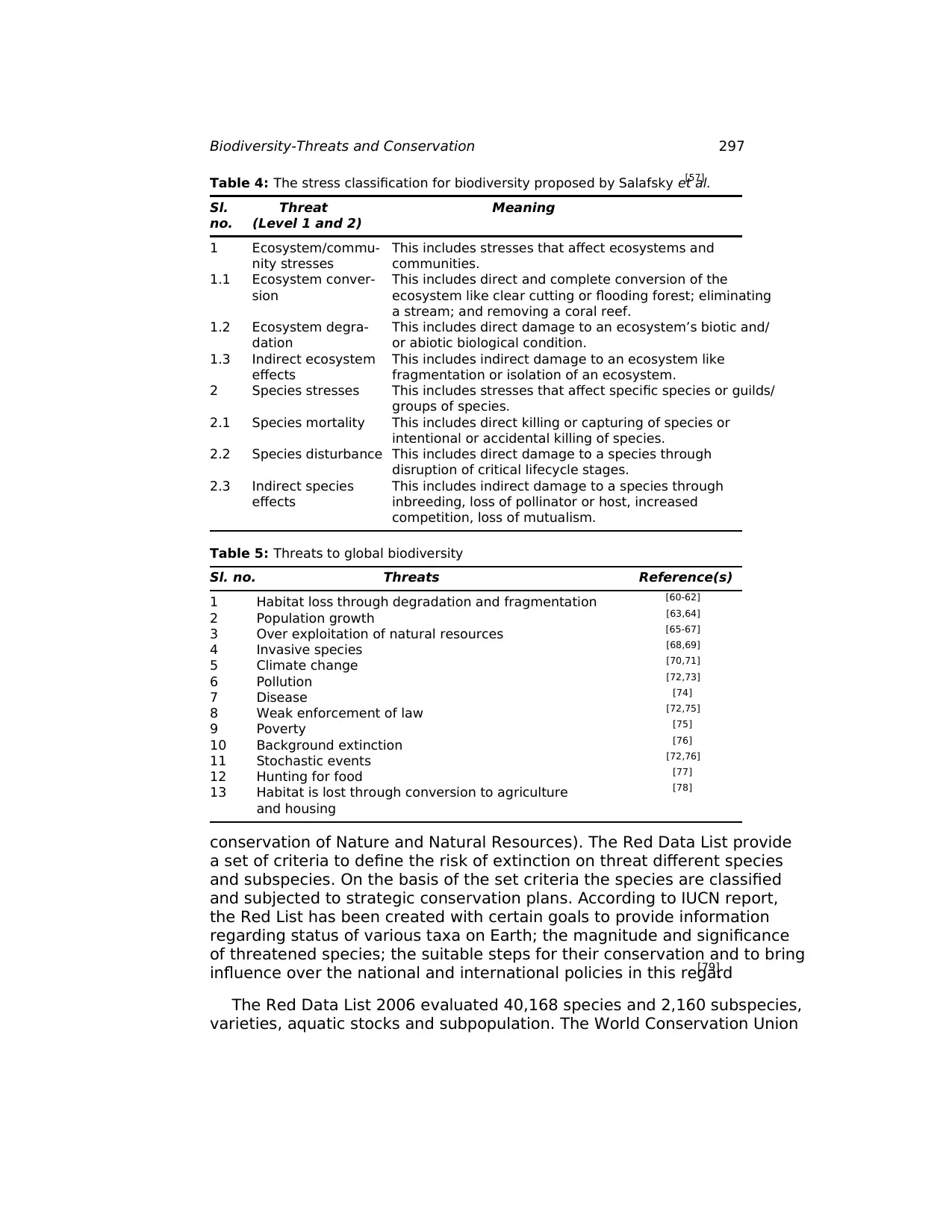
297Biodiversity-Threats and Conservation
Table 4: The stress classification for biodiversity proposed by Salafsky et al.[57]
Sl. Threat Meaning
no. (Level 1 and 2)
1 Ecosystem/commu- This includes stresses that affect ecosystems and
nity stresses communities.
1.1 Ecosystem conver- This includes direct and complete conversion of the
sion ecosystem like clear cutting or flooding forest; eliminating
a stream; and removing a coral reef.
1.2 Ecosystem degra- This includes direct damage to an ecosystem’s biotic and/
dation or abiotic biological condition.
1.3 Indirect ecosystem This includes indirect damage to an ecosystem like
effects fragmentation or isolation of an ecosystem.
2 Species stresses This includes stresses that affect specific species or guilds/
groups of species.
2.1 Species mortality This includes direct killing or capturing of species or
intentional or accidental killing of species.
2.2 Species disturbance This includes direct damage to a species through
disruption of critical lifecycle stages.
2.3 Indirect species This includes indirect damage to a species through
effects inbreeding, loss of pollinator or host, increased
competition, loss of mutualism.
Table 5: Threats to global biodiversity
Sl. no. Threats Reference(s)
1 Habitat loss through degradation and fragmentation [60-62]
2 Population growth [63,64]
3 Over exploitation of natural resources [65-67]
4 Invasive species [68,69]
5 Climate change [70,71]
6 Pollution [72,73]
7 Disease [74]
8 Weak enforcement of law [72,75]
9 Poverty [75]
10 Background extinction [76]
11 Stochastic events [72,76]
12 Hunting for food [77]
13 Habitat is lost through conversion to agriculture [78]
and housing
conservation of Nature and Natural Resources). The Red Data List provide
a set of criteria to define the risk of extinction on threat different species
and subspecies. On the basis of the set criteria the species are classified
and subjected to strategic conservation plans. According to IUCN report,
the Red List has been created with certain goals to provide information
regarding status of various taxa on Earth; the magnitude and significance
of threatened species; the suitable steps for their conservation and to bring
influence over the national and international policies in this regard[79]
.
The Red Data List 2006 evaluated 40,168 species and 2,160 subspecies,
varieties, aquatic stocks and subpopulation. The World Conservation Union
Table 4: The stress classification for biodiversity proposed by Salafsky et al.[57]
Sl. Threat Meaning
no. (Level 1 and 2)
1 Ecosystem/commu- This includes stresses that affect ecosystems and
nity stresses communities.
1.1 Ecosystem conver- This includes direct and complete conversion of the
sion ecosystem like clear cutting or flooding forest; eliminating
a stream; and removing a coral reef.
1.2 Ecosystem degra- This includes direct damage to an ecosystem’s biotic and/
dation or abiotic biological condition.
1.3 Indirect ecosystem This includes indirect damage to an ecosystem like
effects fragmentation or isolation of an ecosystem.
2 Species stresses This includes stresses that affect specific species or guilds/
groups of species.
2.1 Species mortality This includes direct killing or capturing of species or
intentional or accidental killing of species.
2.2 Species disturbance This includes direct damage to a species through
disruption of critical lifecycle stages.
2.3 Indirect species This includes indirect damage to a species through
effects inbreeding, loss of pollinator or host, increased
competition, loss of mutualism.
Table 5: Threats to global biodiversity
Sl. no. Threats Reference(s)
1 Habitat loss through degradation and fragmentation [60-62]
2 Population growth [63,64]
3 Over exploitation of natural resources [65-67]
4 Invasive species [68,69]
5 Climate change [70,71]
6 Pollution [72,73]
7 Disease [74]
8 Weak enforcement of law [72,75]
9 Poverty [75]
10 Background extinction [76]
11 Stochastic events [72,76]
12 Hunting for food [77]
13 Habitat is lost through conversion to agriculture [78]
and housing
conservation of Nature and Natural Resources). The Red Data List provide
a set of criteria to define the risk of extinction on threat different species
and subspecies. On the basis of the set criteria the species are classified
and subjected to strategic conservation plans. According to IUCN report,
the Red List has been created with certain goals to provide information
regarding status of various taxa on Earth; the magnitude and significance
of threatened species; the suitable steps for their conservation and to bring
influence over the national and international policies in this regard[79]
.
The Red Data List 2006 evaluated 40,168 species and 2,160 subspecies,
varieties, aquatic stocks and subpopulation. The World Conservation Union
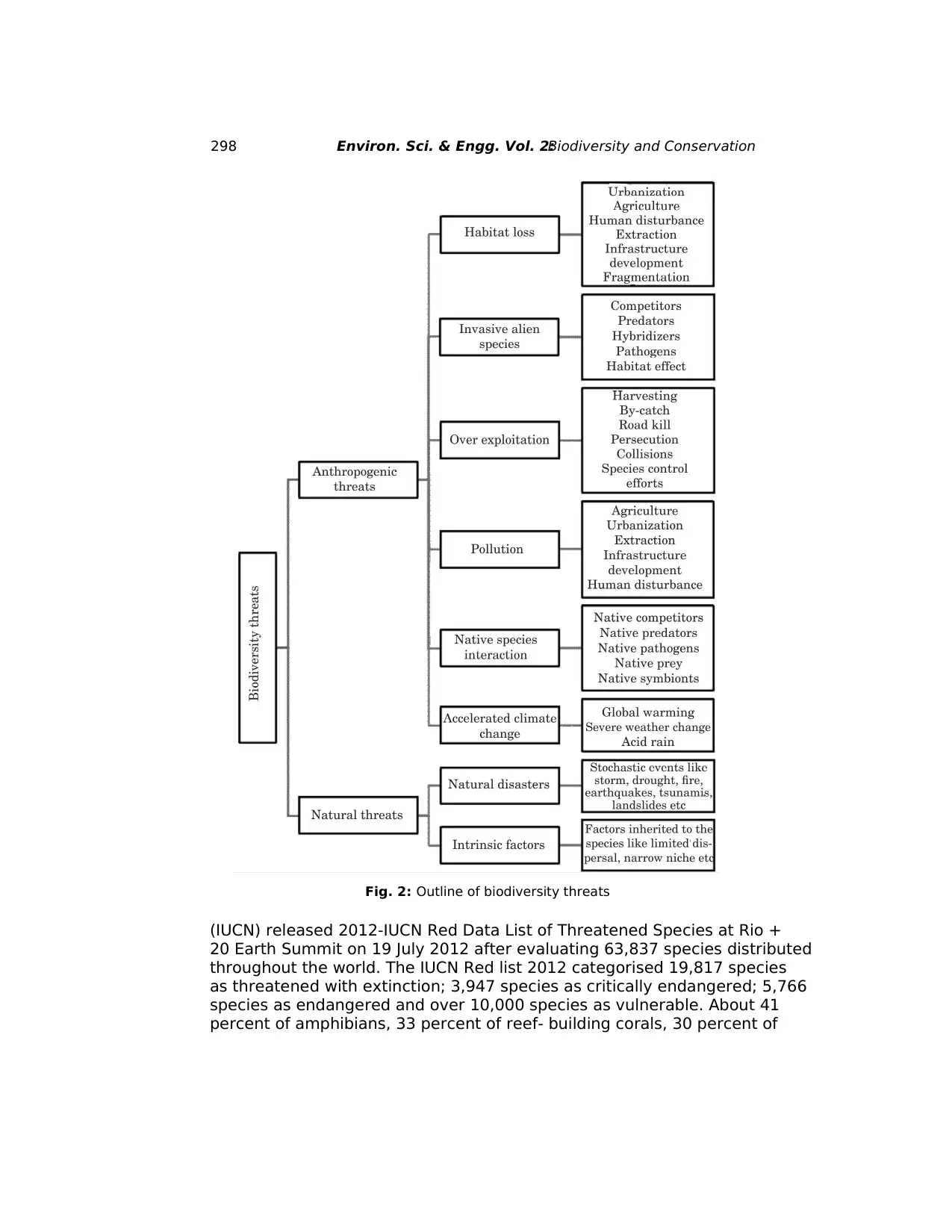
298 Environ. Sci. & Engg. Vol. 2:Biodiversity and Conservation
(IUCN) released 2012-IUCN Red Data List of Threatened Species at Rio +
20 Earth Summit on 19 July 2012 after evaluating 63,837 species distributed
throughout the world. The IUCN Red list 2012 categorised 19,817 species
as threatened with extinction; 3,947 species as critically endangered; 5,766
species as endangered and over 10,000 species as vulnerable. About 41
percent of amphibians, 33 percent of reef- building corals, 30 percent of
Fig. 2: Outline of biodiversity threats
(IUCN) released 2012-IUCN Red Data List of Threatened Species at Rio +
20 Earth Summit on 19 July 2012 after evaluating 63,837 species distributed
throughout the world. The IUCN Red list 2012 categorised 19,817 species
as threatened with extinction; 3,947 species as critically endangered; 5,766
species as endangered and over 10,000 species as vulnerable. About 41
percent of amphibians, 33 percent of reef- building corals, 30 percent of
Fig. 2: Outline of biodiversity threats

299Biodiversity-Threats and Conservation
Table 6: IUCN threat categories (2012)
Sl. Threat Definition Number of
no. cate- species in
gories India
1 Extinct A taxon is said to be ‘extinct’ when there is no reaso-
nable doubt that the last individual has died. 81
2 Extinct in A taxon is said to be ‘extinct in the wild’ when it is
the wild known only to survive in captivity, or as a neutralized
population outside its historic habitat. 63
3 Critically A taxon is said to be ‘critically endangered’ when it is 3,947
endangered facing high risk of extinction in the wild in immediate
future.
4 Endangered A taxon is said to be ‘endangered’ when it is facing very5,766
high risk of extinction in the wild in near future.
5 Vulnerable A taxon is said to be ‘vulnerable’ when it is facing very 10,104
high risk of endangered in the wild in near future.
6 Near to A taxon is said to be ‘near to threat’ when it is likely 4,467
threat to become endangered in near future.
7 Least A taxon with lowest risk. These are the widespread and –
concern abundant taxa.
8 Data A taxon is said to be ‘data deficient’ when there is inade-10,497
deficient quate information to make any direct or indirect
assessment of its risk of extinction.
9 Not evalu- A taxon is said to be ‘not evaluated’ when it has not yet –
ated been assessed against the above criteria.
conifers, 25 percent of mammals and 13 percent of birds are at threat. The
IUCN red list 2012 has reported 132 ‘Critically Endangered’ species of plants
and animals from India which includes 18 amphibians, 14 fishes, 10
mammals and 60 plant species. The reports categorised 360 species in
‘Endangered’ list which includes 69 fishes, 38 mammals, 32 amphibians
and 141 plant species[80]
.
The IUCN Red Data has recognised nine different categories of species
as per their status and has stated the conservation practices accordingly.
The IUCN threat categories are listed in Table 6.
Shrimati Jayanthi Natarajan, Minister of State (Independent Charge)
for Environment and Forests, in the LokSabha on Monday, March 4th 2013
delivered that following 17 plant species are considered as possibly extinct
as they have not been collected from wild for more than last fifty years:
1. Isoetes dixitii Shende,
2. Isoetes sampthkumarnii L.N. Rao,
3. Selaginella cataractarum Alston,
4. Lastreopsis wattii (Bedd.) C. Chr.,
5. Ophiorrhiza brunonis Wight & Arn.,
6. Ophiorrhiza caudata C. Fischer,
Table 6: IUCN threat categories (2012)
Sl. Threat Definition Number of
no. cate- species in
gories India
1 Extinct A taxon is said to be ‘extinct’ when there is no reaso-
nable doubt that the last individual has died. 81
2 Extinct in A taxon is said to be ‘extinct in the wild’ when it is
the wild known only to survive in captivity, or as a neutralized
population outside its historic habitat. 63
3 Critically A taxon is said to be ‘critically endangered’ when it is 3,947
endangered facing high risk of extinction in the wild in immediate
future.
4 Endangered A taxon is said to be ‘endangered’ when it is facing very5,766
high risk of extinction in the wild in near future.
5 Vulnerable A taxon is said to be ‘vulnerable’ when it is facing very 10,104
high risk of endangered in the wild in near future.
6 Near to A taxon is said to be ‘near to threat’ when it is likely 4,467
threat to become endangered in near future.
7 Least A taxon with lowest risk. These are the widespread and –
concern abundant taxa.
8 Data A taxon is said to be ‘data deficient’ when there is inade-10,497
deficient quate information to make any direct or indirect
assessment of its risk of extinction.
9 Not evalu- A taxon is said to be ‘not evaluated’ when it has not yet –
ated been assessed against the above criteria.
conifers, 25 percent of mammals and 13 percent of birds are at threat. The
IUCN red list 2012 has reported 132 ‘Critically Endangered’ species of plants
and animals from India which includes 18 amphibians, 14 fishes, 10
mammals and 60 plant species. The reports categorised 360 species in
‘Endangered’ list which includes 69 fishes, 38 mammals, 32 amphibians
and 141 plant species[80]
.
The IUCN Red Data has recognised nine different categories of species
as per their status and has stated the conservation practices accordingly.
The IUCN threat categories are listed in Table 6.
Shrimati Jayanthi Natarajan, Minister of State (Independent Charge)
for Environment and Forests, in the LokSabha on Monday, March 4th 2013
delivered that following 17 plant species are considered as possibly extinct
as they have not been collected from wild for more than last fifty years:
1. Isoetes dixitii Shende,
2. Isoetes sampthkumarnii L.N. Rao,
3. Selaginella cataractarum Alston,
4. Lastreopsis wattii (Bedd.) C. Chr.,
5. Ophiorrhiza brunonis Wight & Arn.,
6. Ophiorrhiza caudata C. Fischer,
Paraphrase This Document
Need a fresh take? Get an instant paraphrase of this document with our AI Paraphraser
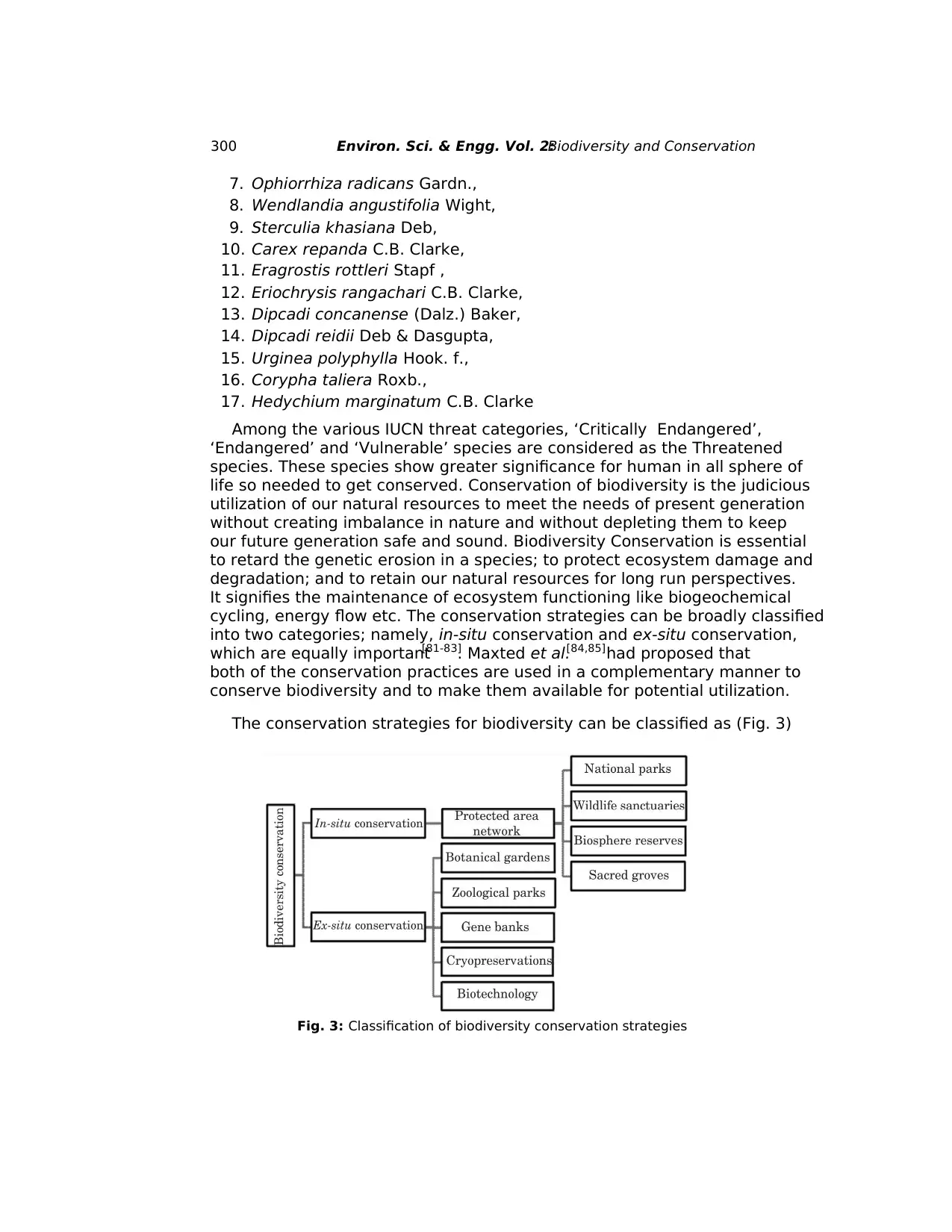
300 Environ. Sci. & Engg. Vol. 2:Biodiversity and Conservation
7. Ophiorrhiza radicans Gardn.,
8. Wendlandia angustifolia Wight,
9. Sterculia khasiana Deb,
10. Carex repanda C.B. Clarke,
11. Eragrostis rottleri Stapf ,
12. Eriochrysis rangachari C.B. Clarke,
13. Dipcadi concanense (Dalz.) Baker,
14. Dipcadi reidii Deb & Dasgupta,
15. Urginea polyphylla Hook. f.,
16. Corypha taliera Roxb.,
17. Hedychium marginatum C.B. Clarke
Among the various IUCN threat categories, ‘Critically Endangered’,
‘Endangered’ and ‘Vulnerable’ species are considered as the Threatened
species. These species show greater significance for human in all sphere of
life so needed to get conserved. Conservation of biodiversity is the judicious
utilization of our natural resources to meet the needs of present generation
without creating imbalance in nature and without depleting them to keep
our future generation safe and sound. Biodiversity Conservation is essential
to retard the genetic erosion in a species; to protect ecosystem damage and
degradation; and to retain our natural resources for long run perspectives.
It signifies the maintenance of ecosystem functioning like biogeochemical
cycling, energy flow etc. The conservation strategies can be broadly classified
into two categories; namely, in-situ conservation and ex-situ conservation,
which are equally important[81-83]
. Maxted et al.[84,85] had proposed that
both of the conservation practices are used in a complementary manner to
conserve biodiversity and to make them available for potential utilization.
The conservation strategies for biodiversity can be classified as (Fig. 3)
Fig. 3: Classification of biodiversity conservation strategies
7. Ophiorrhiza radicans Gardn.,
8. Wendlandia angustifolia Wight,
9. Sterculia khasiana Deb,
10. Carex repanda C.B. Clarke,
11. Eragrostis rottleri Stapf ,
12. Eriochrysis rangachari C.B. Clarke,
13. Dipcadi concanense (Dalz.) Baker,
14. Dipcadi reidii Deb & Dasgupta,
15. Urginea polyphylla Hook. f.,
16. Corypha taliera Roxb.,
17. Hedychium marginatum C.B. Clarke
Among the various IUCN threat categories, ‘Critically Endangered’,
‘Endangered’ and ‘Vulnerable’ species are considered as the Threatened
species. These species show greater significance for human in all sphere of
life so needed to get conserved. Conservation of biodiversity is the judicious
utilization of our natural resources to meet the needs of present generation
without creating imbalance in nature and without depleting them to keep
our future generation safe and sound. Biodiversity Conservation is essential
to retard the genetic erosion in a species; to protect ecosystem damage and
degradation; and to retain our natural resources for long run perspectives.
It signifies the maintenance of ecosystem functioning like biogeochemical
cycling, energy flow etc. The conservation strategies can be broadly classified
into two categories; namely, in-situ conservation and ex-situ conservation,
which are equally important[81-83]
. Maxted et al.[84,85] had proposed that
both of the conservation practices are used in a complementary manner to
conserve biodiversity and to make them available for potential utilization.
The conservation strategies for biodiversity can be classified as (Fig. 3)
Fig. 3: Classification of biodiversity conservation strategies
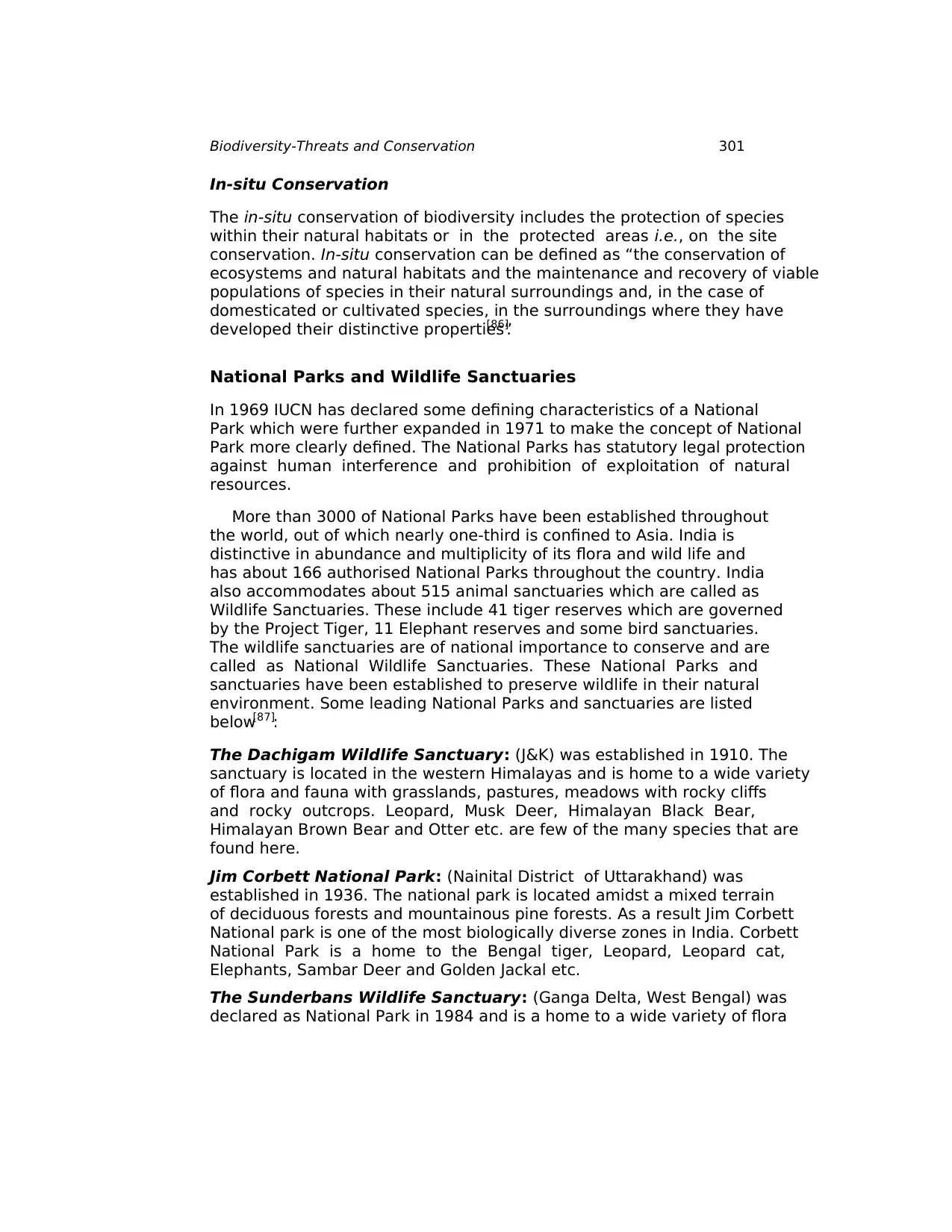
301Biodiversity-Threats and Conservation
In-situ Conservation
The in-situ conservation of biodiversity includes the protection of species
within their natural habitats or in the protected areas i.e., on the site
conservation. In-situ conservation can be defined as “the conservation of
ecosystems and natural habitats and the maintenance and recovery of viable
populations of species in their natural surroundings and, in the case of
domesticated or cultivated species, in the surroundings where they have
developed their distinctive properties”[86]
.
National Parks and Wildlife Sanctuaries
In 1969 IUCN has declared some defining characteristics of a National
Park which were further expanded in 1971 to make the concept of National
Park more clearly defined. The National Parks has statutory legal protection
against human interference and prohibition of exploitation of natural
resources.
More than 3000 of National Parks have been established throughout
the world, out of which nearly one-third is confined to Asia. India is
distinctive in abundance and multiplicity of its flora and wild life and
has about 166 authorised National Parks throughout the country. India
also accommodates about 515 animal sanctuaries which are called as
Wildlife Sanctuaries. These include 41 tiger reserves which are governed
by the Project Tiger, 11 Elephant reserves and some bird sanctuaries.
The wildlife sanctuaries are of national importance to conserve and are
called as National Wildlife Sanctuaries. These National Parks and
sanctuaries have been established to preserve wildlife in their natural
environment. Some leading National Parks and sanctuaries are listed
below[87]:
The Dachigam Wildlife Sanctuary: (J&K) was established in 1910. The
sanctuary is located in the western Himalayas and is home to a wide variety
of flora and fauna with grasslands, pastures, meadows with rocky cliffs
and rocky outcrops. Leopard, Musk Deer, Himalayan Black Bear,
Himalayan Brown Bear and Otter etc. are few of the many species that are
found here.
Jim Corbett National Park: (Nainital District of Uttarakhand) was
established in 1936. The national park is located amidst a mixed terrain
of deciduous forests and mountainous pine forests. As a result Jim Corbett
National park is one of the most biologically diverse zones in India. Corbett
National Park is a home to the Bengal tiger, Leopard, Leopard cat,
Elephants, Sambar Deer and Golden Jackal etc.
The Sunderbans Wildlife Sanctuary: (Ganga Delta, West Bengal) was
declared as National Park in 1984 and is a home to a wide variety of flora
In-situ Conservation
The in-situ conservation of biodiversity includes the protection of species
within their natural habitats or in the protected areas i.e., on the site
conservation. In-situ conservation can be defined as “the conservation of
ecosystems and natural habitats and the maintenance and recovery of viable
populations of species in their natural surroundings and, in the case of
domesticated or cultivated species, in the surroundings where they have
developed their distinctive properties”[86]
.
National Parks and Wildlife Sanctuaries
In 1969 IUCN has declared some defining characteristics of a National
Park which were further expanded in 1971 to make the concept of National
Park more clearly defined. The National Parks has statutory legal protection
against human interference and prohibition of exploitation of natural
resources.
More than 3000 of National Parks have been established throughout
the world, out of which nearly one-third is confined to Asia. India is
distinctive in abundance and multiplicity of its flora and wild life and
has about 166 authorised National Parks throughout the country. India
also accommodates about 515 animal sanctuaries which are called as
Wildlife Sanctuaries. These include 41 tiger reserves which are governed
by the Project Tiger, 11 Elephant reserves and some bird sanctuaries.
The wildlife sanctuaries are of national importance to conserve and are
called as National Wildlife Sanctuaries. These National Parks and
sanctuaries have been established to preserve wildlife in their natural
environment. Some leading National Parks and sanctuaries are listed
below[87]:
The Dachigam Wildlife Sanctuary: (J&K) was established in 1910. The
sanctuary is located in the western Himalayas and is home to a wide variety
of flora and fauna with grasslands, pastures, meadows with rocky cliffs
and rocky outcrops. Leopard, Musk Deer, Himalayan Black Bear,
Himalayan Brown Bear and Otter etc. are few of the many species that are
found here.
Jim Corbett National Park: (Nainital District of Uttarakhand) was
established in 1936. The national park is located amidst a mixed terrain
of deciduous forests and mountainous pine forests. As a result Jim Corbett
National park is one of the most biologically diverse zones in India. Corbett
National Park is a home to the Bengal tiger, Leopard, Leopard cat,
Elephants, Sambar Deer and Golden Jackal etc.
The Sunderbans Wildlife Sanctuary: (Ganga Delta, West Bengal) was
declared as National Park in 1984 and is a home to a wide variety of flora

302 Environ. Sci. & Engg. Vol. 2:Biodiversity and Conservation
and fauna species. These include Tiger, Leopard cat, Fishing Cats and over
70 different species of endemic birds.
Manas Wildlife Sanctuary: (Assam) was established in 1985 and is
located in the foothills of the Himalayas. The sanctuary is a home to a
plethora of rare and endangered species of animals like Tiger, Asian
elephants, Golden Cat, Leopards, Clouded Leopard, Slow Loris and Chital
etc.
Kaziranga National Park: Is located in Assam is known for the largest
population of the Indian one-horned Rhinoceros and Tigers in the world,
The forests are spread across an area of 430 square kilometres and are
home to species like Tigers, Rhinoceros, Elephant, and the Asian water
buffalo, Swamp Deer, Monitor Lizard and Spectacled Cobra etc.
Ranthambore National Park: Is located in Rajasthan and lies between
the confluence of the Banas and the Chambal River. The protected forests
are also famous for their large banyan trees and is enshrines a Medieval
fort. Bengal Tiger, Hyena, Sloth Bear and Chital etc. are some of the rare
species found here.
The Keoladeo Ghana Bird Sanctuary: Was formerly known
as Bharatpur Bird Sanctuary, the Avifauna sanctuary, located in
Rajasthan. It was created around 250 years ago and was named after a
Shiva temple located within the forest by the Rajput King Maharaja Suraj
Mal. Keoladeo Ghana Bird Sanctuary was announced as a bird sanctuary
in 1971 and is famous for housing over 230 species of birds.
The Sasan Gir National Park: Is located in Gujarat and is famous for
its thriving population of the Asiatic Lion. Due to its diverse eco system
and geography, Gir Forest National Park is home to a large variety of species
of flora and fauna. The rare species of animals found here are Asiatic Lions,
Leopards, Sloth Bears, Jungle Cats, Spectacled Cobra and several rare
species of birds are also found here.
Kanha National Park: Is the largest national park in Madhya Pradesh.
The park is characterized by grassy meadows and open bamboo forests.
The rare animal species found in the park are Tigers, Leopards, Wild
dogs, Jackals and Sloth bear etc. The park is also famous as being the
original source of Rudyard Kipling imagination while writing the Jungle
Book although the story was actually set in the Pench National Park in
India. The Kanha National Park was established in 1955 and is visited
by thousands of tourists each year.
Periyar Wildlife Sanctuary: (Kerala) was established in 1928 and is
spread across 305 square kilometres. Being located between the mountain
ridges the protected area is famous for its population of the Indian Tiger
and the Asiatic Elephants. The rare species found here are the Tiger,
Elephant, Travancore flying squirrel, Fruit bat, Giant squirrel, Wild pig
and lion-tailed macaque etc.
and fauna species. These include Tiger, Leopard cat, Fishing Cats and over
70 different species of endemic birds.
Manas Wildlife Sanctuary: (Assam) was established in 1985 and is
located in the foothills of the Himalayas. The sanctuary is a home to a
plethora of rare and endangered species of animals like Tiger, Asian
elephants, Golden Cat, Leopards, Clouded Leopard, Slow Loris and Chital
etc.
Kaziranga National Park: Is located in Assam is known for the largest
population of the Indian one-horned Rhinoceros and Tigers in the world,
The forests are spread across an area of 430 square kilometres and are
home to species like Tigers, Rhinoceros, Elephant, and the Asian water
buffalo, Swamp Deer, Monitor Lizard and Spectacled Cobra etc.
Ranthambore National Park: Is located in Rajasthan and lies between
the confluence of the Banas and the Chambal River. The protected forests
are also famous for their large banyan trees and is enshrines a Medieval
fort. Bengal Tiger, Hyena, Sloth Bear and Chital etc. are some of the rare
species found here.
The Keoladeo Ghana Bird Sanctuary: Was formerly known
as Bharatpur Bird Sanctuary, the Avifauna sanctuary, located in
Rajasthan. It was created around 250 years ago and was named after a
Shiva temple located within the forest by the Rajput King Maharaja Suraj
Mal. Keoladeo Ghana Bird Sanctuary was announced as a bird sanctuary
in 1971 and is famous for housing over 230 species of birds.
The Sasan Gir National Park: Is located in Gujarat and is famous for
its thriving population of the Asiatic Lion. Due to its diverse eco system
and geography, Gir Forest National Park is home to a large variety of species
of flora and fauna. The rare species of animals found here are Asiatic Lions,
Leopards, Sloth Bears, Jungle Cats, Spectacled Cobra and several rare
species of birds are also found here.
Kanha National Park: Is the largest national park in Madhya Pradesh.
The park is characterized by grassy meadows and open bamboo forests.
The rare animal species found in the park are Tigers, Leopards, Wild
dogs, Jackals and Sloth bear etc. The park is also famous as being the
original source of Rudyard Kipling imagination while writing the Jungle
Book although the story was actually set in the Pench National Park in
India. The Kanha National Park was established in 1955 and is visited
by thousands of tourists each year.
Periyar Wildlife Sanctuary: (Kerala) was established in 1928 and is
spread across 305 square kilometres. Being located between the mountain
ridges the protected area is famous for its population of the Indian Tiger
and the Asiatic Elephants. The rare species found here are the Tiger,
Elephant, Travancore flying squirrel, Fruit bat, Giant squirrel, Wild pig
and lion-tailed macaque etc.
Secure Best Marks with AI Grader
Need help grading? Try our AI Grader for instant feedback on your assignments.
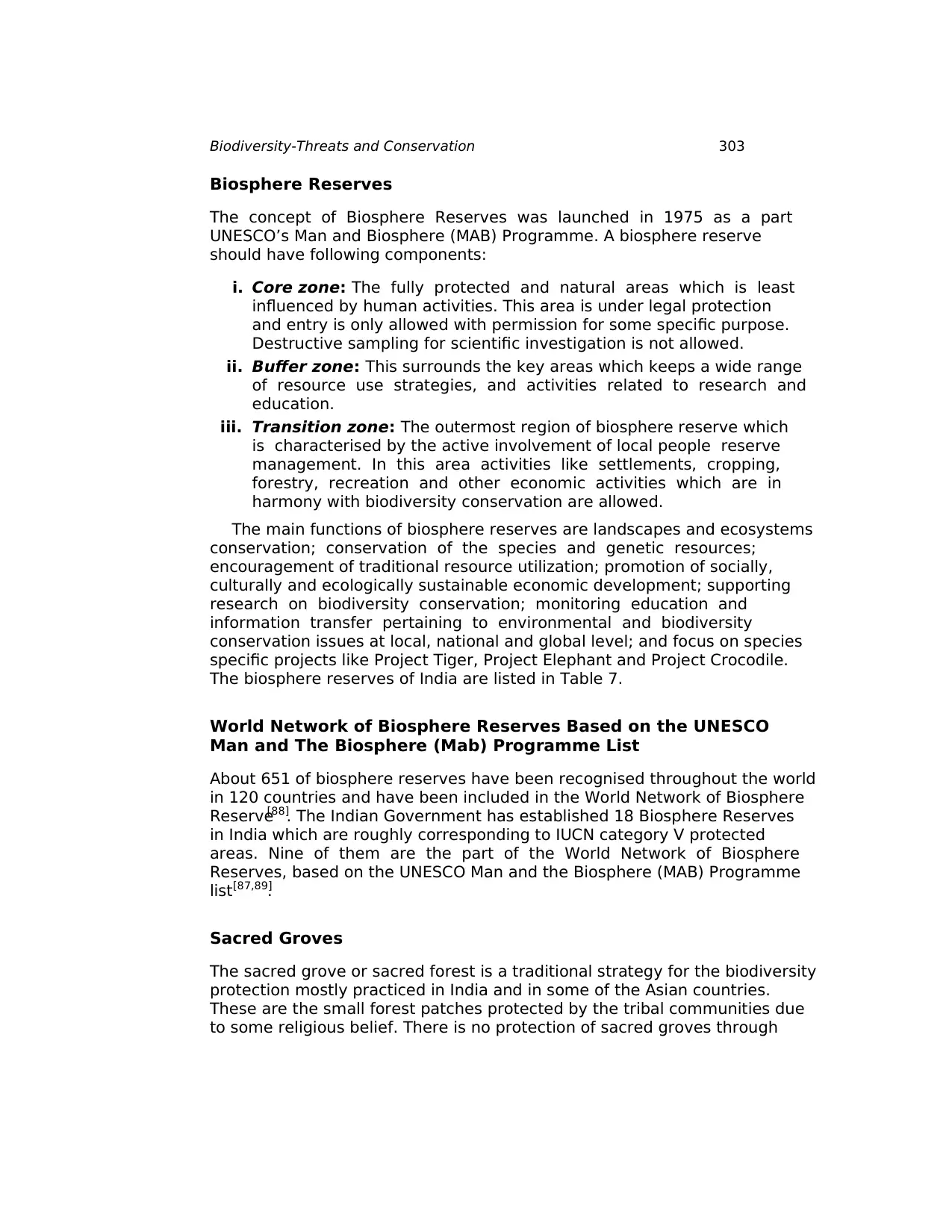
303Biodiversity-Threats and Conservation
Biosphere Reserves
The concept of Biosphere Reserves was launched in 1975 as a part
UNESCO’s Man and Biosphere (MAB) Programme. A biosphere reserve
should have following components:
i. Core zone: The fully protected and natural areas which is least
influenced by human activities. This area is under legal protection
and entry is only allowed with permission for some specific purpose.
Destructive sampling for scientific investigation is not allowed.
ii. Buffer zone: This surrounds the key areas which keeps a wide range
of resource use strategies, and activities related to research and
education.
iii. Transition zone: The outermost region of biosphere reserve which
is characterised by the active involvement of local people reserve
management. In this area activities like settlements, cropping,
forestry, recreation and other economic activities which are in
harmony with biodiversity conservation are allowed.
The main functions of biosphere reserves are landscapes and ecosystems
conservation; conservation of the species and genetic resources;
encouragement of traditional resource utilization; promotion of socially,
culturally and ecologically sustainable economic development; supporting
research on biodiversity conservation; monitoring education and
information transfer pertaining to environmental and biodiversity
conservation issues at local, national and global level; and focus on species
specific projects like Project Tiger, Project Elephant and Project Crocodile.
The biosphere reserves of India are listed in Table 7.
World Network of Biosphere Reserves Based on the UNESCO
Man and The Biosphere (Mab) Programme List
About 651 of biosphere reserves have been recognised throughout the world
in 120 countries and have been included in the World Network of Biosphere
Reserve[88]
. The Indian Government has established 18 Biosphere Reserves
in India which are roughly corresponding to IUCN category V protected
areas. Nine of them are the part of the World Network of Biosphere
Reserves, based on the UNESCO Man and the Biosphere (MAB) Programme
list[87,89]
.
Sacred Groves
The sacred grove or sacred forest is a traditional strategy for the biodiversity
protection mostly practiced in India and in some of the Asian countries.
These are the small forest patches protected by the tribal communities due
to some religious belief. There is no protection of sacred groves through
Biosphere Reserves
The concept of Biosphere Reserves was launched in 1975 as a part
UNESCO’s Man and Biosphere (MAB) Programme. A biosphere reserve
should have following components:
i. Core zone: The fully protected and natural areas which is least
influenced by human activities. This area is under legal protection
and entry is only allowed with permission for some specific purpose.
Destructive sampling for scientific investigation is not allowed.
ii. Buffer zone: This surrounds the key areas which keeps a wide range
of resource use strategies, and activities related to research and
education.
iii. Transition zone: The outermost region of biosphere reserve which
is characterised by the active involvement of local people reserve
management. In this area activities like settlements, cropping,
forestry, recreation and other economic activities which are in
harmony with biodiversity conservation are allowed.
The main functions of biosphere reserves are landscapes and ecosystems
conservation; conservation of the species and genetic resources;
encouragement of traditional resource utilization; promotion of socially,
culturally and ecologically sustainable economic development; supporting
research on biodiversity conservation; monitoring education and
information transfer pertaining to environmental and biodiversity
conservation issues at local, national and global level; and focus on species
specific projects like Project Tiger, Project Elephant and Project Crocodile.
The biosphere reserves of India are listed in Table 7.
World Network of Biosphere Reserves Based on the UNESCO
Man and The Biosphere (Mab) Programme List
About 651 of biosphere reserves have been recognised throughout the world
in 120 countries and have been included in the World Network of Biosphere
Reserve[88]
. The Indian Government has established 18 Biosphere Reserves
in India which are roughly corresponding to IUCN category V protected
areas. Nine of them are the part of the World Network of Biosphere
Reserves, based on the UNESCO Man and the Biosphere (MAB) Programme
list[87,89]
.
Sacred Groves
The sacred grove or sacred forest is a traditional strategy for the biodiversity
protection mostly practiced in India and in some of the Asian countries.
These are the small forest patches protected by the tribal communities due
to some religious belief. There is no protection of sacred groves through
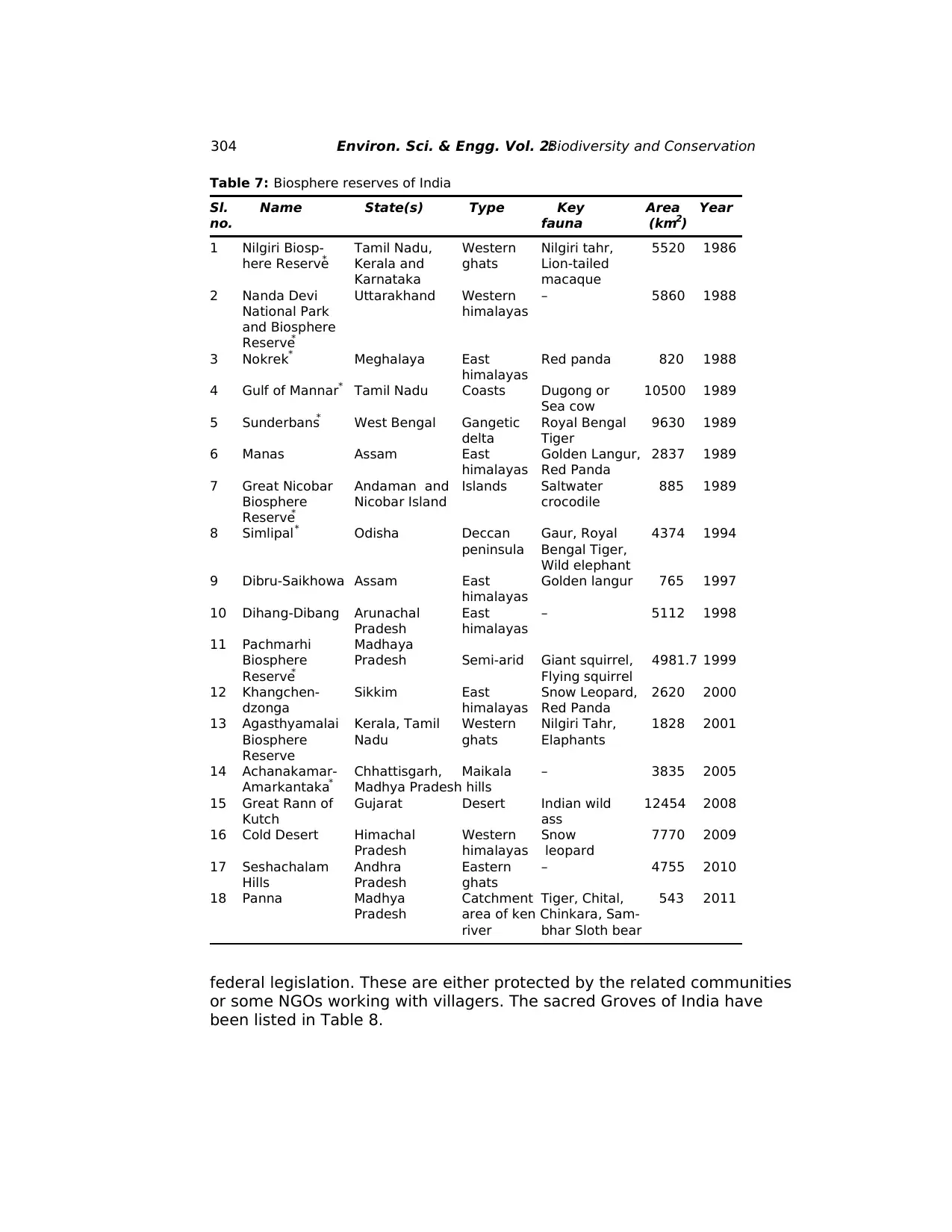
304 Environ. Sci. & Engg. Vol. 2:Biodiversity and Conservation
Table 7: Biosphere reserves of India
Sl. Name State(s) Type Key Area Year
no. fauna (km2)
1 Nilgiri Biosp- Tamil Nadu, Western Nilgiri tahr, 5520 1986
here Reserve* Kerala and ghats Lion-tailed
Karnataka macaque
2 Nanda Devi Uttarakhand Western – 5860 1988
National Park himalayas
and Biosphere
Reserve*
3 Nokrek* Meghalaya East Red panda 820 1988
himalayas
4 Gulf of Mannar* Tamil Nadu Coasts Dugong or 10500 1989
Sea cow
5 Sunderbans* West Bengal Gangetic Royal Bengal 9630 1989
delta Tiger
6 Manas Assam East Golden Langur, 2837 1989
himalayas Red Panda
7 Great Nicobar Andaman and Islands Saltwater 885 1989
Biosphere Nicobar Island crocodile
Reserve*
8 Simlipal* Odisha Deccan Gaur, Royal 4374 1994
peninsula Bengal Tiger,
Wild elephant
9 Dibru-Saikhowa Assam East Golden langur 765 1997
himalayas
10 Dihang-Dibang Arunachal East – 5112 1998
Pradesh himalayas
11 Pachmarhi Madhaya
Biosphere Pradesh Semi-arid Giant squirrel, 4981.7 1999
Reserve* Flying squirrel
12 Khangchen- Sikkim East Snow Leopard, 2620 2000
dzonga himalayas Red Panda
13 Agasthyamalai Kerala, Tamil Western Nilgiri Tahr, 1828 2001
Biosphere Nadu ghats Elaphants
Reserve
14 Achanakamar- Chhattisgarh, Maikala – 3835 2005
Amarkantaka* Madhya Pradesh hills
15 Great Rann of Gujarat Desert Indian wild 12454 2008
Kutch ass
16 Cold Desert Himachal Western Snow 7770 2009
Pradesh himalayas leopard
17 Seshachalam Andhra Eastern – 4755 2010
Hills Pradesh ghats
18 Panna Madhya Catchment Tiger, Chital, 543 2011
Pradesh area of ken Chinkara, Sam-
river bhar Sloth bear
federal legislation. These are either protected by the related communities
or some NGOs working with villagers. The sacred Groves of India have
been listed in Table 8.
Table 7: Biosphere reserves of India
Sl. Name State(s) Type Key Area Year
no. fauna (km2)
1 Nilgiri Biosp- Tamil Nadu, Western Nilgiri tahr, 5520 1986
here Reserve* Kerala and ghats Lion-tailed
Karnataka macaque
2 Nanda Devi Uttarakhand Western – 5860 1988
National Park himalayas
and Biosphere
Reserve*
3 Nokrek* Meghalaya East Red panda 820 1988
himalayas
4 Gulf of Mannar* Tamil Nadu Coasts Dugong or 10500 1989
Sea cow
5 Sunderbans* West Bengal Gangetic Royal Bengal 9630 1989
delta Tiger
6 Manas Assam East Golden Langur, 2837 1989
himalayas Red Panda
7 Great Nicobar Andaman and Islands Saltwater 885 1989
Biosphere Nicobar Island crocodile
Reserve*
8 Simlipal* Odisha Deccan Gaur, Royal 4374 1994
peninsula Bengal Tiger,
Wild elephant
9 Dibru-Saikhowa Assam East Golden langur 765 1997
himalayas
10 Dihang-Dibang Arunachal East – 5112 1998
Pradesh himalayas
11 Pachmarhi Madhaya
Biosphere Pradesh Semi-arid Giant squirrel, 4981.7 1999
Reserve* Flying squirrel
12 Khangchen- Sikkim East Snow Leopard, 2620 2000
dzonga himalayas Red Panda
13 Agasthyamalai Kerala, Tamil Western Nilgiri Tahr, 1828 2001
Biosphere Nadu ghats Elaphants
Reserve
14 Achanakamar- Chhattisgarh, Maikala – 3835 2005
Amarkantaka* Madhya Pradesh hills
15 Great Rann of Gujarat Desert Indian wild 12454 2008
Kutch ass
16 Cold Desert Himachal Western Snow 7770 2009
Pradesh himalayas leopard
17 Seshachalam Andhra Eastern – 4755 2010
Hills Pradesh ghats
18 Panna Madhya Catchment Tiger, Chital, 543 2011
Pradesh area of ken Chinkara, Sam-
river bhar Sloth bear
federal legislation. These are either protected by the related communities
or some NGOs working with villagers. The sacred Groves of India have
been listed in Table 8.
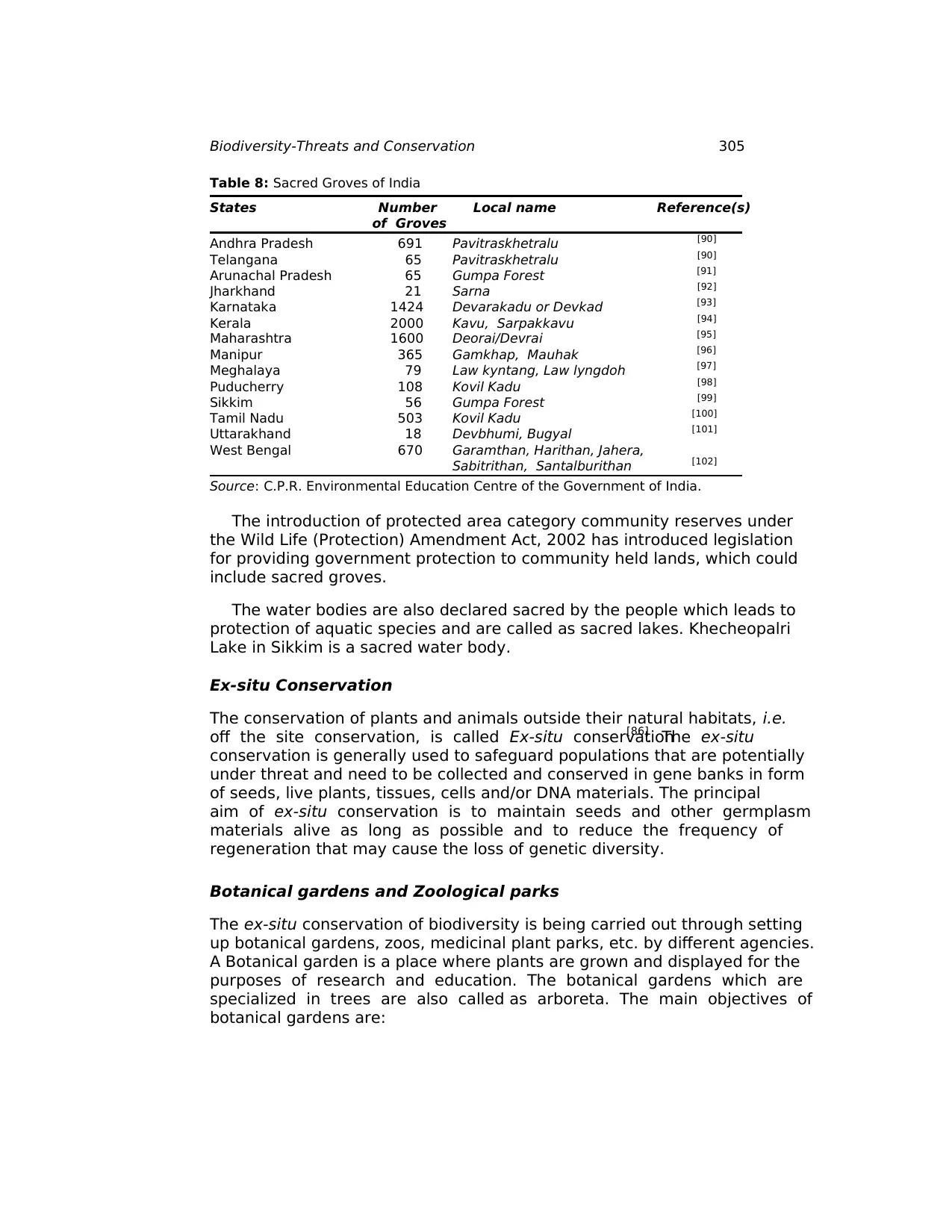
305Biodiversity-Threats and Conservation
Table 8: Sacred Groves of India
States Number Local name Reference(s)
of Groves
Andhra Pradesh 691 Pavitraskhetralu [90]
Telangana 65 Pavitraskhetralu [90]
Arunachal Pradesh 65 Gumpa Forest [91]
Jharkhand 21 Sarna [92]
Karnataka 1424 Devarakadu or Devkad [93]
Kerala 2000 Kavu, Sarpakkavu [94]
Maharashtra 1600 Deorai/Devrai [95]
Manipur 365 Gamkhap, Mauhak [96]
Meghalaya 79 Law kyntang, Law lyngdoh [97]
Puducherry 108 Kovil Kadu [98]
Sikkim 56 Gumpa Forest [99]
Tamil Nadu 503 Kovil Kadu [100]
Uttarakhand 18 Devbhumi, Bugyal [101]
West Bengal 670 Garamthan, Harithan, Jahera,
Sabitrithan, Santalburithan [102]
Source: C.P.R. Environmental Education Centre of the Government of India.
The introduction of protected area category community reserves under
the Wild Life (Protection) Amendment Act, 2002 has introduced legislation
for providing government protection to community held lands, which could
include sacred groves.
The water bodies are also declared sacred by the people which leads to
protection of aquatic species and are called as sacred lakes. Khecheopalri
Lake in Sikkim is a sacred water body.
Ex-situ Conservation
The conservation of plants and animals outside their natural habitats, i.e.
off the site conservation, is called Ex-situ conservation[86]. The ex-situ
conservation is generally used to safeguard populations that are potentially
under threat and need to be collected and conserved in gene banks in form
of seeds, live plants, tissues, cells and/or DNA materials. The principal
aim of ex-situ conservation is to maintain seeds and other germplasm
materials alive as long as possible and to reduce the frequency of
regeneration that may cause the loss of genetic diversity.
Botanical gardens and Zoological parks
The ex-situ conservation of biodiversity is being carried out through setting
up botanical gardens, zoos, medicinal plant parks, etc. by different agencies.
A Botanical garden is a place where plants are grown and displayed for the
purposes of research and education. The botanical gardens which are
specialized in trees are also called as arboreta. The main objectives of
botanical gardens are:
Table 8: Sacred Groves of India
States Number Local name Reference(s)
of Groves
Andhra Pradesh 691 Pavitraskhetralu [90]
Telangana 65 Pavitraskhetralu [90]
Arunachal Pradesh 65 Gumpa Forest [91]
Jharkhand 21 Sarna [92]
Karnataka 1424 Devarakadu or Devkad [93]
Kerala 2000 Kavu, Sarpakkavu [94]
Maharashtra 1600 Deorai/Devrai [95]
Manipur 365 Gamkhap, Mauhak [96]
Meghalaya 79 Law kyntang, Law lyngdoh [97]
Puducherry 108 Kovil Kadu [98]
Sikkim 56 Gumpa Forest [99]
Tamil Nadu 503 Kovil Kadu [100]
Uttarakhand 18 Devbhumi, Bugyal [101]
West Bengal 670 Garamthan, Harithan, Jahera,
Sabitrithan, Santalburithan [102]
Source: C.P.R. Environmental Education Centre of the Government of India.
The introduction of protected area category community reserves under
the Wild Life (Protection) Amendment Act, 2002 has introduced legislation
for providing government protection to community held lands, which could
include sacred groves.
The water bodies are also declared sacred by the people which leads to
protection of aquatic species and are called as sacred lakes. Khecheopalri
Lake in Sikkim is a sacred water body.
Ex-situ Conservation
The conservation of plants and animals outside their natural habitats, i.e.
off the site conservation, is called Ex-situ conservation[86]. The ex-situ
conservation is generally used to safeguard populations that are potentially
under threat and need to be collected and conserved in gene banks in form
of seeds, live plants, tissues, cells and/or DNA materials. The principal
aim of ex-situ conservation is to maintain seeds and other germplasm
materials alive as long as possible and to reduce the frequency of
regeneration that may cause the loss of genetic diversity.
Botanical gardens and Zoological parks
The ex-situ conservation of biodiversity is being carried out through setting
up botanical gardens, zoos, medicinal plant parks, etc. by different agencies.
A Botanical garden is a place where plants are grown and displayed for the
purposes of research and education. The botanical gardens which are
specialized in trees are also called as arboreta. The main objectives of
botanical gardens are:
Paraphrase This Document
Need a fresh take? Get an instant paraphrase of this document with our AI Paraphraser
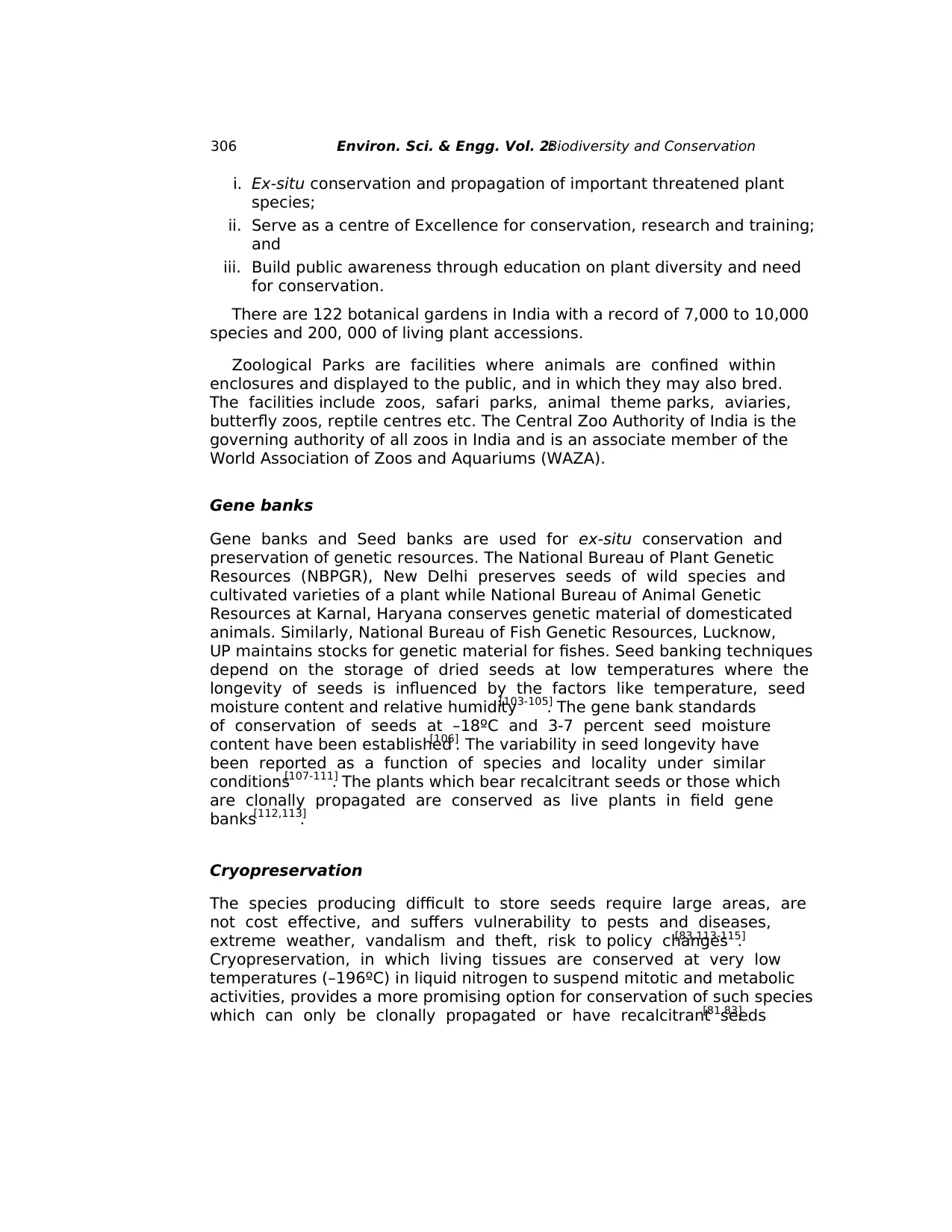
306 Environ. Sci. & Engg. Vol. 2:Biodiversity and Conservation
i. Ex-situ conservation and propagation of important threatened plant
species;
ii. Serve as a centre of Excellence for conservation, research and training;
and
iii. Build public awareness through education on plant diversity and need
for conservation.
There are 122 botanical gardens in India with a record of 7,000 to 10,000
species and 200, 000 of living plant accessions.
Zoological Parks are facilities where animals are confined within
enclosures and displayed to the public, and in which they may also bred.
The facilities include zoos, safari parks, animal theme parks, aviaries,
butterfly zoos, reptile centres etc. The Central Zoo Authority of India is the
governing authority of all zoos in India and is an associate member of the
World Association of Zoos and Aquariums (WAZA).
Gene banks
Gene banks and Seed banks are used for ex-situ conservation and
preservation of genetic resources. The National Bureau of Plant Genetic
Resources (NBPGR), New Delhi preserves seeds of wild species and
cultivated varieties of a plant while National Bureau of Animal Genetic
Resources at Karnal, Haryana conserves genetic material of domesticated
animals. Similarly, National Bureau of Fish Genetic Resources, Lucknow,
UP maintains stocks for genetic material for fishes. Seed banking techniques
depend on the storage of dried seeds at low temperatures where the
longevity of seeds is influenced by the factors like temperature, seed
moisture content and relative humidity[103-105]
. The gene bank standards
of conservation of seeds at –18ºC and 3-7 percent seed moisture
content have been established[106]
. The variability in seed longevity have
been reported as a function of species and locality under similar
conditions[107-111]
. The plants which bear recalcitrant seeds or those which
are clonally propagated are conserved as live plants in field gene
banks[112,113]
.
Cryopreservation
The species producing difficult to store seeds require large areas, are
not cost effective, and suffers vulnerability to pests and diseases,
extreme weather, vandalism and theft, risk to policy changes[83,113-115]
.
Cryopreservation, in which living tissues are conserved at very low
temperatures (–196ºC) in liquid nitrogen to suspend mitotic and metabolic
activities, provides a more promising option for conservation of such species
which can only be clonally propagated or have recalcitrant seeds[81,83]
.
i. Ex-situ conservation and propagation of important threatened plant
species;
ii. Serve as a centre of Excellence for conservation, research and training;
and
iii. Build public awareness through education on plant diversity and need
for conservation.
There are 122 botanical gardens in India with a record of 7,000 to 10,000
species and 200, 000 of living plant accessions.
Zoological Parks are facilities where animals are confined within
enclosures and displayed to the public, and in which they may also bred.
The facilities include zoos, safari parks, animal theme parks, aviaries,
butterfly zoos, reptile centres etc. The Central Zoo Authority of India is the
governing authority of all zoos in India and is an associate member of the
World Association of Zoos and Aquariums (WAZA).
Gene banks
Gene banks and Seed banks are used for ex-situ conservation and
preservation of genetic resources. The National Bureau of Plant Genetic
Resources (NBPGR), New Delhi preserves seeds of wild species and
cultivated varieties of a plant while National Bureau of Animal Genetic
Resources at Karnal, Haryana conserves genetic material of domesticated
animals. Similarly, National Bureau of Fish Genetic Resources, Lucknow,
UP maintains stocks for genetic material for fishes. Seed banking techniques
depend on the storage of dried seeds at low temperatures where the
longevity of seeds is influenced by the factors like temperature, seed
moisture content and relative humidity[103-105]
. The gene bank standards
of conservation of seeds at –18ºC and 3-7 percent seed moisture
content have been established[106]
. The variability in seed longevity have
been reported as a function of species and locality under similar
conditions[107-111]
. The plants which bear recalcitrant seeds or those which
are clonally propagated are conserved as live plants in field gene
banks[112,113]
.
Cryopreservation
The species producing difficult to store seeds require large areas, are
not cost effective, and suffers vulnerability to pests and diseases,
extreme weather, vandalism and theft, risk to policy changes[83,113-115]
.
Cryopreservation, in which living tissues are conserved at very low
temperatures (–196ºC) in liquid nitrogen to suspend mitotic and metabolic
activities, provides a more promising option for conservation of such species
which can only be clonally propagated or have recalcitrant seeds[81,83]
.
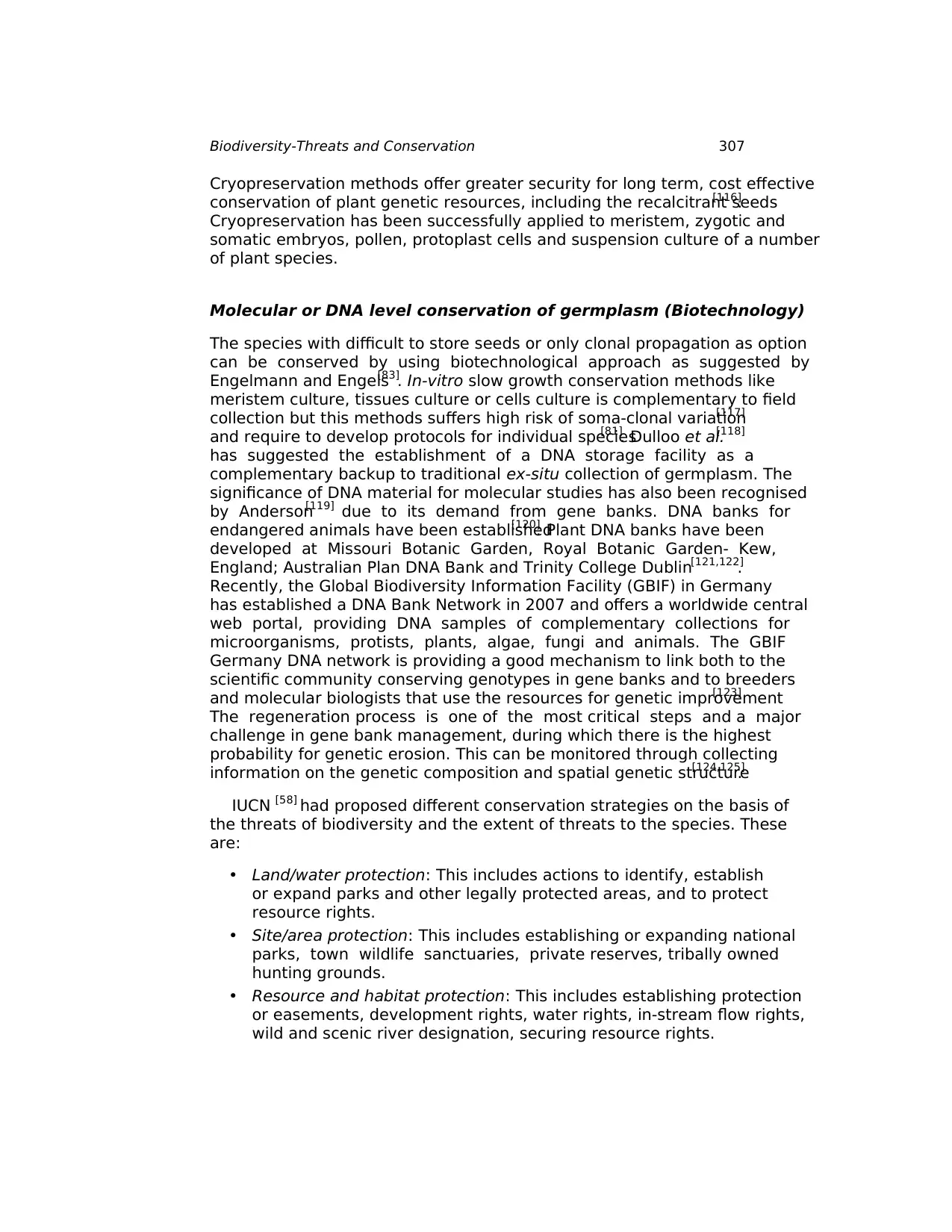
307Biodiversity-Threats and Conservation
Cryopreservation methods offer greater security for long term, cost effective
conservation of plant genetic resources, including the recalcitrant seeds[116]
.
Cryopreservation has been successfully applied to meristem, zygotic and
somatic embryos, pollen, protoplast cells and suspension culture of a number
of plant species.
Molecular or DNA level conservation of germplasm (Biotechnology)
The species with difficult to store seeds or only clonal propagation as option
can be conserved by using biotechnological approach as suggested by
Engelmann and Engels[83]
. In-vitro slow growth conservation methods like
meristem culture, tissues culture or cells culture is complementary to field
collection but this methods suffers high risk of soma-clonal variation[117]
and require to develop protocols for individual species[81]
. Dulloo et al.[118]
has suggested the establishment of a DNA storage facility as a
complementary backup to traditional ex-situ collection of germplasm. The
significance of DNA material for molecular studies has also been recognised
by Anderson[119] due to its demand from gene banks. DNA banks for
endangered animals have been established[120]
. Plant DNA banks have been
developed at Missouri Botanic Garden, Royal Botanic Garden- Kew,
England; Australian Plan DNA Bank and Trinity College Dublin[121,122]
.
Recently, the Global Biodiversity Information Facility (GBIF) in Germany
has established a DNA Bank Network in 2007 and offers a worldwide central
web portal, providing DNA samples of complementary collections for
microorganisms, protists, plants, algae, fungi and animals. The GBIF
Germany DNA network is providing a good mechanism to link both to the
scientific community conserving genotypes in gene banks and to breeders
and molecular biologists that use the resources for genetic improvement[123]
.
The regeneration process is one of the most critical steps and a major
challenge in gene bank management, during which there is the highest
probability for genetic erosion. This can be monitored through collecting
information on the genetic composition and spatial genetic structure[124,125]
.
IUCN [58] had proposed different conservation strategies on the basis of
the threats of biodiversity and the extent of threats to the species. These
are:
• Land/water protection: This includes actions to identify, establish
or expand parks and other legally protected areas, and to protect
resource rights.
• Site/area protection: This includes establishing or expanding national
parks, town wildlife sanctuaries, private reserves, tribally owned
hunting grounds.
• Resource and habitat protection: This includes establishing protection
or easements, development rights, water rights, in-stream flow rights,
wild and scenic river designation, securing resource rights.
Cryopreservation methods offer greater security for long term, cost effective
conservation of plant genetic resources, including the recalcitrant seeds[116]
.
Cryopreservation has been successfully applied to meristem, zygotic and
somatic embryos, pollen, protoplast cells and suspension culture of a number
of plant species.
Molecular or DNA level conservation of germplasm (Biotechnology)
The species with difficult to store seeds or only clonal propagation as option
can be conserved by using biotechnological approach as suggested by
Engelmann and Engels[83]
. In-vitro slow growth conservation methods like
meristem culture, tissues culture or cells culture is complementary to field
collection but this methods suffers high risk of soma-clonal variation[117]
and require to develop protocols for individual species[81]
. Dulloo et al.[118]
has suggested the establishment of a DNA storage facility as a
complementary backup to traditional ex-situ collection of germplasm. The
significance of DNA material for molecular studies has also been recognised
by Anderson[119] due to its demand from gene banks. DNA banks for
endangered animals have been established[120]
. Plant DNA banks have been
developed at Missouri Botanic Garden, Royal Botanic Garden- Kew,
England; Australian Plan DNA Bank and Trinity College Dublin[121,122]
.
Recently, the Global Biodiversity Information Facility (GBIF) in Germany
has established a DNA Bank Network in 2007 and offers a worldwide central
web portal, providing DNA samples of complementary collections for
microorganisms, protists, plants, algae, fungi and animals. The GBIF
Germany DNA network is providing a good mechanism to link both to the
scientific community conserving genotypes in gene banks and to breeders
and molecular biologists that use the resources for genetic improvement[123]
.
The regeneration process is one of the most critical steps and a major
challenge in gene bank management, during which there is the highest
probability for genetic erosion. This can be monitored through collecting
information on the genetic composition and spatial genetic structure[124,125]
.
IUCN [58] had proposed different conservation strategies on the basis of
the threats of biodiversity and the extent of threats to the species. These
are:
• Land/water protection: This includes actions to identify, establish
or expand parks and other legally protected areas, and to protect
resource rights.
• Site/area protection: This includes establishing or expanding national
parks, town wildlife sanctuaries, private reserves, tribally owned
hunting grounds.
• Resource and habitat protection: This includes establishing protection
or easements, development rights, water rights, in-stream flow rights,
wild and scenic river designation, securing resource rights.
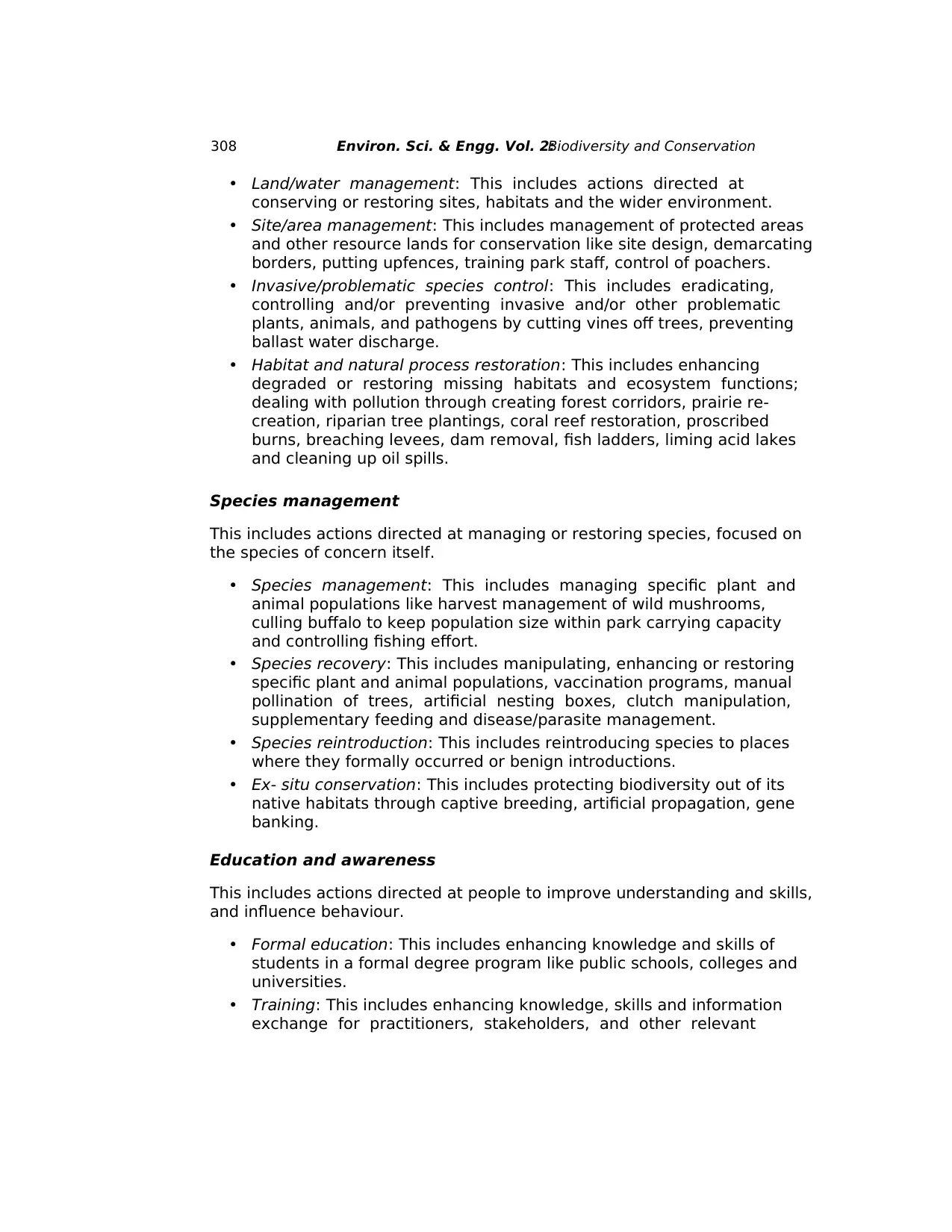
308 Environ. Sci. & Engg. Vol. 2:Biodiversity and Conservation
• Land/water management: This includes actions directed at
conserving or restoring sites, habitats and the wider environment.
• Site/area management: This includes management of protected areas
and other resource lands for conservation like site design, demarcating
borders, putting upfences, training park staff, control of poachers.
• Invasive/problematic species control: This includes eradicating,
controlling and/or preventing invasive and/or other problematic
plants, animals, and pathogens by cutting vines off trees, preventing
ballast water discharge.
• Habitat and natural process restoration: This includes enhancing
degraded or restoring missing habitats and ecosystem functions;
dealing with pollution through creating forest corridors, prairie re-
creation, riparian tree plantings, coral reef restoration, proscribed
burns, breaching levees, dam removal, fish ladders, liming acid lakes
and cleaning up oil spills.
Species management
This includes actions directed at managing or restoring species, focused on
the species of concern itself.
• Species management: This includes managing specific plant and
animal populations like harvest management of wild mushrooms,
culling buffalo to keep population size within park carrying capacity
and controlling fishing effort.
• Species recovery: This includes manipulating, enhancing or restoring
specific plant and animal populations, vaccination programs, manual
pollination of trees, artificial nesting boxes, clutch manipulation,
supplementary feeding and disease/parasite management.
• Species reintroduction: This includes reintroducing species to places
where they formally occurred or benign introductions.
• Ex- situ conservation: This includes protecting biodiversity out of its
native habitats through captive breeding, artificial propagation, gene
banking.
Education and awareness
This includes actions directed at people to improve understanding and skills,
and influence behaviour.
• Formal education: This includes enhancing knowledge and skills of
students in a formal degree program like public schools, colleges and
universities.
• Training: This includes enhancing knowledge, skills and information
exchange for practitioners, stakeholders, and other relevant
• Land/water management: This includes actions directed at
conserving or restoring sites, habitats and the wider environment.
• Site/area management: This includes management of protected areas
and other resource lands for conservation like site design, demarcating
borders, putting upfences, training park staff, control of poachers.
• Invasive/problematic species control: This includes eradicating,
controlling and/or preventing invasive and/or other problematic
plants, animals, and pathogens by cutting vines off trees, preventing
ballast water discharge.
• Habitat and natural process restoration: This includes enhancing
degraded or restoring missing habitats and ecosystem functions;
dealing with pollution through creating forest corridors, prairie re-
creation, riparian tree plantings, coral reef restoration, proscribed
burns, breaching levees, dam removal, fish ladders, liming acid lakes
and cleaning up oil spills.
Species management
This includes actions directed at managing or restoring species, focused on
the species of concern itself.
• Species management: This includes managing specific plant and
animal populations like harvest management of wild mushrooms,
culling buffalo to keep population size within park carrying capacity
and controlling fishing effort.
• Species recovery: This includes manipulating, enhancing or restoring
specific plant and animal populations, vaccination programs, manual
pollination of trees, artificial nesting boxes, clutch manipulation,
supplementary feeding and disease/parasite management.
• Species reintroduction: This includes reintroducing species to places
where they formally occurred or benign introductions.
• Ex- situ conservation: This includes protecting biodiversity out of its
native habitats through captive breeding, artificial propagation, gene
banking.
Education and awareness
This includes actions directed at people to improve understanding and skills,
and influence behaviour.
• Formal education: This includes enhancing knowledge and skills of
students in a formal degree program like public schools, colleges and
universities.
• Training: This includes enhancing knowledge, skills and information
exchange for practitioners, stakeholders, and other relevant
Secure Best Marks with AI Grader
Need help grading? Try our AI Grader for instant feedback on your assignments.
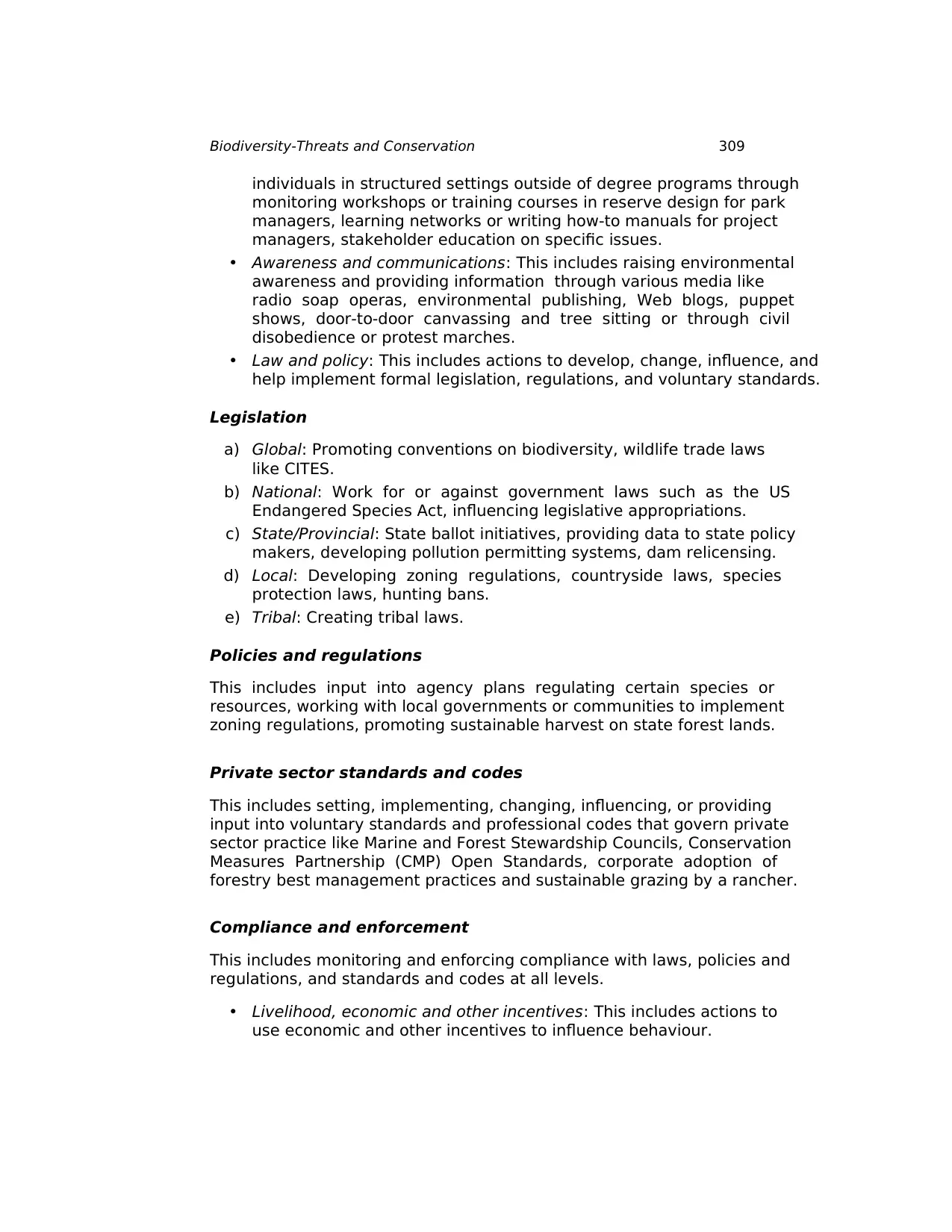
309Biodiversity-Threats and Conservation
individuals in structured settings outside of degree programs through
monitoring workshops or training courses in reserve design for park
managers, learning networks or writing how-to manuals for project
managers, stakeholder education on specific issues.
• Awareness and communications: This includes raising environmental
awareness and providing information through various media like
radio soap operas, environmental publishing, Web blogs, puppet
shows, door-to-door canvassing and tree sitting or through civil
disobedience or protest marches.
• Law and policy: This includes actions to develop, change, influence, and
help implement formal legislation, regulations, and voluntary standards.
Legislation
a) Global: Promoting conventions on biodiversity, wildlife trade laws
like CITES.
b) National: Work for or against government laws such as the US
Endangered Species Act, influencing legislative appropriations.
c) State/Provincial: State ballot initiatives, providing data to state policy
makers, developing pollution permitting systems, dam relicensing.
d) Local: Developing zoning regulations, countryside laws, species
protection laws, hunting bans.
e) Tribal: Creating tribal laws.
Policies and regulations
This includes input into agency plans regulating certain species or
resources, working with local governments or communities to implement
zoning regulations, promoting sustainable harvest on state forest lands.
Private sector standards and codes
This includes setting, implementing, changing, influencing, or providing
input into voluntary standards and professional codes that govern private
sector practice like Marine and Forest Stewardship Councils, Conservation
Measures Partnership (CMP) Open Standards, corporate adoption of
forestry best management practices and sustainable grazing by a rancher.
Compliance and enforcement
This includes monitoring and enforcing compliance with laws, policies and
regulations, and standards and codes at all levels.
• Livelihood, economic and other incentives: This includes actions to
use economic and other incentives to influence behaviour.
individuals in structured settings outside of degree programs through
monitoring workshops or training courses in reserve design for park
managers, learning networks or writing how-to manuals for project
managers, stakeholder education on specific issues.
• Awareness and communications: This includes raising environmental
awareness and providing information through various media like
radio soap operas, environmental publishing, Web blogs, puppet
shows, door-to-door canvassing and tree sitting or through civil
disobedience or protest marches.
• Law and policy: This includes actions to develop, change, influence, and
help implement formal legislation, regulations, and voluntary standards.
Legislation
a) Global: Promoting conventions on biodiversity, wildlife trade laws
like CITES.
b) National: Work for or against government laws such as the US
Endangered Species Act, influencing legislative appropriations.
c) State/Provincial: State ballot initiatives, providing data to state policy
makers, developing pollution permitting systems, dam relicensing.
d) Local: Developing zoning regulations, countryside laws, species
protection laws, hunting bans.
e) Tribal: Creating tribal laws.
Policies and regulations
This includes input into agency plans regulating certain species or
resources, working with local governments or communities to implement
zoning regulations, promoting sustainable harvest on state forest lands.
Private sector standards and codes
This includes setting, implementing, changing, influencing, or providing
input into voluntary standards and professional codes that govern private
sector practice like Marine and Forest Stewardship Councils, Conservation
Measures Partnership (CMP) Open Standards, corporate adoption of
forestry best management practices and sustainable grazing by a rancher.
Compliance and enforcement
This includes monitoring and enforcing compliance with laws, policies and
regulations, and standards and codes at all levels.
• Livelihood, economic and other incentives: This includes actions to
use economic and other incentives to influence behaviour.
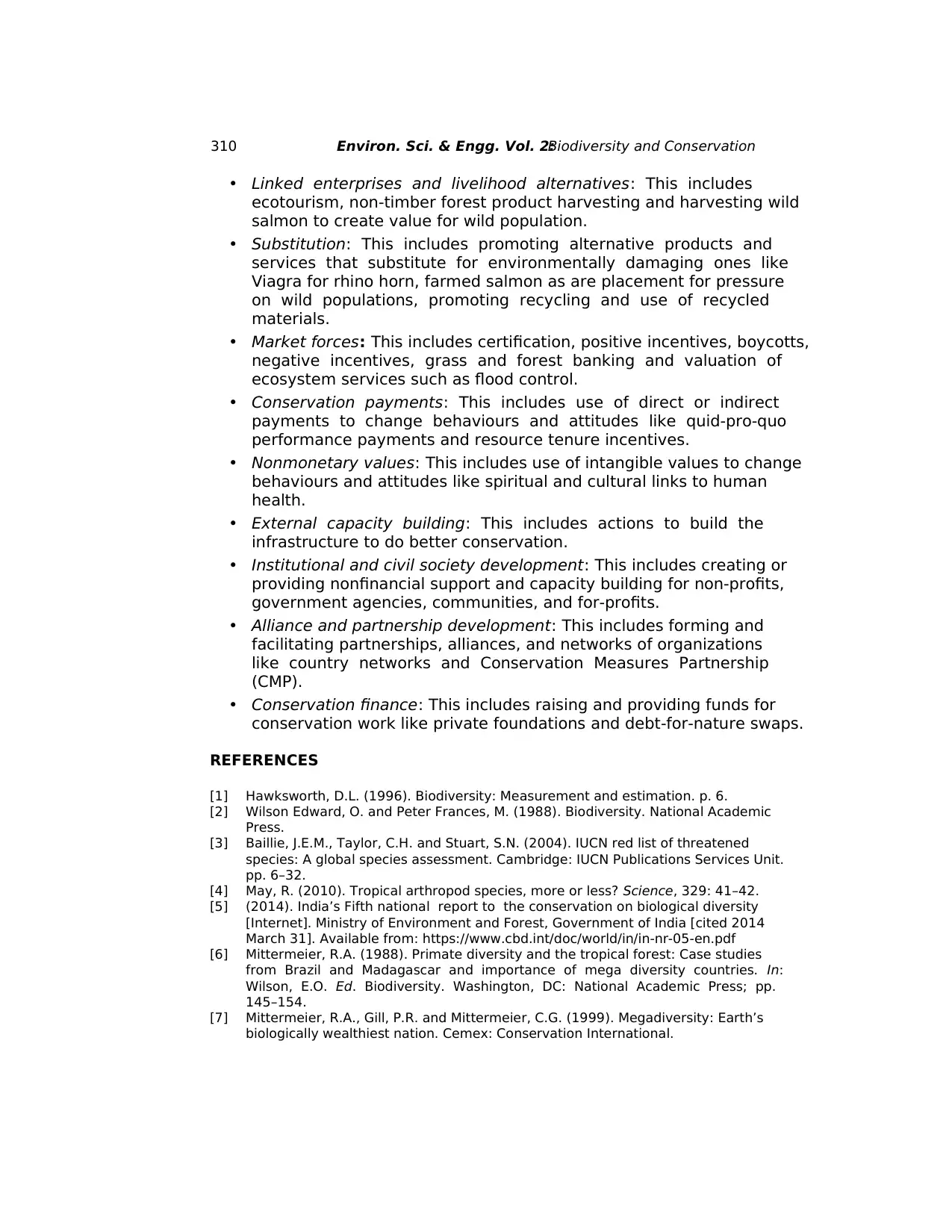
310 Environ. Sci. & Engg. Vol. 2:Biodiversity and Conservation
• Linked enterprises and livelihood alternatives: This includes
ecotourism, non-timber forest product harvesting and harvesting wild
salmon to create value for wild population.
• Substitution: This includes promoting alternative products and
services that substitute for environmentally damaging ones like
Viagra for rhino horn, farmed salmon as are placement for pressure
on wild populations, promoting recycling and use of recycled
materials.
• Market forces: This includes certification, positive incentives, boycotts,
negative incentives, grass and forest banking and valuation of
ecosystem services such as flood control.
• Conservation payments: This includes use of direct or indirect
payments to change behaviours and attitudes like quid-pro-quo
performance payments and resource tenure incentives.
• Nonmonetary values: This includes use of intangible values to change
behaviours and attitudes like spiritual and cultural links to human
health.
• External capacity building: This includes actions to build the
infrastructure to do better conservation.
• Institutional and civil society development: This includes creating or
providing nonfinancial support and capacity building for non-profits,
government agencies, communities, and for-profits.
• Alliance and partnership development: This includes forming and
facilitating partnerships, alliances, and networks of organizations
like country networks and Conservation Measures Partnership
(CMP).
• Conservation finance: This includes raising and providing funds for
conservation work like private foundations and debt-for-nature swaps.
REFERENCES
[1] Hawksworth, D.L. (1996). Biodiversity: Measurement and estimation. p. 6.
[2] Wilson Edward, O. and Peter Frances, M. (1988). Biodiversity. National Academic
Press.
[3] Baillie, J.E.M., Taylor, C.H. and Stuart, S.N. (2004). IUCN red list of threatened
species: A global species assessment. Cambridge: IUCN Publications Services Unit.
pp. 6–32.
[4] May, R. (2010). Tropical arthropod species, more or less? Science, 329: 41–42.
[5] (2014). India’s Fifth national report to the conservation on biological diversity
[Internet]. Ministry of Environment and Forest, Government of India [cited 2014
March 31]. Available from: https://www.cbd.int/doc/world/in/in-nr-05-en.pdf
[6] Mittermeier, R.A. (1988). Primate diversity and the tropical forest: Case studies
from Brazil and Madagascar and importance of mega diversity countries. In:
Wilson, E.O. Ed. Biodiversity. Washington, DC: National Academic Press; pp.
145–154.
[7] Mittermeier, R.A., Gill, P.R. and Mittermeier, C.G. (1999). Megadiversity: Earth’s
biologically wealthiest nation. Cemex: Conservation International.
• Linked enterprises and livelihood alternatives: This includes
ecotourism, non-timber forest product harvesting and harvesting wild
salmon to create value for wild population.
• Substitution: This includes promoting alternative products and
services that substitute for environmentally damaging ones like
Viagra for rhino horn, farmed salmon as are placement for pressure
on wild populations, promoting recycling and use of recycled
materials.
• Market forces: This includes certification, positive incentives, boycotts,
negative incentives, grass and forest banking and valuation of
ecosystem services such as flood control.
• Conservation payments: This includes use of direct or indirect
payments to change behaviours and attitudes like quid-pro-quo
performance payments and resource tenure incentives.
• Nonmonetary values: This includes use of intangible values to change
behaviours and attitudes like spiritual and cultural links to human
health.
• External capacity building: This includes actions to build the
infrastructure to do better conservation.
• Institutional and civil society development: This includes creating or
providing nonfinancial support and capacity building for non-profits,
government agencies, communities, and for-profits.
• Alliance and partnership development: This includes forming and
facilitating partnerships, alliances, and networks of organizations
like country networks and Conservation Measures Partnership
(CMP).
• Conservation finance: This includes raising and providing funds for
conservation work like private foundations and debt-for-nature swaps.
REFERENCES
[1] Hawksworth, D.L. (1996). Biodiversity: Measurement and estimation. p. 6.
[2] Wilson Edward, O. and Peter Frances, M. (1988). Biodiversity. National Academic
Press.
[3] Baillie, J.E.M., Taylor, C.H. and Stuart, S.N. (2004). IUCN red list of threatened
species: A global species assessment. Cambridge: IUCN Publications Services Unit.
pp. 6–32.
[4] May, R. (2010). Tropical arthropod species, more or less? Science, 329: 41–42.
[5] (2014). India’s Fifth national report to the conservation on biological diversity
[Internet]. Ministry of Environment and Forest, Government of India [cited 2014
March 31]. Available from: https://www.cbd.int/doc/world/in/in-nr-05-en.pdf
[6] Mittermeier, R.A. (1988). Primate diversity and the tropical forest: Case studies
from Brazil and Madagascar and importance of mega diversity countries. In:
Wilson, E.O. Ed. Biodiversity. Washington, DC: National Academic Press; pp.
145–154.
[7] Mittermeier, R.A., Gill, P.R. and Mittermeier, C.G. (1999). Megadiversity: Earth’s
biologically wealthiest nation. Cemex: Conservation International.

311Biodiversity-Threats and Conservation
[8] Myers, N. (1988). Threatened biotas: ‘Hot spots’ in t r o pic al
forests. Environmentalist, 8(3): 187–208.
[9] Myers, N. (1990). The biodiversity challenge: Expanded hot-spots analysis.
Environmentalist, 10(4): 243–256.
[10] Myers, N., Mittermeier, R.A., Mittermeier, C.G., da Fonseca, G.A.B. and Kent, J.
(2010). Biodiversity hotspots for conservation priorities. Nature, 403: 853–858
[11] Tittensor, D. et al. (2011). Global patterns and predictors of marine biodiversity
across taxa. Nature, 466(7310): 1098–1101.
[12] Jeffrey, K. (2004). Sparing nature: The conflict between human population growth
and earth’s biodiversity. Rutgers University Press.
[13] Campbell, A.K. (2003). Save those molecules: Molecular biodiversity and life. J.
Appl. Ecol., 40(2): 193–203.
[14] Golelli, N.J. and Chao, A. (2013). Measuring and estimating species richness,
species diversity, and biotic similarity from sampling data. 2nd ed. In: Levin, S.A.
Ed. Encyclopedia of Biodiversity. Waltham MA: Academic Press. pp. 195–211.
[15] Whittacker, R.H. (1960). Vegetation of the Siskiyou Mountain, Oregon and
California. Ecol. Monogr., 30(4): 279–338.
[16] Pielou, E.C. (1974). Population and community ecology: Principles and methods.
New York: Gorden and Breach.
[17] Pielou, E.C. (1975). Ecologycal Diversity. New York: Willey.
[18] Odum, H.T., Cantlon, J.E. and Kornicker, L.S. (1960). An organizational hierarchy
postulate for the interpretation of species – individual distributions, species
entropy, ecosystem evolution, and the meaning of species-variety index. Ecology,
41(2): 395–399.
[19] Menhinick, E.F. (1964). A comparison of some species- individuals diversity indices
applied to samples of field insect. Ecology, 45(4): 859–861.
[20] Elton, C.S. (1958). The Ecology of invasions by animals and plants. London: The
University of Chicago Press.
[21] Tilman, D. (1985). The resource ratio hypothesis of plant succession. Am. Nat.,
125: 827–852.
[22] Tilman, D. (1990). Constraints and trade-offs: Towards a predictive theory of
competition and succession. Oikos, 58: 3–15.
[23] Whittacker, R.H. (1972). Evolution and measurement of species diversity. Taxon,
21: 213–251.
[24] Whittacker, R.H. (1977). Evolution of species diversity in land communities. Evol.
Biol., 10: 1–67.
[25] Reice, S.R. (1994). Non-equilibrium determinants of Biological community
structure. Am. Sci., 58: 3–15.
[26] Reece, J.B., Reece, J.E.A., Meyers, N., Urry, L.A., Cain, M.L., Wasserman, S.A. et
al. (2014). Campbell biology: Australian and New Zealand Edition. 10th ed. Pearson
Education Australia.
[27] Tilman, D., Reich, P.B., Knops, J., Wedin, D. and Mieke Lehman, T. (2001).
Diversity and productivity in long term grassland experiment. Science, 294: 843–
845.
[28] UN CBD [Internet] (2010). The importance of biodiversity to human health.
Retrieved from Cohabinitiative: Co-operation on Health and Biodiversity; 2010
[cited 2010 October]. Available from: https://www.cbd.int/doc/health/cohab-policy-
brief1-en.pdf
[29] Brundtland, G.H. (1987). World commission on environment and development:
Our Common Future. Oxford: Oxford University Press.
[30] (1999). Board on sustainable development National Research Council. Our common
journey: A transition towards Sustainability. Washington DC: National Academy
Press.
[31] Tilman, D. (1994). Completion and biodiversity in spatially structured habitats.
Ecology, 75: 2–16.
[8] Myers, N. (1988). Threatened biotas: ‘Hot spots’ in t r o pic al
forests. Environmentalist, 8(3): 187–208.
[9] Myers, N. (1990). The biodiversity challenge: Expanded hot-spots analysis.
Environmentalist, 10(4): 243–256.
[10] Myers, N., Mittermeier, R.A., Mittermeier, C.G., da Fonseca, G.A.B. and Kent, J.
(2010). Biodiversity hotspots for conservation priorities. Nature, 403: 853–858
[11] Tittensor, D. et al. (2011). Global patterns and predictors of marine biodiversity
across taxa. Nature, 466(7310): 1098–1101.
[12] Jeffrey, K. (2004). Sparing nature: The conflict between human population growth
and earth’s biodiversity. Rutgers University Press.
[13] Campbell, A.K. (2003). Save those molecules: Molecular biodiversity and life. J.
Appl. Ecol., 40(2): 193–203.
[14] Golelli, N.J. and Chao, A. (2013). Measuring and estimating species richness,
species diversity, and biotic similarity from sampling data. 2nd ed. In: Levin, S.A.
Ed. Encyclopedia of Biodiversity. Waltham MA: Academic Press. pp. 195–211.
[15] Whittacker, R.H. (1960). Vegetation of the Siskiyou Mountain, Oregon and
California. Ecol. Monogr., 30(4): 279–338.
[16] Pielou, E.C. (1974). Population and community ecology: Principles and methods.
New York: Gorden and Breach.
[17] Pielou, E.C. (1975). Ecologycal Diversity. New York: Willey.
[18] Odum, H.T., Cantlon, J.E. and Kornicker, L.S. (1960). An organizational hierarchy
postulate for the interpretation of species – individual distributions, species
entropy, ecosystem evolution, and the meaning of species-variety index. Ecology,
41(2): 395–399.
[19] Menhinick, E.F. (1964). A comparison of some species- individuals diversity indices
applied to samples of field insect. Ecology, 45(4): 859–861.
[20] Elton, C.S. (1958). The Ecology of invasions by animals and plants. London: The
University of Chicago Press.
[21] Tilman, D. (1985). The resource ratio hypothesis of plant succession. Am. Nat.,
125: 827–852.
[22] Tilman, D. (1990). Constraints and trade-offs: Towards a predictive theory of
competition and succession. Oikos, 58: 3–15.
[23] Whittacker, R.H. (1972). Evolution and measurement of species diversity. Taxon,
21: 213–251.
[24] Whittacker, R.H. (1977). Evolution of species diversity in land communities. Evol.
Biol., 10: 1–67.
[25] Reice, S.R. (1994). Non-equilibrium determinants of Biological community
structure. Am. Sci., 58: 3–15.
[26] Reece, J.B., Reece, J.E.A., Meyers, N., Urry, L.A., Cain, M.L., Wasserman, S.A. et
al. (2014). Campbell biology: Australian and New Zealand Edition. 10th ed. Pearson
Education Australia.
[27] Tilman, D., Reich, P.B., Knops, J., Wedin, D. and Mieke Lehman, T. (2001).
Diversity and productivity in long term grassland experiment. Science, 294: 843–
845.
[28] UN CBD [Internet] (2010). The importance of biodiversity to human health.
Retrieved from Cohabinitiative: Co-operation on Health and Biodiversity; 2010
[cited 2010 October]. Available from: https://www.cbd.int/doc/health/cohab-policy-
brief1-en.pdf
[29] Brundtland, G.H. (1987). World commission on environment and development:
Our Common Future. Oxford: Oxford University Press.
[30] (1999). Board on sustainable development National Research Council. Our common
journey: A transition towards Sustainability. Washington DC: National Academy
Press.
[31] Tilman, D. (1994). Completion and biodiversity in spatially structured habitats.
Ecology, 75: 2–16.
Paraphrase This Document
Need a fresh take? Get an instant paraphrase of this document with our AI Paraphraser
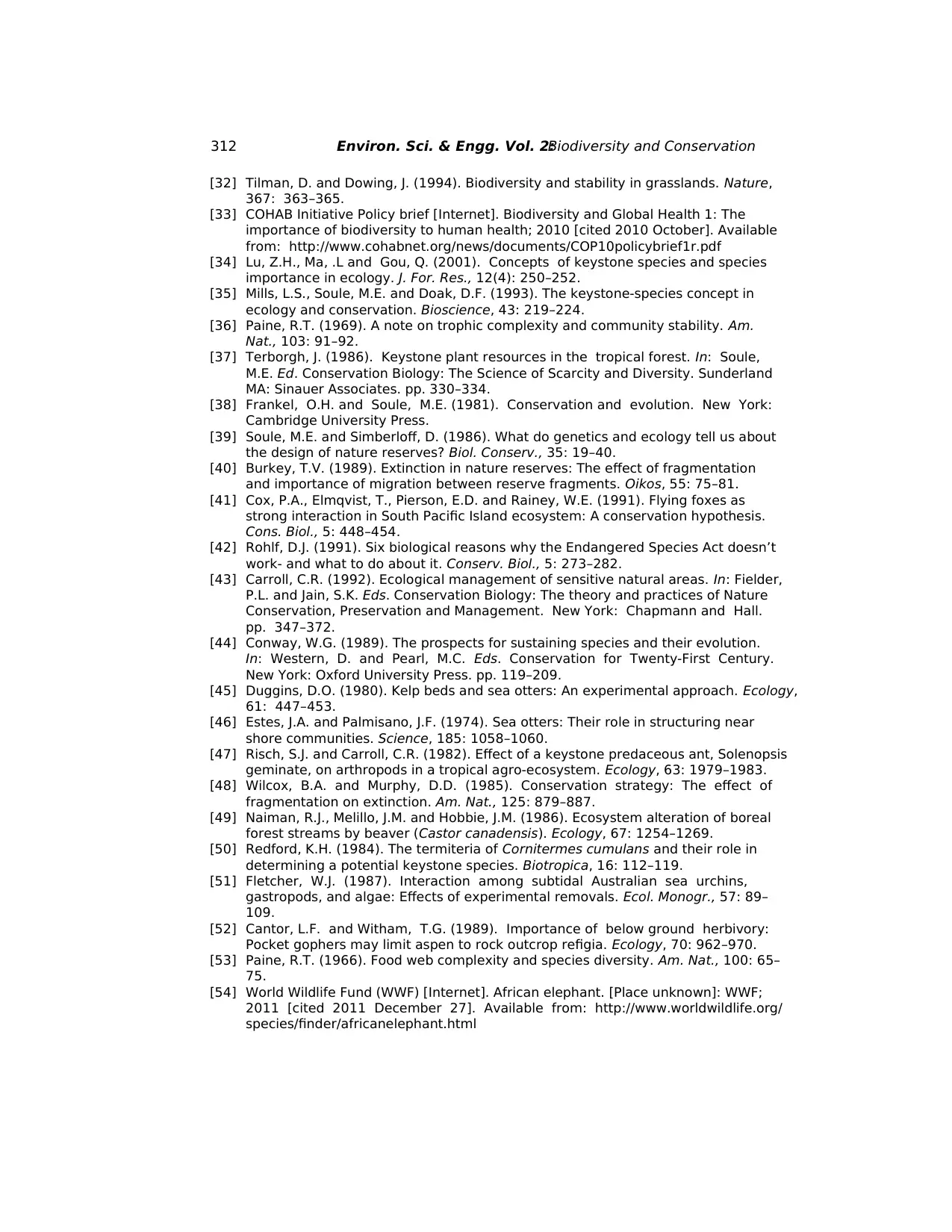
312 Environ. Sci. & Engg. Vol. 2:Biodiversity and Conservation
[32] Tilman, D. and Dowing, J. (1994). Biodiversity and stability in grasslands. Nature,
367: 363–365.
[33] COHAB Initiative Policy brief [Internet]. Biodiversity and Global Health 1: The
importance of biodiversity to human health; 2010 [cited 2010 October]. Available
from: http://www.cohabnet.org/news/documents/COP10policybrief1r.pdf
[34] Lu, Z.H., Ma, .L and Gou, Q. (2001). Concepts of keystone species and species
importance in ecology. J. For. Res., 12(4): 250–252.
[35] Mills, L.S., Soule, M.E. and Doak, D.F. (1993). The keystone-species concept in
ecology and conservation. Bioscience, 43: 219–224.
[36] Paine, R.T. (1969). A note on trophic complexity and community stability. Am.
Nat., 103: 91–92.
[37] Terborgh, J. (1986). Keystone plant resources in the tropical forest. In: Soule,
M.E. Ed. Conservation Biology: The Science of Scarcity and Diversity. Sunderland
MA: Sinauer Associates. pp. 330–334.
[38] Frankel, O.H. and Soule, M.E. (1981). Conservation and evolution. New York:
Cambridge University Press.
[39] Soule, M.E. and Simberloff, D. (1986). What do genetics and ecology tell us about
the design of nature reserves? Biol. Conserv., 35: 19–40.
[40] Burkey, T.V. (1989). Extinction in nature reserves: The effect of fragmentation
and importance of migration between reserve fragments. Oikos, 55: 75–81.
[41] Cox, P.A., Elmqvist, T., Pierson, E.D. and Rainey, W.E. (1991). Flying foxes as
strong interaction in South Pacific Island ecosystem: A conservation hypothesis.
Cons. Biol., 5: 448–454.
[42] Rohlf, D.J. (1991). Six biological reasons why the Endangered Species Act doesn’t
work- and what to do about it. Conserv. Biol., 5: 273–282.
[43] Carroll, C.R. (1992). Ecological management of sensitive natural areas. In: Fielder,
P.L. and Jain, S.K. Eds. Conservation Biology: The theory and practices of Nature
Conservation, Preservation and Management. New York: Chapmann and Hall.
pp. 347–372.
[44] Conway, W.G. (1989). The prospects for sustaining species and their evolution.
In: Western, D. and Pearl, M.C. Eds. Conservation for Twenty-First Century.
New York: Oxford University Press. pp. 119–209.
[45] Duggins, D.O. (1980). Kelp beds and sea otters: An experimental approach. Ecology,
61: 447–453.
[46] Estes, J.A. and Palmisano, J.F. (1974). Sea otters: Their role in structuring near
shore communities. Science, 185: 1058–1060.
[47] Risch, S.J. and Carroll, C.R. (1982). Effect of a keystone predaceous ant, Solenopsis
geminate, on arthropods in a tropical agro-ecosystem. Ecology, 63: 1979–1983.
[48] Wilcox, B.A. and Murphy, D.D. (1985). Conservation strategy: The effect of
fragmentation on extinction. Am. Nat., 125: 879–887.
[49] Naiman, R.J., Melillo, J.M. and Hobbie, J.M. (1986). Ecosystem alteration of boreal
forest streams by beaver (Castor canadensis). Ecology, 67: 1254–1269.
[50] Redford, K.H. (1984). The termiteria of Cornitermes cumulans and their role in
determining a potential keystone species. Biotropica, 16: 112–119.
[51] Fletcher, W.J. (1987). Interaction among subtidal Australian sea urchins,
gastropods, and algae: Effects of experimental removals. Ecol. Monogr., 57: 89–
109.
[52] Cantor, L.F. and Witham, T.G. (1989). Importance of below ground herbivory:
Pocket gophers may limit aspen to rock outcrop refigia. Ecology, 70: 962–970.
[53] Paine, R.T. (1966). Food web complexity and species diversity. Am. Nat., 100: 65–
75.
[54] World Wildlife Fund (WWF) [Internet]. African elephant. [Place unknown]: WWF;
2011 [cited 2011 December 27]. Available from: http://www.worldwildlife.org/
species/finder/africanelephant.html
[32] Tilman, D. and Dowing, J. (1994). Biodiversity and stability in grasslands. Nature,
367: 363–365.
[33] COHAB Initiative Policy brief [Internet]. Biodiversity and Global Health 1: The
importance of biodiversity to human health; 2010 [cited 2010 October]. Available
from: http://www.cohabnet.org/news/documents/COP10policybrief1r.pdf
[34] Lu, Z.H., Ma, .L and Gou, Q. (2001). Concepts of keystone species and species
importance in ecology. J. For. Res., 12(4): 250–252.
[35] Mills, L.S., Soule, M.E. and Doak, D.F. (1993). The keystone-species concept in
ecology and conservation. Bioscience, 43: 219–224.
[36] Paine, R.T. (1969). A note on trophic complexity and community stability. Am.
Nat., 103: 91–92.
[37] Terborgh, J. (1986). Keystone plant resources in the tropical forest. In: Soule,
M.E. Ed. Conservation Biology: The Science of Scarcity and Diversity. Sunderland
MA: Sinauer Associates. pp. 330–334.
[38] Frankel, O.H. and Soule, M.E. (1981). Conservation and evolution. New York:
Cambridge University Press.
[39] Soule, M.E. and Simberloff, D. (1986). What do genetics and ecology tell us about
the design of nature reserves? Biol. Conserv., 35: 19–40.
[40] Burkey, T.V. (1989). Extinction in nature reserves: The effect of fragmentation
and importance of migration between reserve fragments. Oikos, 55: 75–81.
[41] Cox, P.A., Elmqvist, T., Pierson, E.D. and Rainey, W.E. (1991). Flying foxes as
strong interaction in South Pacific Island ecosystem: A conservation hypothesis.
Cons. Biol., 5: 448–454.
[42] Rohlf, D.J. (1991). Six biological reasons why the Endangered Species Act doesn’t
work- and what to do about it. Conserv. Biol., 5: 273–282.
[43] Carroll, C.R. (1992). Ecological management of sensitive natural areas. In: Fielder,
P.L. and Jain, S.K. Eds. Conservation Biology: The theory and practices of Nature
Conservation, Preservation and Management. New York: Chapmann and Hall.
pp. 347–372.
[44] Conway, W.G. (1989). The prospects for sustaining species and their evolution.
In: Western, D. and Pearl, M.C. Eds. Conservation for Twenty-First Century.
New York: Oxford University Press. pp. 119–209.
[45] Duggins, D.O. (1980). Kelp beds and sea otters: An experimental approach. Ecology,
61: 447–453.
[46] Estes, J.A. and Palmisano, J.F. (1974). Sea otters: Their role in structuring near
shore communities. Science, 185: 1058–1060.
[47] Risch, S.J. and Carroll, C.R. (1982). Effect of a keystone predaceous ant, Solenopsis
geminate, on arthropods in a tropical agro-ecosystem. Ecology, 63: 1979–1983.
[48] Wilcox, B.A. and Murphy, D.D. (1985). Conservation strategy: The effect of
fragmentation on extinction. Am. Nat., 125: 879–887.
[49] Naiman, R.J., Melillo, J.M. and Hobbie, J.M. (1986). Ecosystem alteration of boreal
forest streams by beaver (Castor canadensis). Ecology, 67: 1254–1269.
[50] Redford, K.H. (1984). The termiteria of Cornitermes cumulans and their role in
determining a potential keystone species. Biotropica, 16: 112–119.
[51] Fletcher, W.J. (1987). Interaction among subtidal Australian sea urchins,
gastropods, and algae: Effects of experimental removals. Ecol. Monogr., 57: 89–
109.
[52] Cantor, L.F. and Witham, T.G. (1989). Importance of below ground herbivory:
Pocket gophers may limit aspen to rock outcrop refigia. Ecology, 70: 962–970.
[53] Paine, R.T. (1966). Food web complexity and species diversity. Am. Nat., 100: 65–
75.
[54] World Wildlife Fund (WWF) [Internet]. African elephant. [Place unknown]: WWF;
2011 [cited 2011 December 27]. Available from: http://www.worldwildlife.org/
species/finder/africanelephant.html
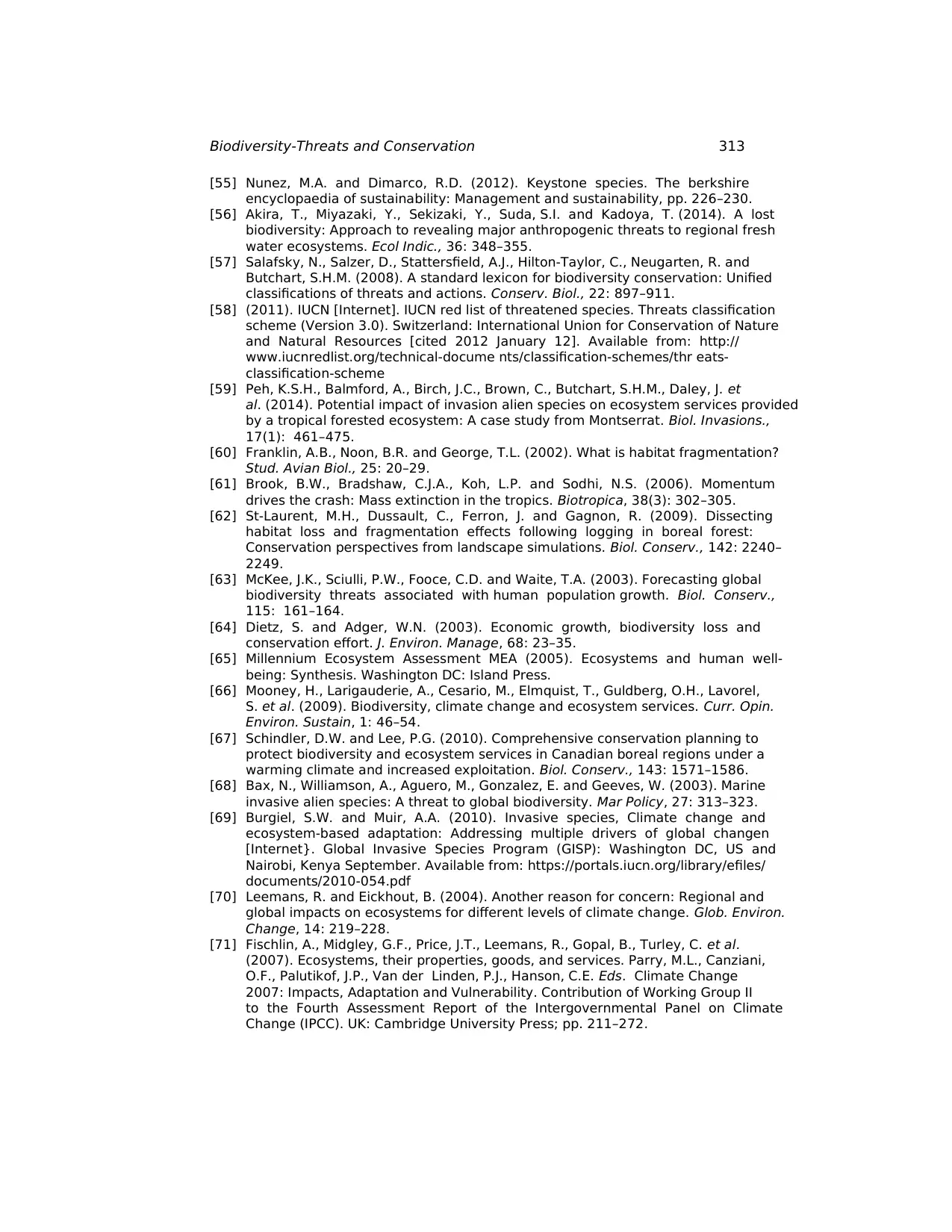
313Biodiversity-Threats and Conservation
[55] Nunez, M.A. and Dimarco, R.D. (2012). Keystone species. The berkshire
encyclopaedia of sustainability: Management and sustainability, pp. 226–230.
[56] Akira, T., Miyazaki, Y., Sekizaki, Y., Suda, S.I. and Kadoya, T. (2014). A lost
biodiversity: Approach to revealing major anthropogenic threats to regional fresh
water ecosystems. Ecol Indic., 36: 348–355.
[57] Salafsky, N., Salzer, D., Stattersfield, A.J., Hilton-Taylor, C., Neugarten, R. and
Butchart, S.H.M. (2008). A standard lexicon for biodiversity conservation: Unified
classifications of threats and actions. Conserv. Biol., 22: 897–911.
[58] (2011). IUCN [Internet]. IUCN red list of threatened species. Threats classification
scheme (Version 3.0). Switzerland: International Union for Conservation of Nature
and Natural Resources [cited 2012 January 12]. Available from: http://
www.iucnredlist.org/technical-docume nts/classification-schemes/thr eats-
classification-scheme
[59] Peh, K.S.H., Balmford, A., Birch, J.C., Brown, C., Butchart, S.H.M., Daley, J. et
al. (2014). Potential impact of invasion alien species on ecosystem services provided
by a tropical forested ecosystem: A case study from Montserrat. Biol. Invasions.,
17(1): 461–475.
[60] Franklin, A.B., Noon, B.R. and George, T.L. (2002). What is habitat fragmentation?
Stud. Avian Biol., 25: 20–29.
[61] Brook, B.W., Bradshaw, C.J.A., Koh, L.P. and Sodhi, N.S. (2006). Momentum
drives the crash: Mass extinction in the tropics. Biotropica, 38(3): 302–305.
[62] St-Laurent, M.H., Dussault, C., Ferron, J. and Gagnon, R. (2009). Dissecting
habitat loss and fragmentation effects following logging in boreal forest:
Conservation perspectives from landscape simulations. Biol. Conserv., 142: 2240–
2249.
[63] McKee, J.K., Sciulli, P.W., Fooce, C.D. and Waite, T.A. (2003). Forecasting global
biodiversity threats associated with human population growth. Biol. Conserv.,
115: 161–164.
[64] Dietz, S. and Adger, W.N. (2003). Economic growth, biodiversity loss and
conservation effort. J. Environ. Manage, 68: 23–35.
[65] Millennium Ecosystem Assessment MEA (2005). Ecosystems and human well-
being: Synthesis. Washington DC: Island Press.
[66] Mooney, H., Larigauderie, A., Cesario, M., Elmquist, T., Guldberg, O.H., Lavorel,
S. et al. (2009). Biodiversity, climate change and ecosystem services. Curr. Opin.
Environ. Sustain, 1: 46–54.
[67] Schindler, D.W. and Lee, P.G. (2010). Comprehensive conservation planning to
protect biodiversity and ecosystem services in Canadian boreal regions under a
warming climate and increased exploitation. Biol. Conserv., 143: 1571–1586.
[68] Bax, N., Williamson, A., Aguero, M., Gonzalez, E. and Geeves, W. (2003). Marine
invasive alien species: A threat to global biodiversity. Mar Policy, 27: 313–323.
[69] Burgiel, S.W. and Muir, A.A. (2010). Invasive species, Climate change and
ecosystem-based adaptation: Addressing multiple drivers of global changen
[Internet}. Global Invasive Species Program (GISP): Washington DC, US and
Nairobi, Kenya September. Available from: https://portals.iucn.org/library/efiles/
documents/2010-054.pdf
[70] Leemans, R. and Eickhout, B. (2004). Another reason for concern: Regional and
global impacts on ecosystems for different levels of climate change. Glob. Environ.
Change, 14: 219–228.
[71] Fischlin, A., Midgley, G.F., Price, J.T., Leemans, R., Gopal, B., Turley, C. et al.
(2007). Ecosystems, their properties, goods, and services. Parry, M.L., Canziani,
O.F., Palutikof, J.P., Van der Linden, P.J., Hanson, C.E. Eds. Climate Change
2007: Impacts, Adaptation and Vulnerability. Contribution of Working Group II
to the Fourth Assessment Report of the Intergovernmental Panel on Climate
Change (IPCC). UK: Cambridge University Press; pp. 211–272.
[55] Nunez, M.A. and Dimarco, R.D. (2012). Keystone species. The berkshire
encyclopaedia of sustainability: Management and sustainability, pp. 226–230.
[56] Akira, T., Miyazaki, Y., Sekizaki, Y., Suda, S.I. and Kadoya, T. (2014). A lost
biodiversity: Approach to revealing major anthropogenic threats to regional fresh
water ecosystems. Ecol Indic., 36: 348–355.
[57] Salafsky, N., Salzer, D., Stattersfield, A.J., Hilton-Taylor, C., Neugarten, R. and
Butchart, S.H.M. (2008). A standard lexicon for biodiversity conservation: Unified
classifications of threats and actions. Conserv. Biol., 22: 897–911.
[58] (2011). IUCN [Internet]. IUCN red list of threatened species. Threats classification
scheme (Version 3.0). Switzerland: International Union for Conservation of Nature
and Natural Resources [cited 2012 January 12]. Available from: http://
www.iucnredlist.org/technical-docume nts/classification-schemes/thr eats-
classification-scheme
[59] Peh, K.S.H., Balmford, A., Birch, J.C., Brown, C., Butchart, S.H.M., Daley, J. et
al. (2014). Potential impact of invasion alien species on ecosystem services provided
by a tropical forested ecosystem: A case study from Montserrat. Biol. Invasions.,
17(1): 461–475.
[60] Franklin, A.B., Noon, B.R. and George, T.L. (2002). What is habitat fragmentation?
Stud. Avian Biol., 25: 20–29.
[61] Brook, B.W., Bradshaw, C.J.A., Koh, L.P. and Sodhi, N.S. (2006). Momentum
drives the crash: Mass extinction in the tropics. Biotropica, 38(3): 302–305.
[62] St-Laurent, M.H., Dussault, C., Ferron, J. and Gagnon, R. (2009). Dissecting
habitat loss and fragmentation effects following logging in boreal forest:
Conservation perspectives from landscape simulations. Biol. Conserv., 142: 2240–
2249.
[63] McKee, J.K., Sciulli, P.W., Fooce, C.D. and Waite, T.A. (2003). Forecasting global
biodiversity threats associated with human population growth. Biol. Conserv.,
115: 161–164.
[64] Dietz, S. and Adger, W.N. (2003). Economic growth, biodiversity loss and
conservation effort. J. Environ. Manage, 68: 23–35.
[65] Millennium Ecosystem Assessment MEA (2005). Ecosystems and human well-
being: Synthesis. Washington DC: Island Press.
[66] Mooney, H., Larigauderie, A., Cesario, M., Elmquist, T., Guldberg, O.H., Lavorel,
S. et al. (2009). Biodiversity, climate change and ecosystem services. Curr. Opin.
Environ. Sustain, 1: 46–54.
[67] Schindler, D.W. and Lee, P.G. (2010). Comprehensive conservation planning to
protect biodiversity and ecosystem services in Canadian boreal regions under a
warming climate and increased exploitation. Biol. Conserv., 143: 1571–1586.
[68] Bax, N., Williamson, A., Aguero, M., Gonzalez, E. and Geeves, W. (2003). Marine
invasive alien species: A threat to global biodiversity. Mar Policy, 27: 313–323.
[69] Burgiel, S.W. and Muir, A.A. (2010). Invasive species, Climate change and
ecosystem-based adaptation: Addressing multiple drivers of global changen
[Internet}. Global Invasive Species Program (GISP): Washington DC, US and
Nairobi, Kenya September. Available from: https://portals.iucn.org/library/efiles/
documents/2010-054.pdf
[70] Leemans, R. and Eickhout, B. (2004). Another reason for concern: Regional and
global impacts on ecosystems for different levels of climate change. Glob. Environ.
Change, 14: 219–228.
[71] Fischlin, A., Midgley, G.F., Price, J.T., Leemans, R., Gopal, B., Turley, C. et al.
(2007). Ecosystems, their properties, goods, and services. Parry, M.L., Canziani,
O.F., Palutikof, J.P., Van der Linden, P.J., Hanson, C.E. Eds. Climate Change
2007: Impacts, Adaptation and Vulnerability. Contribution of Working Group II
to the Fourth Assessment Report of the Intergovernmental Panel on Climate
Change (IPCC). UK: Cambridge University Press; pp. 211–272.
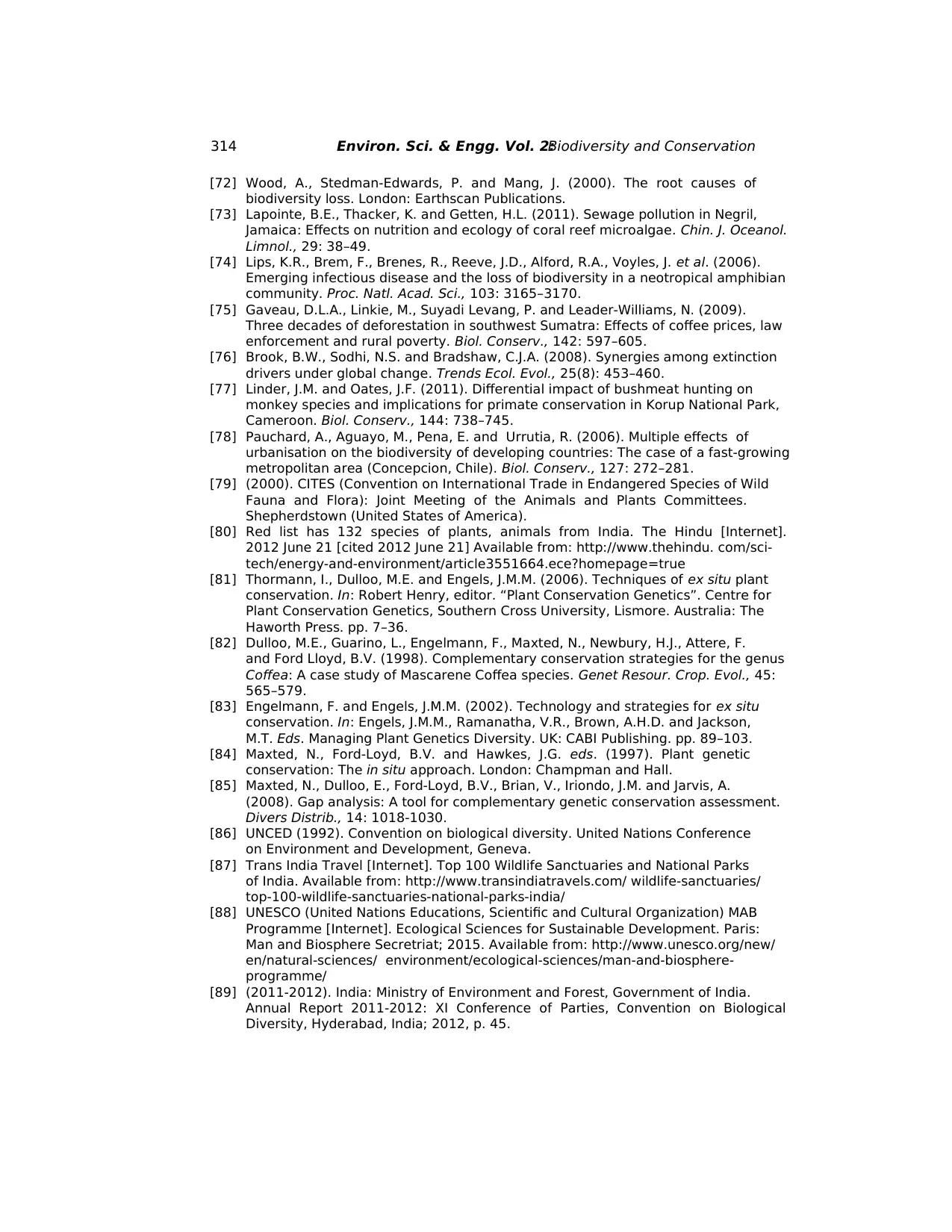
314 Environ. Sci. & Engg. Vol. 2:Biodiversity and Conservation
[72] Wood, A., Stedman-Edwards, P. and Mang, J. (2000). The root causes of
biodiversity loss. London: Earthscan Publications.
[73] Lapointe, B.E., Thacker, K. and Getten, H.L. (2011). Sewage pollution in Negril,
Jamaica: Effects on nutrition and ecology of coral reef microalgae. Chin. J. Oceanol.
Limnol., 29: 38–49.
[74] Lips, K.R., Brem, F., Brenes, R., Reeve, J.D., Alford, R.A., Voyles, J. et al. (2006).
Emerging infectious disease and the loss of biodiversity in a neotropical amphibian
community. Proc. Natl. Acad. Sci., 103: 3165–3170.
[75] Gaveau, D.L.A., Linkie, M., Suyadi Levang, P. and Leader-Williams, N. (2009).
Three decades of deforestation in southwest Sumatra: Effects of coffee prices, law
enforcement and rural poverty. Biol. Conserv., 142: 597–605.
[76] Brook, B.W., Sodhi, N.S. and Bradshaw, C.J.A. (2008). Synergies among extinction
drivers under global change. Trends Ecol. Evol., 25(8): 453–460.
[77] Linder, J.M. and Oates, J.F. (2011). Differential impact of bushmeat hunting on
monkey species and implications for primate conservation in Korup National Park,
Cameroon. Biol. Conserv., 144: 738–745.
[78] Pauchard, A., Aguayo, M., Pena, E. and Urrutia, R. (2006). Multiple effects of
urbanisation on the biodiversity of developing countries: The case of a fast-growing
metropolitan area (Concepcion, Chile). Biol. Conserv., 127: 272–281.
[79] (2000). CITES (Convention on International Trade in Endangered Species of Wild
Fauna and Flora): Joint Meeting of the Animals and Plants Committees.
Shepherdstown (United States of America).
[80] Red list has 132 species of plants, animals from India. The Hindu [Internet].
2012 June 21 [cited 2012 June 21] Available from: http://www.thehindu. com/sci-
tech/energy-and-environment/article3551664.ece?homepage=true
[81] Thormann, I., Dulloo, M.E. and Engels, J.M.M. (2006). Techniques of ex situ plant
conservation. In: Robert Henry, editor. “Plant Conservation Genetics”. Centre for
Plant Conservation Genetics, Southern Cross University, Lismore. Australia: The
Haworth Press. pp. 7–36.
[82] Dulloo, M.E., Guarino, L., Engelmann, F., Maxted, N., Newbury, H.J., Attere, F.
and Ford Lloyd, B.V. (1998). Complementary conservation strategies for the genus
Coffea: A case study of Mascarene Coffea species. Genet Resour. Crop. Evol., 45:
565–579.
[83] Engelmann, F. and Engels, J.M.M. (2002). Technology and strategies for ex situ
conservation. In: Engels, J.M.M., Ramanatha, V.R., Brown, A.H.D. and Jackson,
M.T. Eds. Managing Plant Genetics Diversity. UK: CABI Publishing. pp. 89–103.
[84] Maxted, N., Ford-Loyd, B.V. and Hawkes, J.G. eds. (1997). Plant genetic
conservation: The in situ approach. London: Champman and Hall.
[85] Maxted, N., Dulloo, E., Ford-Loyd, B.V., Brian, V., Iriondo, J.M. and Jarvis, A.
(2008). Gap analysis: A tool for complementary genetic conservation assessment.
Divers Distrib., 14: 1018-1030.
[86] UNCED (1992). Convention on biological diversity. United Nations Conference
on Environment and Development, Geneva.
[87] Trans India Travel [Internet]. Top 100 Wildlife Sanctuaries and National Parks
of India. Available from: http://www.transindiatravels.com/ wildlife-sanctuaries/
top-100-wildlife-sanctuaries-national-parks-india/
[88] UNESCO (United Nations Educations, Scientific and Cultural Organization) MAB
Programme [Internet]. Ecological Sciences for Sustainable Development. Paris:
Man and Biosphere Secretriat; 2015. Available from: http://www.unesco.org/new/
en/natural-sciences/ environment/ecological-sciences/man-and-biosphere-
programme/
[89] (2011-2012). India: Ministry of Environment and Forest, Government of India.
Annual Report 2011-2012: XI Conference of Parties, Convention on Biological
Diversity, Hyderabad, India; 2012, p. 45.
[72] Wood, A., Stedman-Edwards, P. and Mang, J. (2000). The root causes of
biodiversity loss. London: Earthscan Publications.
[73] Lapointe, B.E., Thacker, K. and Getten, H.L. (2011). Sewage pollution in Negril,
Jamaica: Effects on nutrition and ecology of coral reef microalgae. Chin. J. Oceanol.
Limnol., 29: 38–49.
[74] Lips, K.R., Brem, F., Brenes, R., Reeve, J.D., Alford, R.A., Voyles, J. et al. (2006).
Emerging infectious disease and the loss of biodiversity in a neotropical amphibian
community. Proc. Natl. Acad. Sci., 103: 3165–3170.
[75] Gaveau, D.L.A., Linkie, M., Suyadi Levang, P. and Leader-Williams, N. (2009).
Three decades of deforestation in southwest Sumatra: Effects of coffee prices, law
enforcement and rural poverty. Biol. Conserv., 142: 597–605.
[76] Brook, B.W., Sodhi, N.S. and Bradshaw, C.J.A. (2008). Synergies among extinction
drivers under global change. Trends Ecol. Evol., 25(8): 453–460.
[77] Linder, J.M. and Oates, J.F. (2011). Differential impact of bushmeat hunting on
monkey species and implications for primate conservation in Korup National Park,
Cameroon. Biol. Conserv., 144: 738–745.
[78] Pauchard, A., Aguayo, M., Pena, E. and Urrutia, R. (2006). Multiple effects of
urbanisation on the biodiversity of developing countries: The case of a fast-growing
metropolitan area (Concepcion, Chile). Biol. Conserv., 127: 272–281.
[79] (2000). CITES (Convention on International Trade in Endangered Species of Wild
Fauna and Flora): Joint Meeting of the Animals and Plants Committees.
Shepherdstown (United States of America).
[80] Red list has 132 species of plants, animals from India. The Hindu [Internet].
2012 June 21 [cited 2012 June 21] Available from: http://www.thehindu. com/sci-
tech/energy-and-environment/article3551664.ece?homepage=true
[81] Thormann, I., Dulloo, M.E. and Engels, J.M.M. (2006). Techniques of ex situ plant
conservation. In: Robert Henry, editor. “Plant Conservation Genetics”. Centre for
Plant Conservation Genetics, Southern Cross University, Lismore. Australia: The
Haworth Press. pp. 7–36.
[82] Dulloo, M.E., Guarino, L., Engelmann, F., Maxted, N., Newbury, H.J., Attere, F.
and Ford Lloyd, B.V. (1998). Complementary conservation strategies for the genus
Coffea: A case study of Mascarene Coffea species. Genet Resour. Crop. Evol., 45:
565–579.
[83] Engelmann, F. and Engels, J.M.M. (2002). Technology and strategies for ex situ
conservation. In: Engels, J.M.M., Ramanatha, V.R., Brown, A.H.D. and Jackson,
M.T. Eds. Managing Plant Genetics Diversity. UK: CABI Publishing. pp. 89–103.
[84] Maxted, N., Ford-Loyd, B.V. and Hawkes, J.G. eds. (1997). Plant genetic
conservation: The in situ approach. London: Champman and Hall.
[85] Maxted, N., Dulloo, E., Ford-Loyd, B.V., Brian, V., Iriondo, J.M. and Jarvis, A.
(2008). Gap analysis: A tool for complementary genetic conservation assessment.
Divers Distrib., 14: 1018-1030.
[86] UNCED (1992). Convention on biological diversity. United Nations Conference
on Environment and Development, Geneva.
[87] Trans India Travel [Internet]. Top 100 Wildlife Sanctuaries and National Parks
of India. Available from: http://www.transindiatravels.com/ wildlife-sanctuaries/
top-100-wildlife-sanctuaries-national-parks-india/
[88] UNESCO (United Nations Educations, Scientific and Cultural Organization) MAB
Programme [Internet]. Ecological Sciences for Sustainable Development. Paris:
Man and Biosphere Secretriat; 2015. Available from: http://www.unesco.org/new/
en/natural-sciences/ environment/ecological-sciences/man-and-biosphere-
programme/
[89] (2011-2012). India: Ministry of Environment and Forest, Government of India.
Annual Report 2011-2012: XI Conference of Parties, Convention on Biological
Diversity, Hyderabad, India; 2012, p. 45.
Secure Best Marks with AI Grader
Need help grading? Try our AI Grader for instant feedback on your assignments.
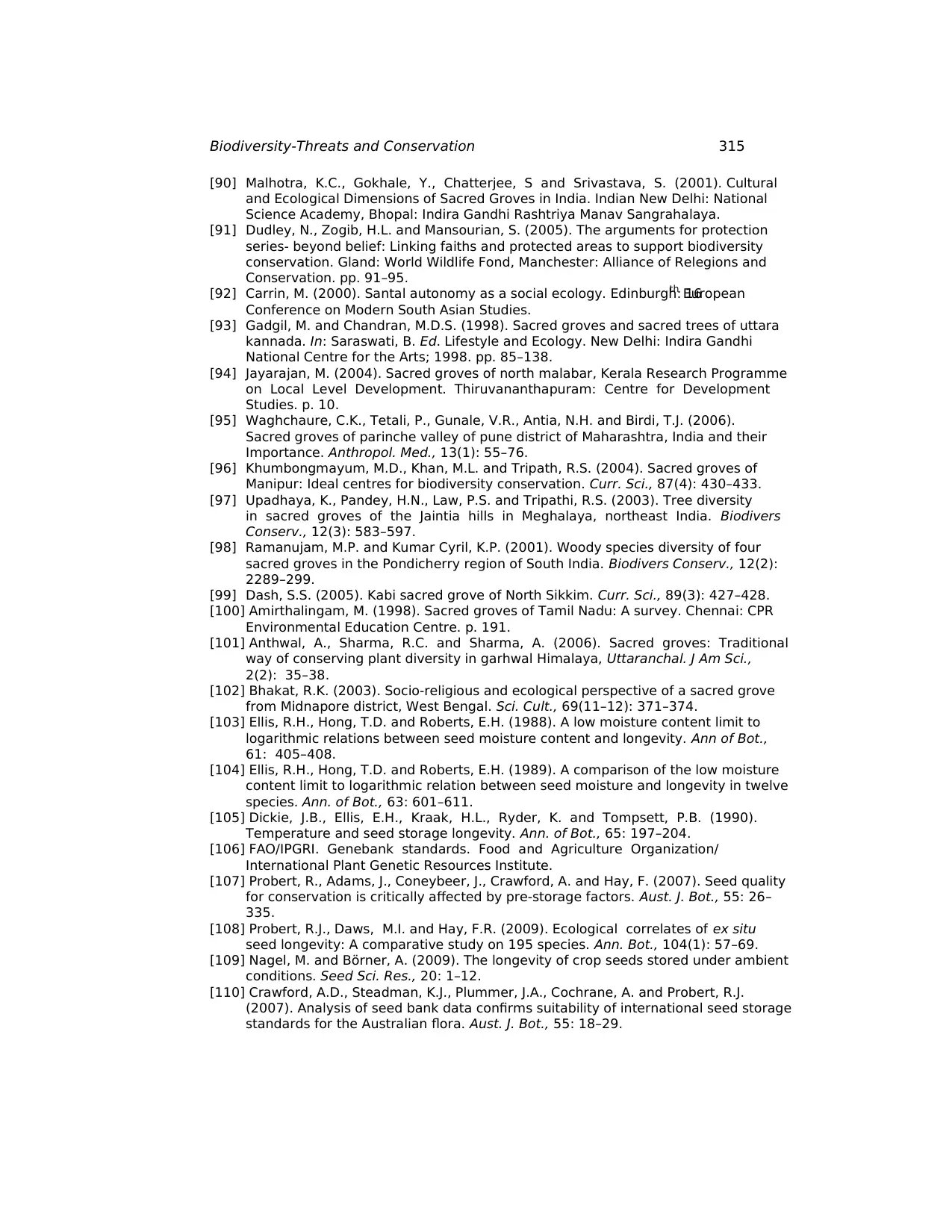
315Biodiversity-Threats and Conservation
[90] Malhotra, K.C., Gokhale, Y., Chatterjee, S and Srivastava, S. (2001). Cultural
and Ecological Dimensions of Sacred Groves in India. Indian New Delhi: National
Science Academy, Bhopal: Indira Gandhi Rashtriya Manav Sangrahalaya.
[91] Dudley, N., Zogib, H.L. and Mansourian, S. (2005). The arguments for protection
series- beyond belief: Linking faiths and protected areas to support biodiversity
conservation. Gland: World Wildlife Fond, Manchester: Alliance of Relegions and
Conservation. pp. 91–95.
[92] Carrin, M. (2000). Santal autonomy as a social ecology. Edinburgh: 16th European
Conference on Modern South Asian Studies.
[93] Gadgil, M. and Chandran, M.D.S. (1998). Sacred groves and sacred trees of uttara
kannada. In: Saraswati, B. Ed. Lifestyle and Ecology. New Delhi: Indira Gandhi
National Centre for the Arts; 1998. pp. 85–138.
[94] Jayarajan, M. (2004). Sacred groves of north malabar, Kerala Research Programme
on Local Level Development. Thiruvananthapuram: Centre for Development
Studies. p. 10.
[95] Waghchaure, C.K., Tetali, P., Gunale, V.R., Antia, N.H. and Birdi, T.J. (2006).
Sacred groves of parinche valley of pune district of Maharashtra, India and their
Importance. Anthropol. Med., 13(1): 55–76.
[96] Khumbongmayum, M.D., Khan, M.L. and Tripath, R.S. (2004). Sacred groves of
Manipur: Ideal centres for biodiversity conservation. Curr. Sci., 87(4): 430–433.
[97] Upadhaya, K., Pandey, H.N., Law, P.S. and Tripathi, R.S. (2003). Tree diversity
in sacred groves of the Jaintia hills in Meghalaya, northeast India. Biodivers
Conserv., 12(3): 583–597.
[98] Ramanujam, M.P. and Kumar Cyril, K.P. (2001). Woody species diversity of four
sacred groves in the Pondicherry region of South India. Biodivers Conserv., 12(2):
2289–299.
[99] Dash, S.S. (2005). Kabi sacred grove of North Sikkim. Curr. Sci., 89(3): 427–428.
[100] Amirthalingam, M. (1998). Sacred groves of Tamil Nadu: A survey. Chennai: CPR
Environmental Education Centre. p. 191.
[101] Anthwal, A., Sharma, R.C. and Sharma, A. (2006). Sacred groves: Traditional
way of conserving plant diversity in garhwal Himalaya, Uttaranchal. J Am Sci.,
2(2): 35–38.
[102] Bhakat, R.K. (2003). Socio-religious and ecological perspective of a sacred grove
from Midnapore district, West Bengal. Sci. Cult., 69(11–12): 371–374.
[103] Ellis, R.H., Hong, T.D. and Roberts, E.H. (1988). A low moisture content limit to
logarithmic relations between seed moisture content and longevity. Ann of Bot.,
61: 405–408.
[104] Ellis, R.H., Hong, T.D. and Roberts, E.H. (1989). A comparison of the low moisture
content limit to logarithmic relation between seed moisture and longevity in twelve
species. Ann. of Bot., 63: 601–611.
[105] Dickie, J.B., Ellis, E.H., Kraak, H.L., Ryder, K. and Tompsett, P.B. (1990).
Temperature and seed storage longevity. Ann. of Bot., 65: 197–204.
[106] FAO/IPGRI. Genebank standards. Food and Agriculture Organization/
International Plant Genetic Resources Institute.
[107] Probert, R., Adams, J., Coneybeer, J., Crawford, A. and Hay, F. (2007). Seed quality
for conservation is critically affected by pre-storage factors. Aust. J. Bot., 55: 26–
335.
[108] Probert, R.J., Daws, M.I. and Hay, F.R. (2009). Ecological correlates of ex situ
seed longevity: A comparative study on 195 species. Ann. Bot., 104(1): 57–69.
[109] Nagel, M. and Börner, A. (2009). The longevity of crop seeds stored under ambient
conditions. Seed Sci. Res., 20: 1–12.
[110] Crawford, A.D., Steadman, K.J., Plummer, J.A., Cochrane, A. and Probert, R.J.
(2007). Analysis of seed bank data confirms suitability of international seed storage
standards for the Australian flora. Aust. J. Bot., 55: 18–29.
[90] Malhotra, K.C., Gokhale, Y., Chatterjee, S and Srivastava, S. (2001). Cultural
and Ecological Dimensions of Sacred Groves in India. Indian New Delhi: National
Science Academy, Bhopal: Indira Gandhi Rashtriya Manav Sangrahalaya.
[91] Dudley, N., Zogib, H.L. and Mansourian, S. (2005). The arguments for protection
series- beyond belief: Linking faiths and protected areas to support biodiversity
conservation. Gland: World Wildlife Fond, Manchester: Alliance of Relegions and
Conservation. pp. 91–95.
[92] Carrin, M. (2000). Santal autonomy as a social ecology. Edinburgh: 16th European
Conference on Modern South Asian Studies.
[93] Gadgil, M. and Chandran, M.D.S. (1998). Sacred groves and sacred trees of uttara
kannada. In: Saraswati, B. Ed. Lifestyle and Ecology. New Delhi: Indira Gandhi
National Centre for the Arts; 1998. pp. 85–138.
[94] Jayarajan, M. (2004). Sacred groves of north malabar, Kerala Research Programme
on Local Level Development. Thiruvananthapuram: Centre for Development
Studies. p. 10.
[95] Waghchaure, C.K., Tetali, P., Gunale, V.R., Antia, N.H. and Birdi, T.J. (2006).
Sacred groves of parinche valley of pune district of Maharashtra, India and their
Importance. Anthropol. Med., 13(1): 55–76.
[96] Khumbongmayum, M.D., Khan, M.L. and Tripath, R.S. (2004). Sacred groves of
Manipur: Ideal centres for biodiversity conservation. Curr. Sci., 87(4): 430–433.
[97] Upadhaya, K., Pandey, H.N., Law, P.S. and Tripathi, R.S. (2003). Tree diversity
in sacred groves of the Jaintia hills in Meghalaya, northeast India. Biodivers
Conserv., 12(3): 583–597.
[98] Ramanujam, M.P. and Kumar Cyril, K.P. (2001). Woody species diversity of four
sacred groves in the Pondicherry region of South India. Biodivers Conserv., 12(2):
2289–299.
[99] Dash, S.S. (2005). Kabi sacred grove of North Sikkim. Curr. Sci., 89(3): 427–428.
[100] Amirthalingam, M. (1998). Sacred groves of Tamil Nadu: A survey. Chennai: CPR
Environmental Education Centre. p. 191.
[101] Anthwal, A., Sharma, R.C. and Sharma, A. (2006). Sacred groves: Traditional
way of conserving plant diversity in garhwal Himalaya, Uttaranchal. J Am Sci.,
2(2): 35–38.
[102] Bhakat, R.K. (2003). Socio-religious and ecological perspective of a sacred grove
from Midnapore district, West Bengal. Sci. Cult., 69(11–12): 371–374.
[103] Ellis, R.H., Hong, T.D. and Roberts, E.H. (1988). A low moisture content limit to
logarithmic relations between seed moisture content and longevity. Ann of Bot.,
61: 405–408.
[104] Ellis, R.H., Hong, T.D. and Roberts, E.H. (1989). A comparison of the low moisture
content limit to logarithmic relation between seed moisture and longevity in twelve
species. Ann. of Bot., 63: 601–611.
[105] Dickie, J.B., Ellis, E.H., Kraak, H.L., Ryder, K. and Tompsett, P.B. (1990).
Temperature and seed storage longevity. Ann. of Bot., 65: 197–204.
[106] FAO/IPGRI. Genebank standards. Food and Agriculture Organization/
International Plant Genetic Resources Institute.
[107] Probert, R., Adams, J., Coneybeer, J., Crawford, A. and Hay, F. (2007). Seed quality
for conservation is critically affected by pre-storage factors. Aust. J. Bot., 55: 26–
335.
[108] Probert, R.J., Daws, M.I. and Hay, F.R. (2009). Ecological correlates of ex situ
seed longevity: A comparative study on 195 species. Ann. Bot., 104(1): 57–69.
[109] Nagel, M. and Börner, A. (2009). The longevity of crop seeds stored under ambient
conditions. Seed Sci. Res., 20: 1–12.
[110] Crawford, A.D., Steadman, K.J., Plummer, J.A., Cochrane, A. and Probert, R.J.
(2007). Analysis of seed bank data confirms suitability of international seed storage
standards for the Australian flora. Aust. J. Bot., 55: 18–29.
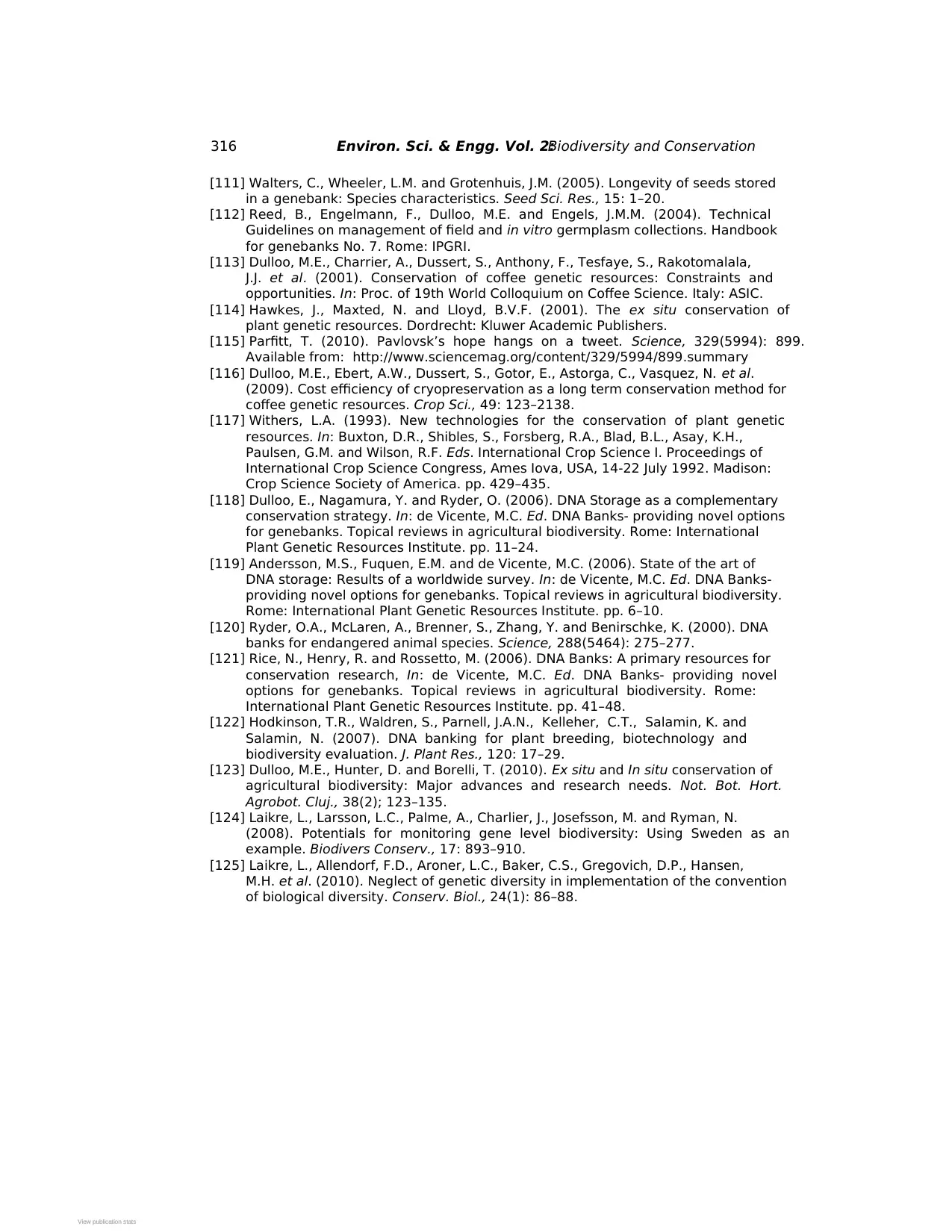
316 Environ. Sci. & Engg. Vol. 2:Biodiversity and Conservation
[111] Walters, C., Wheeler, L.M. and Grotenhuis, J.M. (2005). Longevity of seeds stored
in a genebank: Species characteristics. Seed Sci. Res., 15: 1–20.
[112] Reed, B., Engelmann, F., Dulloo, M.E. and Engels, J.M.M. (2004). Technical
Guidelines on management of field and in vitro germplasm collections. Handbook
for genebanks No. 7. Rome: IPGRI.
[113] Dulloo, M.E., Charrier, A., Dussert, S., Anthony, F., Tesfaye, S., Rakotomalala,
J.J. et al. (2001). Conservation of coffee genetic resources: Constraints and
opportunities. In: Proc. of 19th World Colloquium on Coffee Science. Italy: ASIC.
[114] Hawkes, J., Maxted, N. and Lloyd, B.V.F. (2001). The ex situ conservation of
plant genetic resources. Dordrecht: Kluwer Academic Publishers.
[115] Parfitt, T. (2010). Pavlovsk’s hope hangs on a tweet. Science, 329(5994): 899.
Available from: http://www.sciencemag.org/content/329/5994/899.summary
[116] Dulloo, M.E., Ebert, A.W., Dussert, S., Gotor, E., Astorga, C., Vasquez, N. et al.
(2009). Cost efficiency of cryopreservation as a long term conservation method for
coffee genetic resources. Crop Sci., 49: 123–2138.
[117] Withers, L.A. (1993). New technologies for the conservation of plant genetic
resources. In: Buxton, D.R., Shibles, S., Forsberg, R.A., Blad, B.L., Asay, K.H.,
Paulsen, G.M. and Wilson, R.F. Eds. International Crop Science I. Proceedings of
International Crop Science Congress, Ames Iova, USA, 14-22 July 1992. Madison:
Crop Science Society of America. pp. 429–435.
[118] Dulloo, E., Nagamura, Y. and Ryder, O. (2006). DNA Storage as a complementary
conservation strategy. In: de Vicente, M.C. Ed. DNA Banks- providing novel options
for genebanks. Topical reviews in agricultural biodiversity. Rome: International
Plant Genetic Resources Institute. pp. 11–24.
[119] Andersson, M.S., Fuquen, E.M. and de Vicente, M.C. (2006). State of the art of
DNA storage: Results of a worldwide survey. In: de Vicente, M.C. Ed. DNA Banks-
providing novel options for genebanks. Topical reviews in agricultural biodiversity.
Rome: International Plant Genetic Resources Institute. pp. 6–10.
[120] Ryder, O.A., McLaren, A., Brenner, S., Zhang, Y. and Benirschke, K. (2000). DNA
banks for endangered animal species. Science, 288(5464): 275–277.
[121] Rice, N., Henry, R. and Rossetto, M. (2006). DNA Banks: A primary resources for
conservation research, In: de Vicente, M.C. Ed. DNA Banks- providing novel
options for genebanks. Topical reviews in agricultural biodiversity. Rome:
International Plant Genetic Resources Institute. pp. 41–48.
[122] Hodkinson, T.R., Waldren, S., Parnell, J.A.N., Kelleher, C.T., Salamin, K. and
Salamin, N. (2007). DNA banking for plant breeding, biotechnology and
biodiversity evaluation. J. Plant Res., 120: 17–29.
[123] Dulloo, M.E., Hunter, D. and Borelli, T. (2010). Ex situ and In situ conservation of
agricultural biodiversity: Major advances and research needs. Not. Bot. Hort.
Agrobot. Cluj., 38(2); 123–135.
[124] Laikre, L., Larsson, L.C., Palme, A., Charlier, J., Josefsson, M. and Ryman, N.
(2008). Potentials for monitoring gene level biodiversity: Using Sweden as an
example. Biodivers Conserv., 17: 893–910.
[125] Laikre, L., Allendorf, F.D., Aroner, L.C., Baker, C.S., Gregovich, D.P., Hansen,
M.H. et al. (2010). Neglect of genetic diversity in implementation of the convention
of biological diversity. Conserv. Biol., 24(1): 86–88.
View publication statsView publication stats
[111] Walters, C., Wheeler, L.M. and Grotenhuis, J.M. (2005). Longevity of seeds stored
in a genebank: Species characteristics. Seed Sci. Res., 15: 1–20.
[112] Reed, B., Engelmann, F., Dulloo, M.E. and Engels, J.M.M. (2004). Technical
Guidelines on management of field and in vitro germplasm collections. Handbook
for genebanks No. 7. Rome: IPGRI.
[113] Dulloo, M.E., Charrier, A., Dussert, S., Anthony, F., Tesfaye, S., Rakotomalala,
J.J. et al. (2001). Conservation of coffee genetic resources: Constraints and
opportunities. In: Proc. of 19th World Colloquium on Coffee Science. Italy: ASIC.
[114] Hawkes, J., Maxted, N. and Lloyd, B.V.F. (2001). The ex situ conservation of
plant genetic resources. Dordrecht: Kluwer Academic Publishers.
[115] Parfitt, T. (2010). Pavlovsk’s hope hangs on a tweet. Science, 329(5994): 899.
Available from: http://www.sciencemag.org/content/329/5994/899.summary
[116] Dulloo, M.E., Ebert, A.W., Dussert, S., Gotor, E., Astorga, C., Vasquez, N. et al.
(2009). Cost efficiency of cryopreservation as a long term conservation method for
coffee genetic resources. Crop Sci., 49: 123–2138.
[117] Withers, L.A. (1993). New technologies for the conservation of plant genetic
resources. In: Buxton, D.R., Shibles, S., Forsberg, R.A., Blad, B.L., Asay, K.H.,
Paulsen, G.M. and Wilson, R.F. Eds. International Crop Science I. Proceedings of
International Crop Science Congress, Ames Iova, USA, 14-22 July 1992. Madison:
Crop Science Society of America. pp. 429–435.
[118] Dulloo, E., Nagamura, Y. and Ryder, O. (2006). DNA Storage as a complementary
conservation strategy. In: de Vicente, M.C. Ed. DNA Banks- providing novel options
for genebanks. Topical reviews in agricultural biodiversity. Rome: International
Plant Genetic Resources Institute. pp. 11–24.
[119] Andersson, M.S., Fuquen, E.M. and de Vicente, M.C. (2006). State of the art of
DNA storage: Results of a worldwide survey. In: de Vicente, M.C. Ed. DNA Banks-
providing novel options for genebanks. Topical reviews in agricultural biodiversity.
Rome: International Plant Genetic Resources Institute. pp. 6–10.
[120] Ryder, O.A., McLaren, A., Brenner, S., Zhang, Y. and Benirschke, K. (2000). DNA
banks for endangered animal species. Science, 288(5464): 275–277.
[121] Rice, N., Henry, R. and Rossetto, M. (2006). DNA Banks: A primary resources for
conservation research, In: de Vicente, M.C. Ed. DNA Banks- providing novel
options for genebanks. Topical reviews in agricultural biodiversity. Rome:
International Plant Genetic Resources Institute. pp. 41–48.
[122] Hodkinson, T.R., Waldren, S., Parnell, J.A.N., Kelleher, C.T., Salamin, K. and
Salamin, N. (2007). DNA banking for plant breeding, biotechnology and
biodiversity evaluation. J. Plant Res., 120: 17–29.
[123] Dulloo, M.E., Hunter, D. and Borelli, T. (2010). Ex situ and In situ conservation of
agricultural biodiversity: Major advances and research needs. Not. Bot. Hort.
Agrobot. Cluj., 38(2); 123–135.
[124] Laikre, L., Larsson, L.C., Palme, A., Charlier, J., Josefsson, M. and Ryman, N.
(2008). Potentials for monitoring gene level biodiversity: Using Sweden as an
example. Biodivers Conserv., 17: 893–910.
[125] Laikre, L., Allendorf, F.D., Aroner, L.C., Baker, C.S., Gregovich, D.P., Hansen,
M.H. et al. (2010). Neglect of genetic diversity in implementation of the convention
of biological diversity. Conserv. Biol., 24(1): 86–88.
View publication statsView publication stats
1 out of 36
Related Documents
Your All-in-One AI-Powered Toolkit for Academic Success.
+13062052269
info@desklib.com
Available 24*7 on WhatsApp / Email
![[object Object]](/_next/static/media/star-bottom.7253800d.svg)
Unlock your academic potential
© 2024 | Zucol Services PVT LTD | All rights reserved.
